




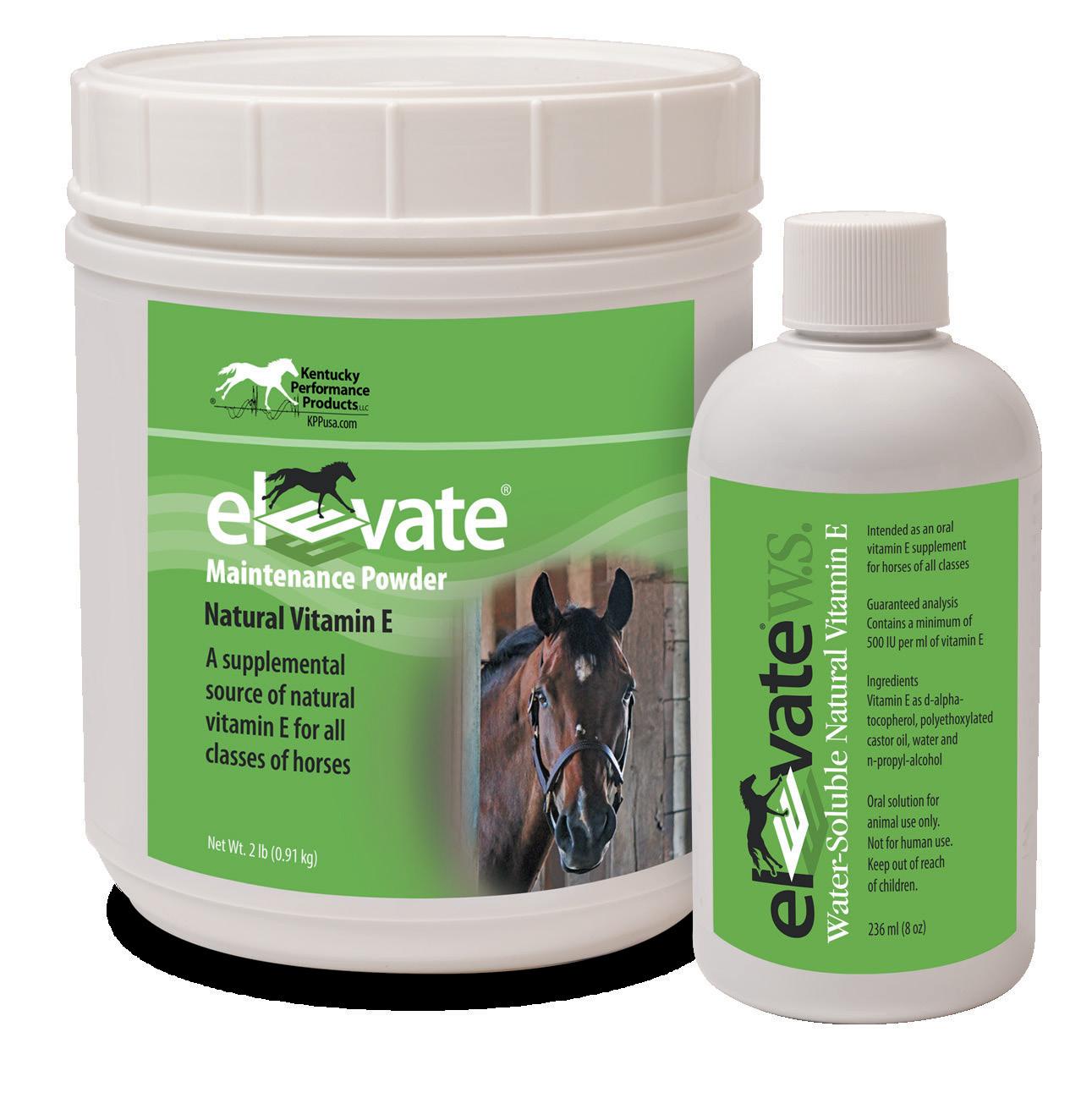
•


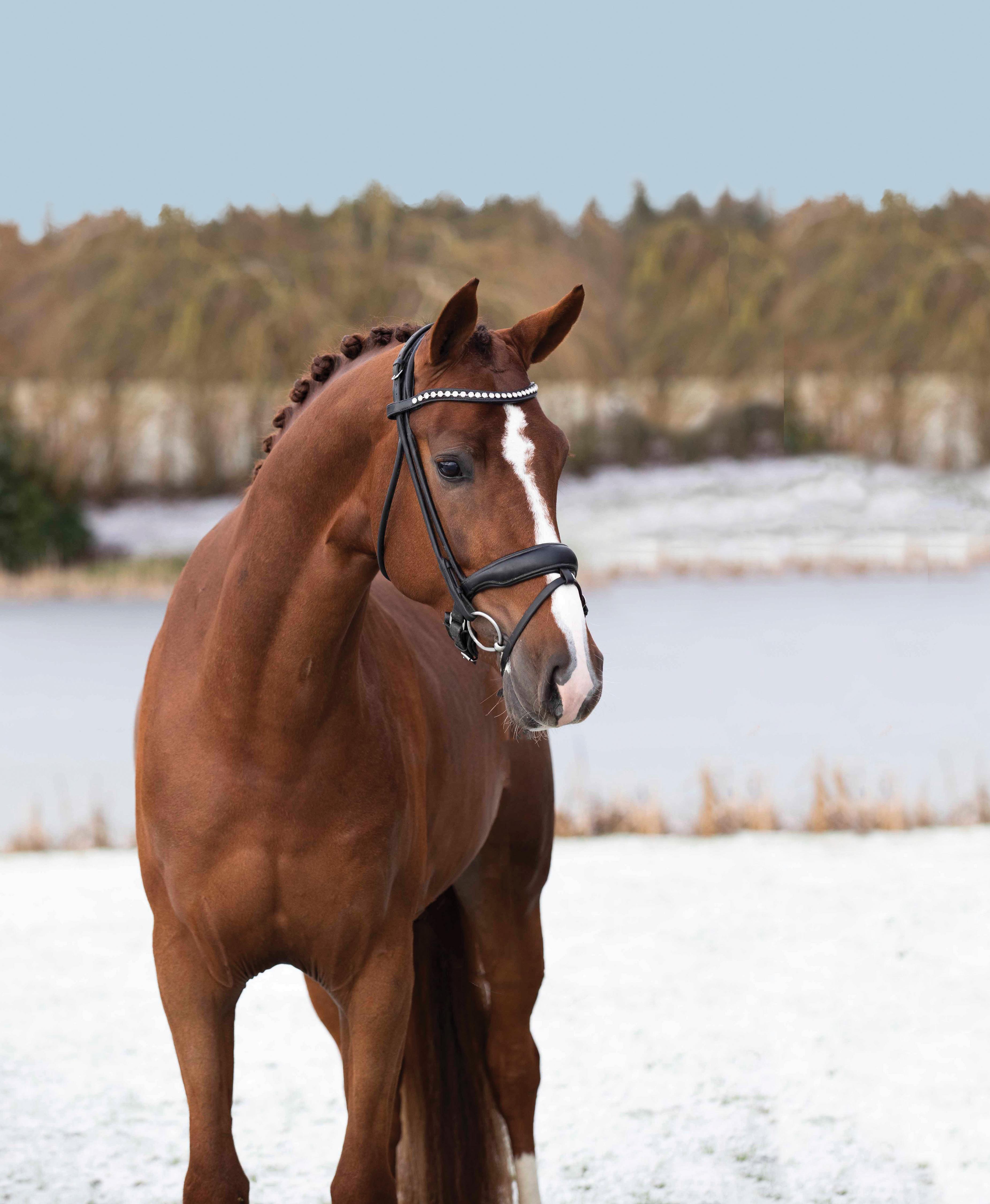
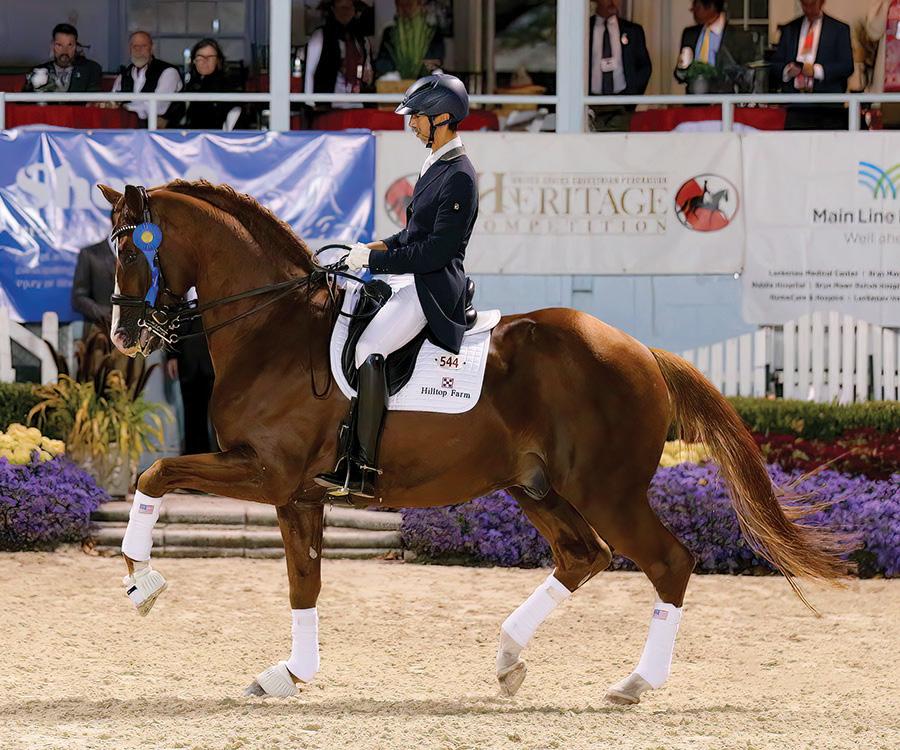


An official property of the United States Dressage Federation
YourDressage delivers exclusive dressage stories, editorial, and education, relevant to ALL dressage enthusiasts and is your daily source for dressage!
Look for these featured articles online at YourDressage.org
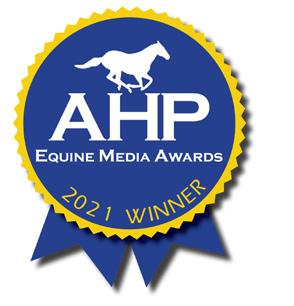
“Sneak Preview of the New On the Levels”
Go behind the scenes at the filming of the new US dressage tests, which will be in effect for the next four years.
“US Dressage Finals presented Adequan®: Recap & Results”
Find out who was awarded the perpetual trophies, the results from the Regions Cup, and see our full coverage from the event, all in one place!
JrYR Erin Nichols took the world by storm this year, earning two gold medals and one silver at NAYC. Get to know her in our exclusive Q&A.
A Region 3 rider shares about earning all her rider awards and freestyle bars with one horse, all before the age of 21.
It’s YourDressage, be a part of it! Visit https://yourdressage.org/ for all these stories & much more!
Official Publication of the United States Dressage Federation
EXECUTIVE DIRECTOR Stephan Hienzsch (859) 271-7887 • stephh1enz@usdf.org
EDITOR Jennifer O. Bryant (610) 344-0116 • jbryant@usdf.org
CONTRIBUTING EDITOR Hilary M. Clayton, BVMS, PhD, MRCVS
EDITORIAL ADVISORS Margaret Freeman (NC), Anne Gribbons (FL), Roberta Williams (FL), Terry Wilson (CA) TECHNICAL ADVISORS Janine Malone, Lisa Gorretta, Elisabeth Williams
SENIOR PUBLICATIONS COORDINATOR Emily Koenig (859) 271-7883 • ekoenig@usdf.org
GRAPHIC & MULTIMEDIA COORDINATOR Katie Lewis (859) 271-7881 • klewis@usdf.org
ADVERTISING SALES REPRESENTATIVE Danielle Titland (720) 300-2266 • dtitland@usdf.org
PRESIDENT GEORGE WILLIAMS 421 Park Forest Way, Wellington, FL 33414 (937) 603-9134 • president@usdf.org
VICE PRESIDENT KEVIN REINIG, 6907 Lindero Lane, Rancho Murieta, CA 95683 (916) 616-4581 • vicepresident@usdf.org
SECRETARY DEBRA REINHARDT 16305 63rd Road N, Loxahatchee, FL 33470 (203) 264-2148 • secretary@usdf.org
TREASURER LORRAINE MUSSELMAN 7538 NC 39 Hwy, Zebulon, NC 27497 (919) 218-6802 • treasurer@usdf.org
REGION 1 DC, DE, MD, NC, NJ, PA, VA BETTINA G. LONGAKER 8246 Open Gate Road, Gordonsville, VA 22942 (540) 832-7611 • region1dir@usdf.org
REGION 2 IL, IN, KY, MI, OH, WV, WI DEBBY SAVAGE 7011 Cobblestone Lane, Mentor, OH 44060 (908) 892-5335 • region2dir@usdf.org
REGION 3 AL, FL, GA, SC, TN CHARLOTTE TRENTELMAN P.O. Box 381, Anthony, FL 32617 (352) 598-7704 • region3dir@usdf.org
REGION 4 IA, KS, MN, MO, NE, ND, SD ANNE SUSHKO 1942 Clifford Street, Dubuque, IA 52002 (563) 580-0510 • region4dir@usdf.org
REGION 5 AZ, CO, E. MT, NM, UT, W. TX, WY HEATHER PETERSEN 22750 County Road 37, Elbert, CO 80106 (303) 648-3164 • region5dir@usdf.org
REGION 6 AK, ID, W. MT, OR, WA NOAH RATTNER 25033 SW Pacific Hwy, Sherwood, OR 97140 (503) 449-1274 • region6dir@usdf.org REGION 7 CA, HI, NV CAROL TICE 31895 Nicolas Road, Temecula, CA 92591 (714) 514-5606 • region7dir@usdf.org
REGION 8 CT, MA, ME, NH, NY, RI, VT
HELEN VAN DER VOORT 8 Boulevard West, PH4, Pelham, NY 10803 (917) 834-2635 • region8dir@usdf.org
REGION 9 AR, LA, MS, OK, TX
BESS BRUTON 5696 Piper Lane, College Station, TX 77845 (662) 702-9854 • region9dir@usdf.org
ACTIVITIES COUNCIL
SUE MANDAS 9508 Bridlewood Trail, Dayton, OH 45458 (937) 272-9068 • ald-activities@usdf.org
ADMINISTRATIVE COUNCIL
BARBARA CADWELL 324 Benjamin Street, Fernandina Beach, FL (715) 350 1967 • ald-administrative@usdf.org
TECHNICAL COUNCIL
SUE MCKEOWN 6 Whitehaven Lane, Worcester, MA 01609 (508) 459-9209 • ald-technical@usdf.org
USDF Connection is published bimonthly by the United States Dressage Federation, 4051 Iron Works Parkway, Lexington, KY 40511. Phone: 859/971-2277. Fax: 859/971-7722. E-mail: usdressage@usdf.org, Web site: www. usdf.org. USDF members receive USDF Connection as a membership benefit, paid by membership dues.
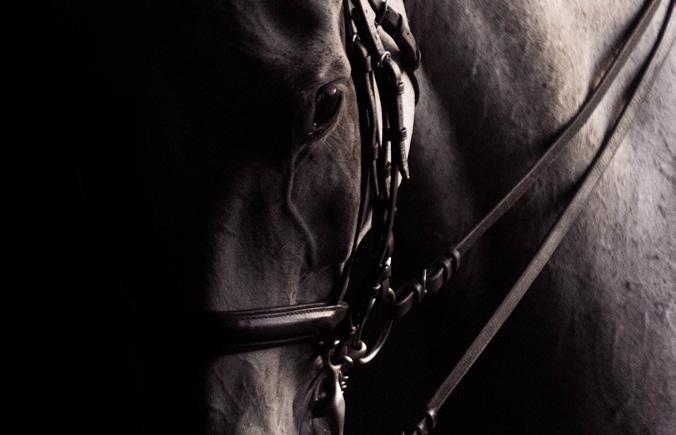
Copyright © 2023 USDF. All rights reserved.
USDF reserves the right to refuse any advertising or copy that is deemed unsuitable for USDF and its policies. Excluding advertisements, all photos with mounted riders must have safety head gear or USEF-approved competition hat. USDF assumes no responsibility for the claims made in advertisements. Statements of fact and opinion are those of the experts consulted and authors, and do not necessarily reflect the opinions of the editors or the policy of USDF.
The publishers reserve the right to reject any advertising deemed unsuitable for USDF, as well as the right to reject or edit any manuscripts received for publication. USDF assumes no responsibility for unsolicited material. All materials must be accompanied by a self-addressed, stamped envelope.
Questions about your subscription or change in address? Contact USDF Membership Department, 859/971-2277, or usdressage@usdf.org.
POSTMASTER: SEND ADDRESS CHANGES TO: USDF, 4051 IRON WORKS PARKWAY, LEXINGTON, KY 40511. Canadian Agreement No. 1741527. Canada return address: Station A, P.O. Box 54, Windsor, Ontario N9A 6J5.

















































Many things in the USDF have changed. One that hasn’t: the need for volunteers.
By Margaret Freeman, Immediate Past USDF Secretary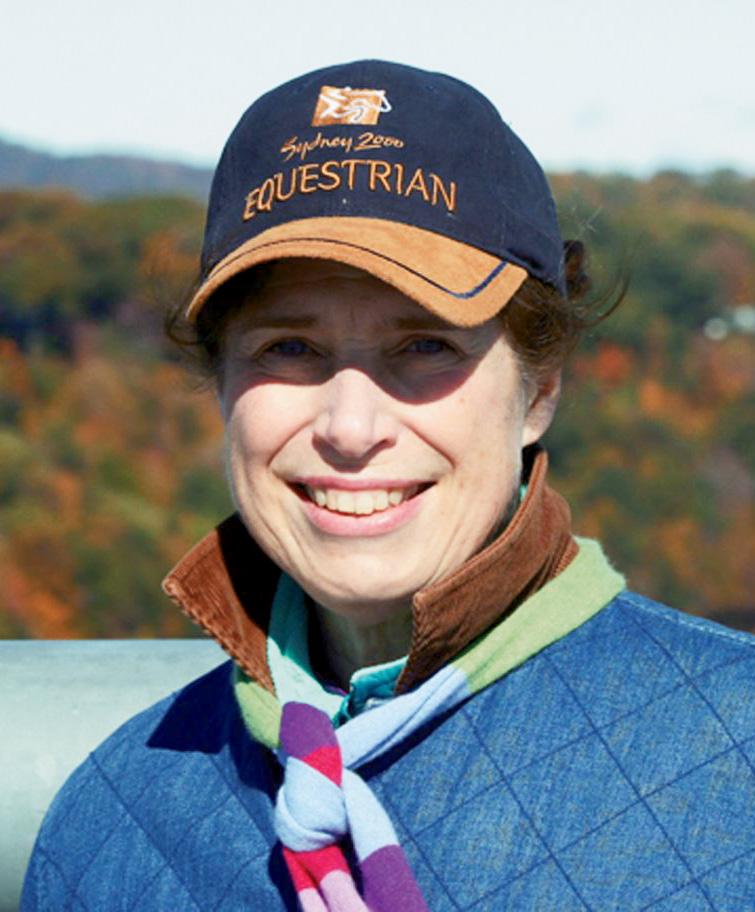
The USDF turns 50 years old in 2023, and I’ve been there for all of them, although I didn’t realize it at the start.
Five decades ago, I was trying to learn the sport of eventing, and I joined the Pennsylvania-based Delaware Valley Combined Training Association (DVCTA), one of USDF’s founding organizations (see “GMO: The Charter Members,” page 36). At first, the USDF was sort of a vague concept for me, mostly in the form of its quarterly USDF Bulletin newsletter. But I didn’t fully understand what the organization did or what it had to offer its members.
Because its founders realized that dressage in this vast country needs a sense of unity, the USDF has gradually become omnipresent in our dressage lives. The internet now makes it possible to access the resources of the USDF at any time, including from the middle of a field on our smartphones.
Because of USDF, there are now numerous dressage educational opportunities, not the least of which is the exemplary L Education Program. Access to local seminars through a GMO or via USDF online resources provides a wide range of learning opportunities, especially for those on a budget. The USDF now offers comprehensive awards programs for horses, riders, and sport-horse breeders. From schooling shows and licensed shows to Regional Championships and ultimately the US Dressage Finals, there is a competition tier to suit all levels of aspiration.
In the USDF National Education
Center in Lexington, Kentucky, we have an excellent staff that keeps the organization humming. Even so, a huge component of USDF is all the volunteer work done by its various boards and committees, not to mention its affiliated clubs, known as group-member organizations or GMOs.
When I joined the DVCTA, it was clear that volunteering should be a priority. I was soon helping at schooling shows, then running them, then serving on the DVCTA dressage committee, then helping to run the one big recognized show we had in eastern Pennsylvania, Dressage at Devon.
I’ve lived all over the country as a result of family job transfers, and I’ve joined the local USDF GMO in each locale—at least 10 in total over the years. Belonging to so many GMOs in so many different areas led me to realize that perceptions of dressage can vary widely. That can lead to one of the USDF’s biggest ongoing challenges: when widely diverse groups of enthusiasts turn to
the national organization to address all sorts of concerns.
I’ve been the secretary of the USDF Executive Board for nine years, and I stepped down at the end of 2022 due to term limits. That means I’ll need to find other avenues for volunteering with USDF—which won’t be hard to find, inasmuch as there’s always a committee or a task force studying some new issue or idea. As I look at our dressage culture now, however, I fret that volunteering, either locally with a GMO or with the national organization, doesn’t hold the same value that it did five decades ago, when dressage enthusiasts just seemed to automatically sign up when a job needed doing. Life today feels busier than ever, and it can be harder to find the time to volunteer.
Computers have made communication much easier than it was 50 years ago. They’ve also added a cost dimension to running shows and local organizations, both of which now usually need some degree of paid staff who have computer skills. The heart of our sport, however, remains the “sweat equity” contributed by volunteers and the camaraderie enjoyed when like-minded dressage enthusiasts work together. I feel the ongoing challenge for the USDF in the next decades will be to find new ways (or, somehow, a return to old ways) for dressage enthusiasts to continue appreciating one another’s company as volunteers.
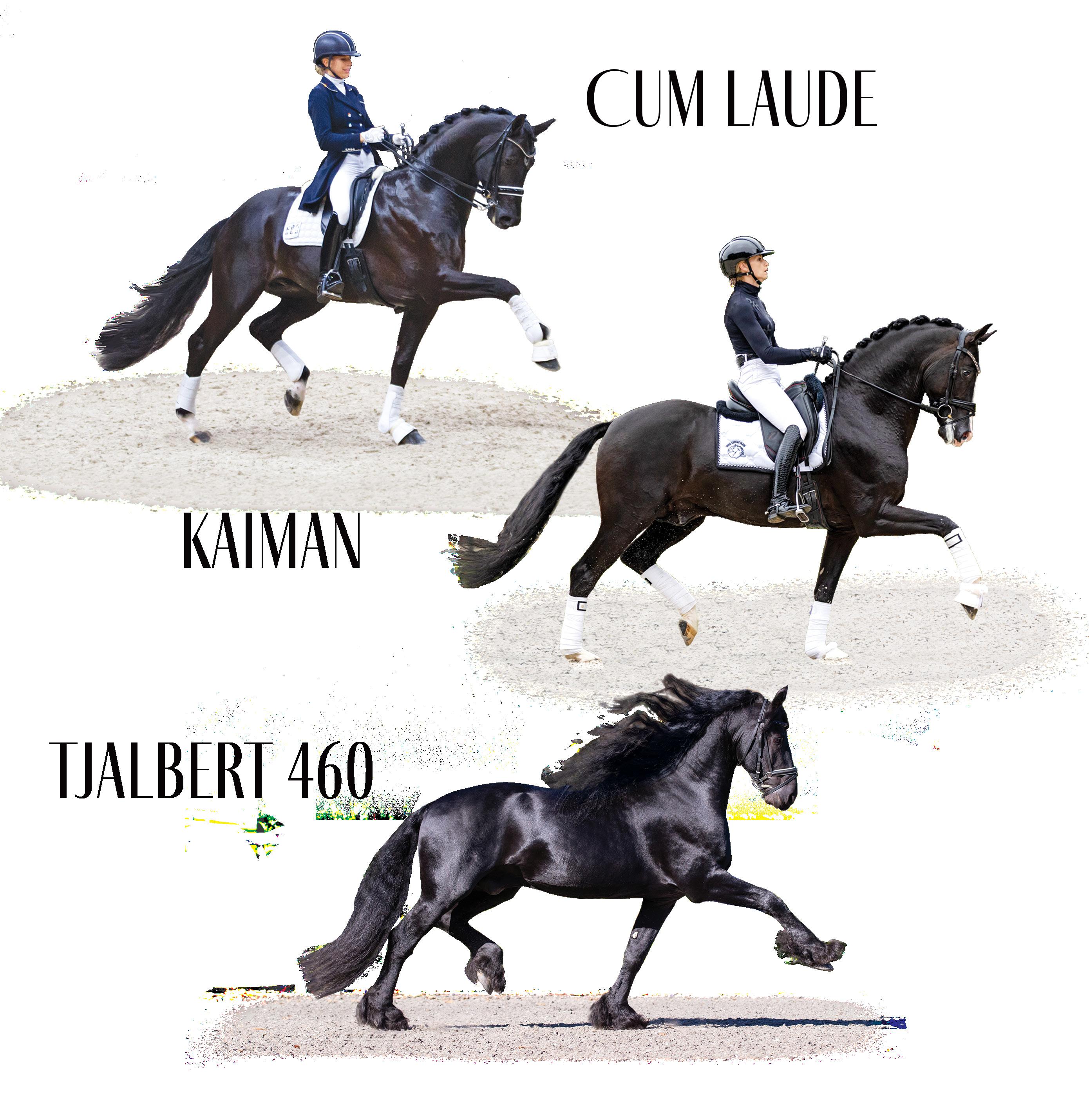
After 50 years, the USDF deserves to brag a little
USDF secretary Margaret Freeman’s “Inside USDF” column in this issue (p. 4) had me chuckling in recognition.
For this special issue of USDF Connection commemorating USDF’s 50th anniversary, USDF president George Williams asked Margaret to reminisce about how the organization has changed and evolved. Being both a longtime USDF member/volunteer and a professional journalist, Margaret did a stellar job of hitting the highlights.
In the early days of her involvement with USDF, Margaret recalls, she didn’t even realize she was a member. She joined her local dressage club, and soon she began receiving newsletters from an unfamiliar organization called the USDF.

The same thing happened to me! As a teenaged eventing enthusiast I joined my own local GMO, started receiving its newsletter—and soon thereafter, black-and-white quarterlies mysteriously began appearing in my mailbox—the USDF Bulletin. I didn’t know what the USDF was, what it did, or why I was receiving its publication.
USDF, I think, has always been a little bit like that—so earnestly devoted to its mission that it sometimes forgets to tout what it’s doing behind the scenes to better the sport of dressage and, by extension, the well-being of the magnificent, generous animals we are privileged to call our partners and friends. (Blame the era and the sport’s traditionalist bent: Back in the day, self-promotion was regarded as a bit unseemly; one was supposed to let one’s accomplishments speak for themselves.)
How times have changed: Today, “promoting your brand” is not only

acceptable but expected. So allow me to recap some of USDF’s greatest hits:
First, the largely volunteer-driven organization built a framework to elevate the sport of dressage in the United States. The US needed a way to educate dressage judges, so USDF created the venerable L Education Program. We needed a system of educating and certifying American dressage instructor/trainers, so the USDF Instructor/Trainer Program was born. We needed to encourage and educate US sport-horse breeders, so sport-horse competitions, awards, and educational programs were created. We needed programs for youth; today they are thriving. The USDF is now also training US Equestrian dressage licensed officials. Bottom line: If you are involved with dressage in this country, whether you realize it or not, the USDF has helped to improve your experience.
Second, USDF established awards and championships programs that serve both as a massive set of aspirational goals and as effortless promotional vehicles for our sport. Consider the success of the Adequan®/USDF All-Breeds Awards program: All of those Thoroughbreds, Norwegian Fjords, Iberian horses (see page
58 of this issue for more on these Baroque beauties), and draft horses are living, breathing billboards for the universality of dressage. Our sport must be doing something right if the All-Breeds program can boast participation by (at last count) 68 breed registries. There truly is a breed for everyone in dressage.
Third—this accomplishment is ongoing and, I think, one of the most promising—our discipline (and others) have been making a place at the table for an increasingly diverse group of human participants, as well. I wonder whether this effort will end up becoming part of the USDF’s mission and eventual legacy over the next half-century. If our first 50 years were spent nurturing dressage and raising the technical bar in the US, then maybe in the next 50 we’ll help to broaden our sport’s base by connecting to people who typically haven’t had opportunities to meet, ride, and fall in love with horses.
You and I know that horses are the best medicine. They offer respite from the craziness and stress of everyday life. The shows and the ribbons may be the most visible trappings of dressage, but they’re not its heart. The heart of our sport—the real reason we’re all in this magnificent obsession together—is that sacred space in which everything else fades away and it’s just you and your horse. Horses and dressage are the most wonderful addiction and the best therapy in the world, and we cherish our equine partners who make it possible. Get that message out and there’ll be no stopping us!
O. Bryant, Editor MICHAEL BRYANT

Your editorial, “Nature vs. Nurture” (“Ringside,” September/October 2022), struck a chord with me.
My father was raised on a farm in Texas, but it was his older brother who introduced me to horses. I can remember him walking me out into the pasture and lifting me onto his beloved Palomino mare, Bonita. I was smitten, but it was not to be. When I was six, my uncle passed and so did the farm. The horses were sold. But I had friends who had horses, and I rode them every chance I got.
Once I had a job and my own income, I bought a horse. He taught me a lot. Later I bought a registered appendix Quarter Horse. We were the epitome of “green horse/green rider,” but we had fun, and he won me a lot of
ribbons at hunter/jumper shows. We never did much beyond lessons in dressage, but I admired it greatly. Then the horse was gone, and so were the opportunities to ride.
Horseless, I worked on ways to be around horses as a photographer, publisher, and artist. I still get to be around horses and enjoy their beauty and talents, and sometimes I freeze a moment in time for a client.
My love of horses is partly genetic—my uncle loved his Palominos—but the environmental aspect was strictly my own determination, by hanging around stables and offering to take care of someone’s horse when they went on a trip or off to college.
Olva Stewart Pharo Cypress, TexasEditor’s note: The letter writer, a renowned equine artist, is the sculptor of works including the Calaveras County Perpetual Trophy, presented to the Grand Prix Freestyle Adult Amateur champion at the US Dressage Finals presented by Adequan®.
It was great to see cross-training highlighted in Jennifer Mellace’s “Fitness Beyond the Saddle” (“Rider,” September/October). However, the article neglected to mention the myriad of benefits that dressage riders can reap from traditional strength training.

Women in particular need not be afraid of the weight room: It’s nearly impossible for the average person to “get bulky” from lifting weights. In fact, as riders gain lean muscle mass, increase coordination and proprioception (body awareness in space), and train various muscle groups, they will easily recognize the immediate benefits in the saddle and communicate more clearly with their horses through their own bodies. Not only that, but strength training also wards off osteoporosis, allows people to maintain independence as they age, and makes slinging hay bales, lifting saddles, and pushing
tack trunks a heck of a lot easier!
Lauren Pietersen, NASM-CPT Rochester Hills, MichiganI have been riding dressage since 1978. It all started at Meredith Manor with former USDF president Kay Meredith. I took that knowledge and supported 4-Hers, Pony Clubbers, and drill-team riders. I showed Appaloosas, Quarter Horses, Pintos, Arabians—well, you get the drift. Now I have amazing warmbloods, and dressage is my passion and the thing that keeps me sane when my day job is crazy.
What continues to be the bane of my existence is the emphasis placed on articles about the folks at the top of the sport. I respect them and I admire the effort, but I also recognize the privilege. I know this is a sport that is expensive in time, commitment, and money. I also believe that the USDF’s backbone is made up of amateur riders who buy new shoes for their horse and forgo a new pair of shoes for themselves.
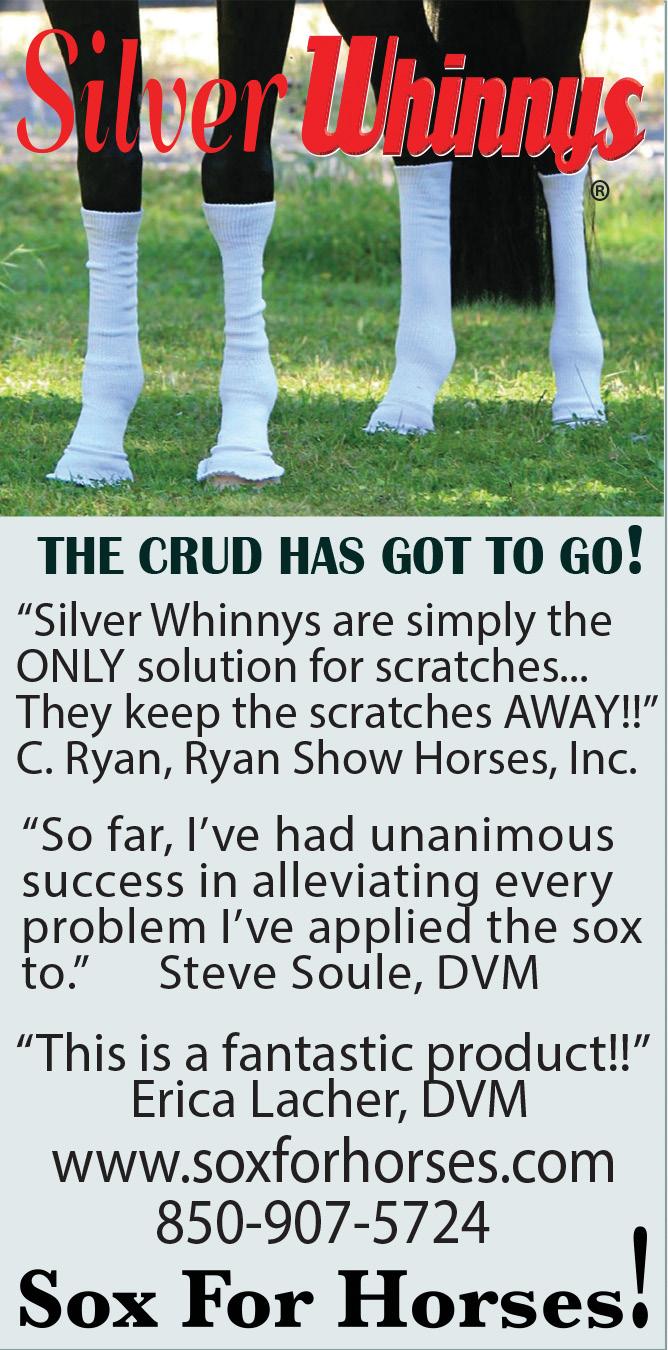
Here is my ask: Focus on the folks who keep this organization afloat. I’d love to read stories about trainers who bring riders along and who hope to ride in one show a year. How about the person who shares clothes, horses, and a trailer to get a score of 60%? Dig deep and get out to see these people and write about them!
Tammie Jensen-Tabor Rainier, WashingtonEditor’s note: We love good stories! Tell us about those unsung heroes: editorial@usdf.org.
Correction
Kari McClain, one of the narrators and technical experts in the filming of the new 2023 national-level dressage tests (“The Judge’s Box,” November/December 2022) is an FEI 4* dressage judge, not a 3*.

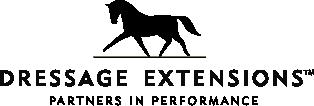






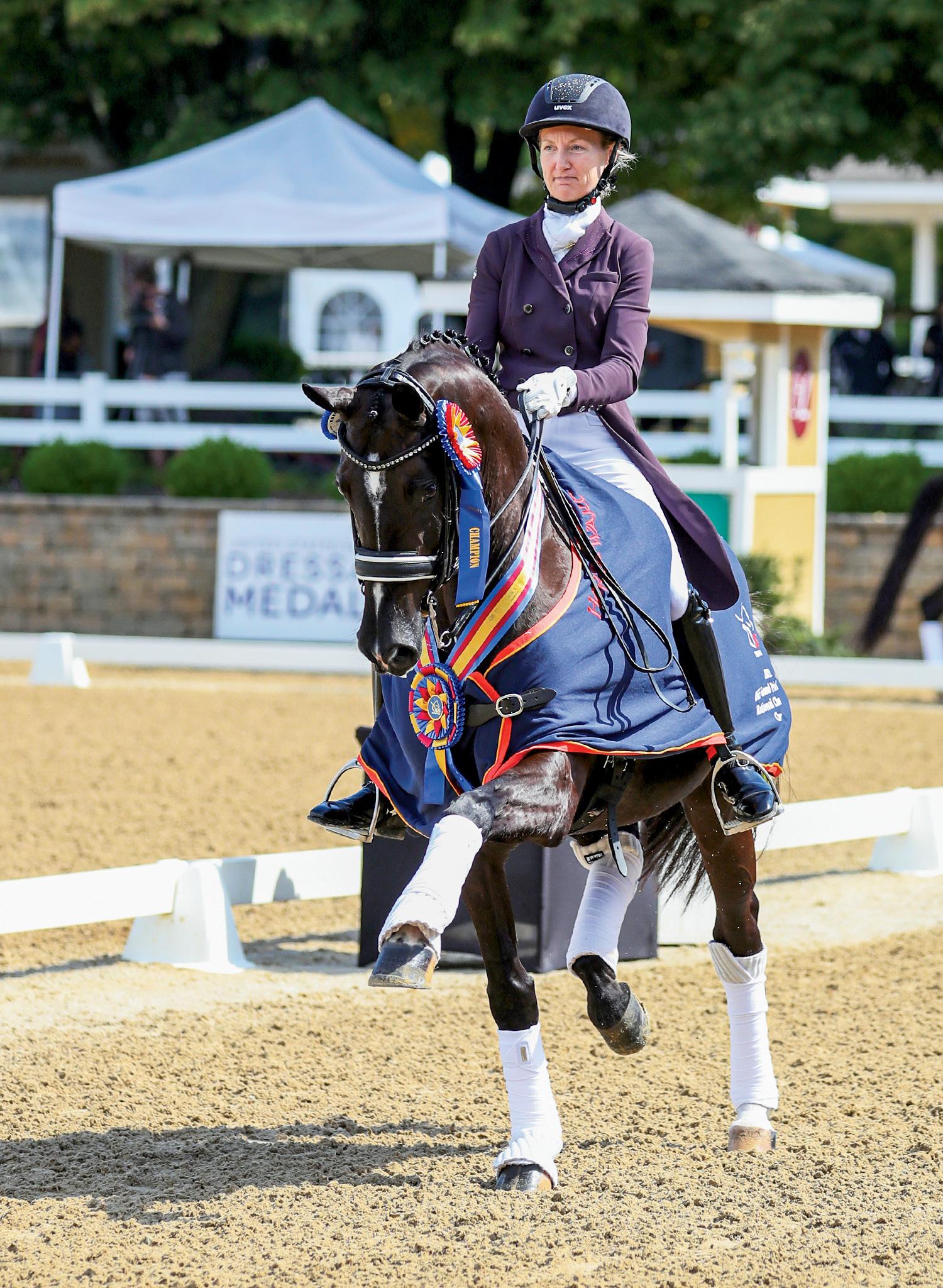

The Europeans—OK, probably some Americans, too—may have been a bit skeptical when Omaha, Nebraska, was awarded the 2017 FEI World Cup Finals. The raucous Las Vegas atmosphere had made four previous Finals there a success, but Omaha? No one knew quite what to expect.
What competitors and spectators found was a friendly, tidy Midwestern city with nice hotels and good restaurants situated within easy distance from the mammoth CHI Health Center Omaha, an enclosed structure containing an 18,300-seat sports arena and 346,000 square feet of convention space. The entire 2017 Finals dressage and jumping competition and trade fair—including the stabling, which was set up somewhere within the cavernous facility—were tucked safely inside. People loved it, marveling at being able to watch the horses warm up literally feet away, in a ring encircled
DEFENDING CHAMPION: Germany’s Jessica von Bredow-Werndl won the FEI World Cup Dressage Final in Leipzig 2022
by trade-fair and food vendors. Omaha plays host again this year as the site of the 2023 FEI World Cup Finals in dressage, jumping, and (for the first time) vaulting, April 4-8.
The World Cup Finals are annual international championships for
which competitors qualify from four FEI-designated leagues around the globe. They are more exclusive than even Olympic Games and World Championships: Participation in the World Cup Dressage Final is limited to 18 horse/rider combinations.
The World Cup in dressage was created as a showcase for freestyle, and it’s the Grand Prix Freestyle score alone that decides the medals. In Omaha, fans will be eager to see whether reigning gold medalist Jessica von Bredow-Werndl of Germany on TSF Dalera BB—who had to sit out the 2022 Herning World Championships because the rider was late in her pregnancy at the time—recaptures her title over Herning 2022 phenoms Charlotte Fry of Great Britain on Glamourdale.
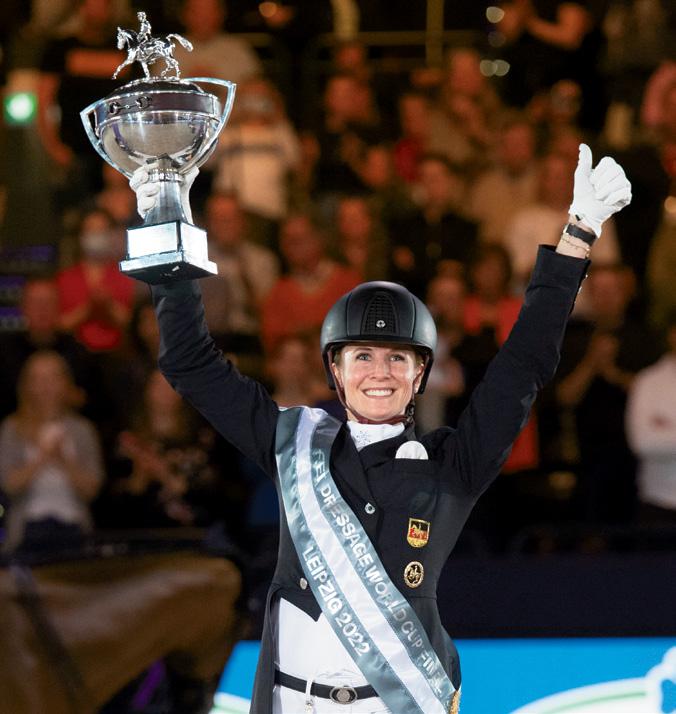
It’s not often that an international dressage championship comes to the US. If you’re able to get to Omaha this spring, do it! Learn more at OmahaEquestrian.org.
Equestrians know the classic signs of horses’ “resistance”—bucking, rearing, and the like. Such behaviors have been shown likely to result from pain, and a sobering new film based on a three-year research project presents evidence that ridden horses signify pain in many more ways than previously thought.
The British veterinarian Dr. Sue Dyson is a renowned expert in equine orthopedics, with a focus on lameness and poor performance in sport horses. Over the course of three years, Dyson and colleagues conducted a six-phase study of more than 400 horses. Their findings resulted in the development of the Ridden Horse Pain Ethogram, a catalog of 24 behaviors that can be associated with pain in the ridden horse. The majority of these behaviors—which range from overt
more ways than previously thought
signs like bucking to such subtleties as opening the mouth or showing the sclera of the eyes—are at least 10 times more likely to be seen in lame horses as compared with non-lame horses, especially when seen in conjunction with other telltale signs, according to Dyson.
Using a case study of a California jumper with deteriorating performance yet no obvious signs of lameness, a new 35-minute documentary film shows Dyson and California-based
veterinarian Dr. Jim Myers applying the Ridden Horse Pain Ethogram as they work to get to the bottom of the horse’s issues. The 24 Behaviors of the Ridden Horse in Pain: Shifting the Paradigm of How We See Lameness follows the struggles of owner Lauren McMahon, who has tried everything from ulcer remedies to joint injections but who has been unable to restore her beloved mare, Galina, to her previous willing self.
“We are conditioned that many horse behaviors are normal, when they are not,” Dyson said. “We need to appreciate that what we call ‘naughty horses’ are often a reflection of underlying musculoskeletal pain.”
To learn more about the research and to view The 24 Behaviors of the Ridden Horse in Pain, go to 24HorseBehaviors.org.
US Equestrian (USEF), the US equestrian national governing body, in October announced two high-profile appointments, one of which is a newly created position.
365-degree view of equestrian sport from a national and a global perspective and share strategies to ensure safety, welfare, and enjoyment while growing the sport across all breeds and disciplines will be an exciting prospect,” O’Connor said.
Hired away from the British Equestrian Federation in 2014, USEF director
Two California-based combinations represented the US in the FEI Six-Year-Old division at the 2022 Longines FEI WBFSH Dressage World Breeding Championships for Young Horses, September 8-11 in Ermelo, Netherlands.
Jennifer Hoffmann, Carlsbad, California, and Mani’s Endeavor, a Hanoverian gelding (Morricone x Foundation 2) owned by Nasrin Mani, scored 8.16 in the FEI Six-Year-Old preliminary test. They tied for twelfth place to move on to the Six-Year-Old final, where they earned a score of 7.36, finishing sixteenth.
David O’Connor has been named the inaugural USEF chief of sport. He will be responsible for working with the USEF executive team regarding overall international and national sport support of the USEF strategic plan and its initiatives, sport integrity, education, and equine and human safety and welfare. He will also oversee international and national sport operations, “ensuring that the Sport Department’s short-term and long-term strategic plans align with USEF’s priorities, and he will focus on strengthening relationships with stakeholder groups such as the US Olympic and Paralympic Committee (USOPC), the Fédération Equestre Internationale, and USEF’s recognized affiliates” (of which the USDF is one), according to the press release announcing his appointment.
O’Connor won individual gold and team bronze medals in eventing at the 2000 Sydney Olympics and team silver at Atlanta 1996. He was the USEF president from 2004 to 2013, and he currently serves on the FEI Board of Directors.


“The chance to perform a
of sport Will Connell stepped down in November 2022. His replacement, who has been given the title of director of FEI/high-performance sport programs, is Graeme Thom.
Thom, who has a background in the financial industry, was short-listed for the Canadian eventing team. He has chaired the Canadian High-Performance Committee and has served as a chef d’équipe for Canada or New Zealand for the past 15 years.
In his new role at USEF, Thom will oversee the FEI-recognized international disciplines’ plans, programs, and overall administration. He will serve as the staff liaison to the USEF International Disciplines Council and the Athlete Advisory Committee; as chef de mission at World Championships, Pan American Games, and Olympic Games; and as the primary sport contact to the USOPC and the FEI.
“I am very appreciative of being offered this exciting role,” said Thom. “I have some extremely large shoes to fill with Will’s departure.”
Gorgeous Latino, a KWPN stallion (Glock’s Toto Jr. x Rubiquil) owned by Sandy Mancini and ridden by Sabine Schut-Kery, Vista, California, was fourteenth in the Six-Year-Old preliminary test with a score of 8.14. In the Six-Year-Old “small final,” the pair scored 8.34 for a fourth-place finish— missing by only one spot the chance to advance to the final.
“We went there with two horseand-rider combinations to be competitive and really represent the United States in the way that we are known for in the international sport,” said US dressage national young-horse coach Christine Traurig. “We had well-trained and well-ridden horses, being aware of how competitive that competition is.”
The Six-Year-Old championship title went to the Oldenburg stallion Global Player OLD (Grand Galaxy Win x Blue Hors Don Schufro), ridden by Eva Möller of Germany. In the Five-Year-Old division, the winner was the Danish Warmblood mare Lyngbjergs St. Paris (Blue Hors Don Schufro x Blue Hors Rockefeller), ridden by Victoria E. Vallentin of Denmark. The Seven-Year-Old champion was the KWPN stallion Kjento (Negro x Jazz), ridden by Charlotte Fry of Great Britain..
Para-dressage has joined the roster at the US Dressage Festival of Champions, bringing the number of divisions up to 16. The 2022 edition of US Equestrian’s (USEF) nationalchampionships competition was held August 22-28 at HITS Chicago at Lamplight Equestrian Center, Wayne, Illinois.
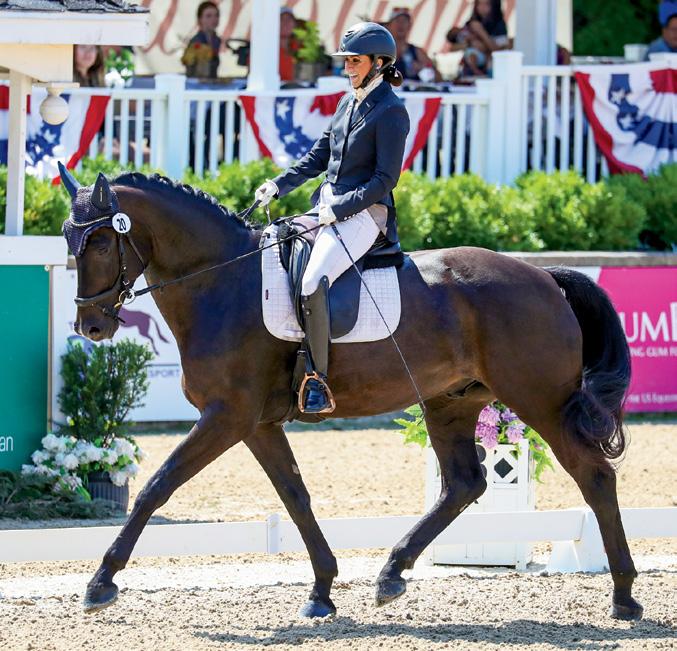
Markel/USEF Young Horse Four-YearOld Dressage National Championship
CH: Adrienne Lyle, Wellington, Florida, on Fürst Dream, a Hanoverian stallion (Fürstenball OLD x Benetton Dream FRH) owned by Betsy Juliano LLC (92.920%)
RS: Alice Tarjan, Oldwick, New Jersey, on her Oldenburg mare Ice Princess (by Asgard’s Ibiza) (89.760%)
Markel/USEF Young Horse Five-YearOld Dressage National Championship
CH: Adrienne Lyle, Wellington, Florida, on Valor, a Westfalen gelding (Vitalis 4 x Fürstenball OLD) owned by Kylee Lourie (92.480%)
RS: Alice Tarjan, Oldwick, New Jersey, on her Oldenburg mare Ierland’s Eden (Ierland x IPS Krack C) (88.480%)
Markel/USEF Young Horse Six-YearOld Dressage National Championship
CH: Cesar Parra, Whitehouse Station, New Jersey, on Møllegårdens Fashion, a Danish Warmblood gelding (Florenz 71 x Tailormade L’Espoir) owned by Marcela Parra Bautista and the rider (83.480%)
RS: Rebecca Rigdon, Cardiff-bythe-Sea, California, on Lionell VE, a KWPN gelding (Negro x Tenerife VDL) owned by Lauren Fisher (81.800%)
Markel/USEF Young Horse SevenYear-Old Dressage National Championship
CH: Endel Ots, Wellington, Florida, on King’s Pleasure, a KWPN stallion (Dark Pleasure x Glock’s Johnson TN) owned by Heidi Humphries (78.295%)
RS: Cesar Parra, Whitehouse
Station, New Jersey, on Fanta 4, a Hanoverian gelding (Finest 10 x Florencio 2) owned by Gina Raful and the rider (76.181%)
Markel/USEF Developing Horse Prix St. Georges Dressage National Championship
CH: Olivia LaGoy-Weltz, Haymarket, Virginia, on Johnny Be Goode, a 2014 KWPN gelding (Glock’s Dream Boy N.O.P. x Tietse 428) owned by Fritz and Claudine Kundrun (73.223%)
RS: Martin Kuhn, New Berlin, Illinois, on Ronin, a 2013 Hanoverian gelding (Glock’s Romanov x Sir Donnerhall I) owned by Kathryn Fleming-Kuhn (71.211%)
Markel/USEF Developing Horse Grand Prix Dressage National Championship
CH: Claire Darnell, Mt. Vernon, Washington, on her 2012 KWPN gelding, Harrold S (Vivaldi x Fidermark NRW) (69.942%)
RS: Alice Tarjan, Oldwick, New Jersey, on her 2014 KWPN mare, Jane (Desperado N.O.P. x Metall) (69.325%)
USEF Intermediaire I Dressage National Championship
CH: Laura Graves, Geneva, Florida, on SenSation HW, a 2013 Westfalen gelding (Sunday NRW x Dancier) owned by Carol and Scott McPhee (75.104%)
RS: Emily Miles, Paola, Kansas, on Daily Show, a 2014 Hanoverian stallion (Danciano 2 x Stockholm 8) owned by Leslie Waterman (73.301%)
USEF Grand Prix Dressage National Championship
CH: Alice Tarjan, Oldwick, New Jersey, on her 2013 Hanoverian mare Serenade MF (Sir Donnerhall x Don Principe) (74.176%)
RS: Katie Duerhammer, Greenwood Village, Colorado, on Kylee Lourie’s 2011 Westfalen gelding, Paxton (Dante Weltino OLD x Don Marco 3) (70.597%)
USEF Pony Rider Dressage National Championship
CH: M.K. Connatser, Dallas, Texas, on Blitz und Donner, a 2011 German Riding Pony gelding owned by Linda Graves (66.347%)
RS: Maryn Geck, West Linn, Oregon, on Whinny, a 2004 Welsh Pony mare (Tide Creek Jack Frost x Gayfield’s Mastermind) owned by Laura Geck (65.922%)
USEF Children Dressage National Championship
CH: Autumn Vavrick, Oxford, Michigan, on her 2007 Hanoverian gelding, Dante (De Niro 6 x Weltmeyer) (79.728%)
RS: Virginia Woodcock, Atlanta, Georgia, on The Safari Party, a 2009 American Sport Pony gelding (Branstock’s Ryujin x Rhoquest) owned by Elizabeth Woodcock and the rider (79.141%)
Adequan®/USEF Junior Dressage National Championship
CH: Ella Fruchterman, West Lakeland, Minnesota, on Holts Le’Mans, a 2011 Danish Warmblood gelding (Tailormade L’Espoir x De Noir 3) owned by Todd Fruchterman and the rider (70.245%)
RS: Madison Sumner, Wellington, Florida, on Briar, a 2007 KWPN gelding owned by Wayne Sumner and the rider (69.463%)
CH: Averi Allen, Pleasant Hill, Missouri, on Superman, a 2013 Hanoverian gelding (Scolari x Matcha AA) owned by Jonni Allen (69.608%)
RS: Ellanor Boehning, Rancho Santa Fe, California, on Sir Junior, a 2011 Hanoverian gelding (GGN Stauffenberg x Goliath II Z) owned by Ann Boehning and the rider (69.069%)
Adequan®/USEF Young Adult Brentina Cup Dressage National Championship

CH: Quinn Iverson, Wellington, Florida, on Beckham 19, a 2009 Hanoverian gelding (Benetton Dream FRH x Don Davidoff 2) owned by Bille Davidson (69.543%)
RS: Callie Rose O’Connell, Wilmington, Massachusetts, on Eaton Unitechno, a 2009 Hanoverian gelding (Wynton x San Remo 92) owned by Ruling Cortes LLC (68.408%)
Pioneering pediatric oncologist, Ronald McDonald House co-founder, equestrian-sport supporter, and amateur dressage rider Dr. Audrey Evans died September 29 at her home in Philadelphia. She was 97. Born in England, Evans broke ground her entire life. She became a physician at a time when most doctors were men. While leading the oncology division at the Children’s Hospital of Philadelphia (CHOP), she developed the Evans Staging System for neuroblastoma, which is credited with reducing fatality rates by more than 50%. Seeing out-of-town families struggle to pay for hotel rooms while their children were undergoing cancer treatment at CHOP, Evans co-founded the original Ronald McDonald House in Philadelphia, which evolved into a global network of lodging for families of children with serious medical issues.
Having put her equestrian
USEF Dressage Seat Medal Final, 13 and Under
CH: M.K. Connatser, Dallas, Texas, on Donau Hit, a 2003 gelding (Diamond Hit x Brentano II) owned by the rider (86.000%)
RS: Korey Denny on Hemingway KW (by Blue Hors Don Schufro),
owned by Amy Denny (85.000%)
USEF Dressage Seat Medal Final, 14-18
CH: Kayley Knollman, Maineville, Ohio, on JP Zeppelin, a 2012 Andalusian gelding by Lusiadas USA, owned by Rebecca Stromatt (87.000%)
RS: Marin Roth, Bloomington, Illinois, on her 2014 Zweibrucker gelding, Erin Meadows Jägermeister (by Rastede) (85.000%)
USEF Para-Dressage National Championship
CH: Mia Rodier-Dawallo, Santa Barbara, California, on her 2014 KWPN gelding, Jayden (Bordeaux 28 x Sandreo) (69.094%)
RS: Sydney Collier, Ann Arbor, Michigan, on All in One, a 2009 Hanoverian gelding (St. Ludwig’s Abanos x Dauphin 21) owned by Going for Gold LLC and Georgina Bloomberg (67.998%).
own horses for dressage rider Todd Flettrich and eventers Phillip Dutton and Marcia Kulak, with some of the eventing horses reaching the CCI5* level and one competing at the 2004 Athens Olympics after being sold to the Netherlands. Evans became heavily involved with the Dressage at Devon (Pennsylvania) show, and for a decade the show benefited CHOP. She was honored in a special ceremony at Dressage at Devon’s 2006 edition for her many contributions, and also to celebrate her completing her Century Club ride for The Dressage Foundation that year.
passion aside while she completed her education and established her career, Evans pursued horses and riding with vigor after she moved to Philadelphia in 1969. She took dressage lessons and went on to

A major motion picture based on Evans’ life, Audrey’s Children, starring Natalie Dormer, began filming in September 2022 in Philadelphia.
For more about Evans, read “Salute: McMiracle Worker” (July/ August 2021).
Megan McIsaac, head trainer at Lindinhof Equine Sports Zentrum in Oregon, Wisconsin, is the 2022 recipient of The Dressage Foundation’s $5,000 Team Tate Mentorship and Leadership Fund Grant. The purpose of the grant is to help dressage professionals further their business, leadership, and riding skills.

A USDF-certified instructor/trainer through Fourth Level, McIsaac planned to use the funds to participate in an entrepreneur workshop and monthly leadership coaching with Bedros Keuilian, and for dressage training with Kathleen Raine.
Established by the Tate family in 2020, the fund is administered by The Dressage Foundation, Lincoln, Nebraska (DressageFoundation.org). The 2023 application deadline is July 15.

Attention, 2022 Award Recipients
Awards not picked up at the 2022 Salute Gala & Annual Awards Banquet were mailed to award recipients in December. Contact USDF if you have not received your award by January 30, 2023
Free Online Reports Available
USDF Historical Awards Reports, Owner’s/Lessee and Breeder’s Horse Portfolios, and Dam/Sire Reports are available to current USDF participating, group, and business members free of charge. You must be logged in to the USDF website to obtain reports at no charge.
For Adequan®/USDF year-end awards purposes, Intermediate I and Intermediate II tests are not considered consecutive levels. See the 2023 USDF Member Guide for year-end award requirements regarding consecutive levels.
A horse’s USDF registration must be in the name of the current owner or lessee, and it must be exhibited in the name of the current USDF owner or lessee of record. If a lease is on file with USDF, then the horse must be exhibited under the ownership of the lessee.

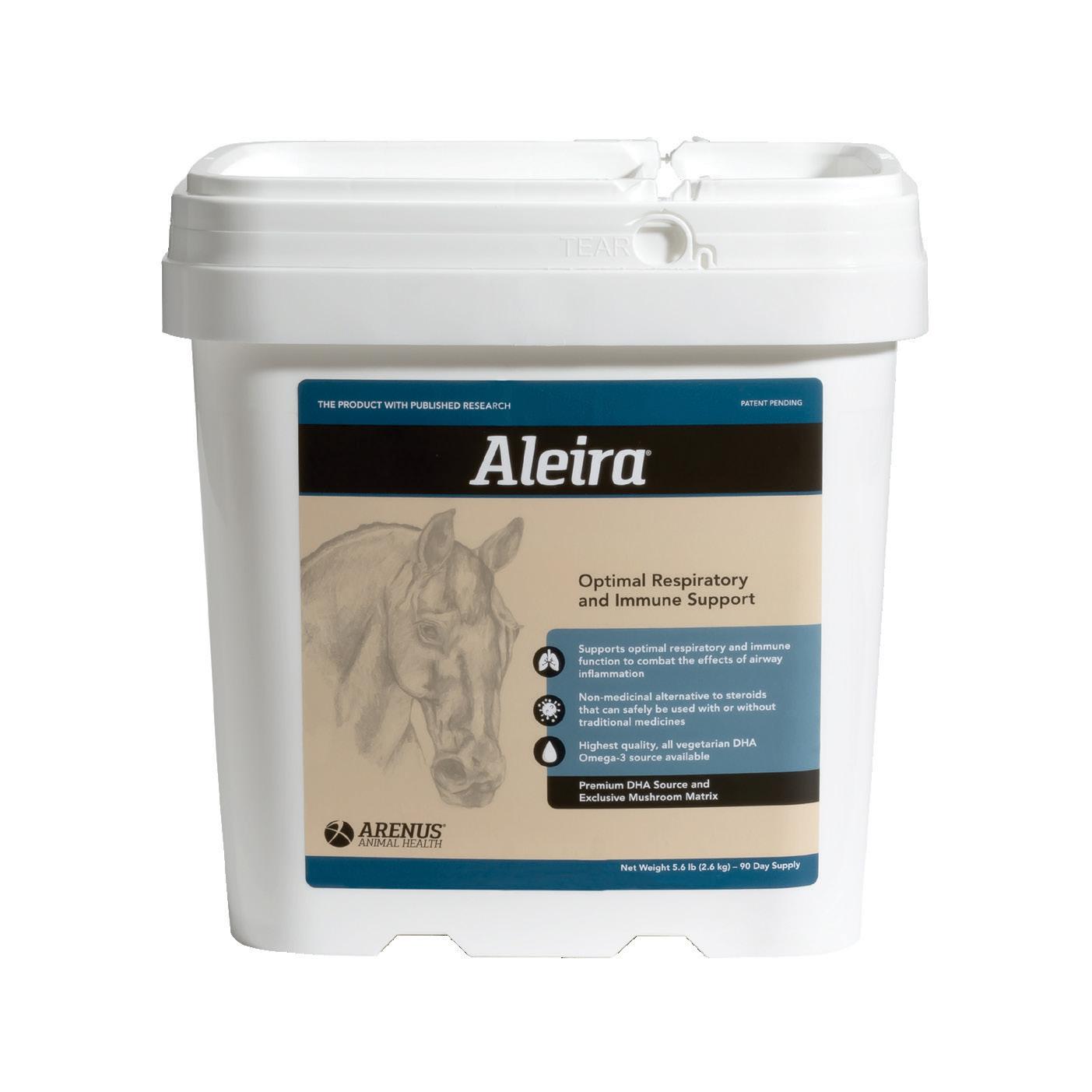
Breed shows are in decline, our columnist believes. What can be done?
By Maurine “Mo” SwansonDressage has its roots in Europe, dating back hundreds of years. Not surprisingly, the breeding of sport horses is a major industry there, and sport-horse breed shows are an important part of that industry.
Most such shows are held by individual breed registries’ local clubs. They attract large crowds, who come to see which horses will place well enough to earn an invitation to that breed’s championship show.
Westfalen, Holsteiner, Trakehner, and Dutch Warmblood registries, among others, all host finals competitions for mares (colts and geldings are not usually shown, as it is assumed that they will have to prove themselves in future performance or in the stallion-selection process). Stallion shows are very popular, as well, and are offered by breed registries, individual stud farms, or both.
Here in the USA, sport-horse breeders have for years worked to
changed the quality of dressage breeding in this country. The result is that American breeders today are producing high-quality horses that can compete with those born anywhere in the world.

Along with those efforts, US sport-horse breeding enthusiasts and our national organizations have developed competitions and awards for US-bred sport horses and breeders. Here’s a brief overview.
US dressage sport-horse breeding (DSHB) shows, licensed by US Equestrian (USEF) and recognized by the USDF, are run according to USEF rules. There are both nonbreed-specific open classes and individual breed classes (IBC). Classes are divided by age and sex. Breeders may enter their horses in in-hand classes, including in the new divisions of Three-Year-Old and FourYear-Old Sport Horse Prospect; or in under-saddle classes, such as Materiale. To be eligible to participate, certain USEF and USDF membership and registration requirements may apply (see the current USDF Member Guide for specifics).
In two important divisions, three- and four-year-old mares are shown in hand, with information about their pedigrees, successful relatives, and mare-testing results published in the show catalog. The Hanoverian, Oldenburg, Danish,
emulate the success of their European counterparts. The importation of high-quality breeding stock over many years, the availability of frozen semen from European stallions, and rigorous US stallion licensings and mare inspections together have
The flagship of US DSHB competition is the USDF Breeders Championship Series, which is modeled after the USDF Regional Dressage Championships program. In the USDFBC Series, designated regions each hold an annual Series Final competition provided that they have hosted at least three qualifying dressage breed shows in that competition year. In 2022, there were seven USDFBC Finals: in Spokane, Washington; Washington, Missouri; Magnolia, Texas; North Salem, New York; Lexington, Kentucky; Long-
mont, Colorado; and Devon, Pennsylvania.
In addition to USDFBC Series
Final titles, breeders and owners of sport-horse breeding stock and young prospects can earn a variety of awards through the USDF. There are 11 categories of Adequan®/ USDF DSHB year-end awards: fillies of current year, colts/geldings of current year, yearling fillies, yearling colts/geldings, two-year-old fillies, two-year-old colts/geldings, threeyear-old fillies, three-year old colts/ geldings, four-year-old and older maiden mares (never been bred) and yeld mares (not currently bred or nursing), four-year-old and older broodmares, and four-year-old and older stallions. There are also Materiale year-end awards for three-yearold fillies, three-year-old colts/geldings, four- and five-year-old mares, and four- and five-year-old stallions/ geldings.
Finally, many registries participate in the Adequan®/USDF AllBreeds awards program, with many offering annual DSHB awards in addition to performance awards.
All of these awards programs have rules and requirements including memberships, horse registrations, and score requirements and minimums. See the USDF Member Guide for details.
This system of competition and recognition is designed to encourage the breeding of high-quality sport horses in the US. Although it is admirable, it has faced increasing challenges in recent years.
Challenge: Not enough shows. Meeting these requirements, such as earning a minimum number of scores in order to qualify for USDFBC Finals participation or a year-end award, can be a real issue for those breeders who reside in areas with few competition offerings.
The number of USDF DSHB shows has declined steadily over the years, as have entry numbers. In 2022, my region, the East Coast USDFBC Series (North Carolina,
Virginia, West Virginia, Maryland, Delaware, Pennsylvania, and New Jersey), had the largest number of competitions of all the USDFBC regions, with 15. But even in my region, reaching my competitive goals proved difficult. One very important competition on my calendar was canceled just prior to the closing date for lack of entries. As a result, because I had a horse that was a candidate for a year-end award, I had to submit a last-minute entry to a show in another region. Another DSHB show in my region drew only six entrants. It will be difficult for show management to justify holding this show again in 2023, but I sincerely hope they will.
The East Coast Series final, held at Dressage at Devon in Pennsylvania, is the largest DSHB show in the country, but even its entry numbers continue to decline. In 2022, the Southeast USDFBC region (Tennessee, Alabama, Georgia, South Carolina, and Florida) and the Western region (California, Nevada, and Arizona) hosted no breed-show competitions at all. The remaining regions held three, four, or five competitions.
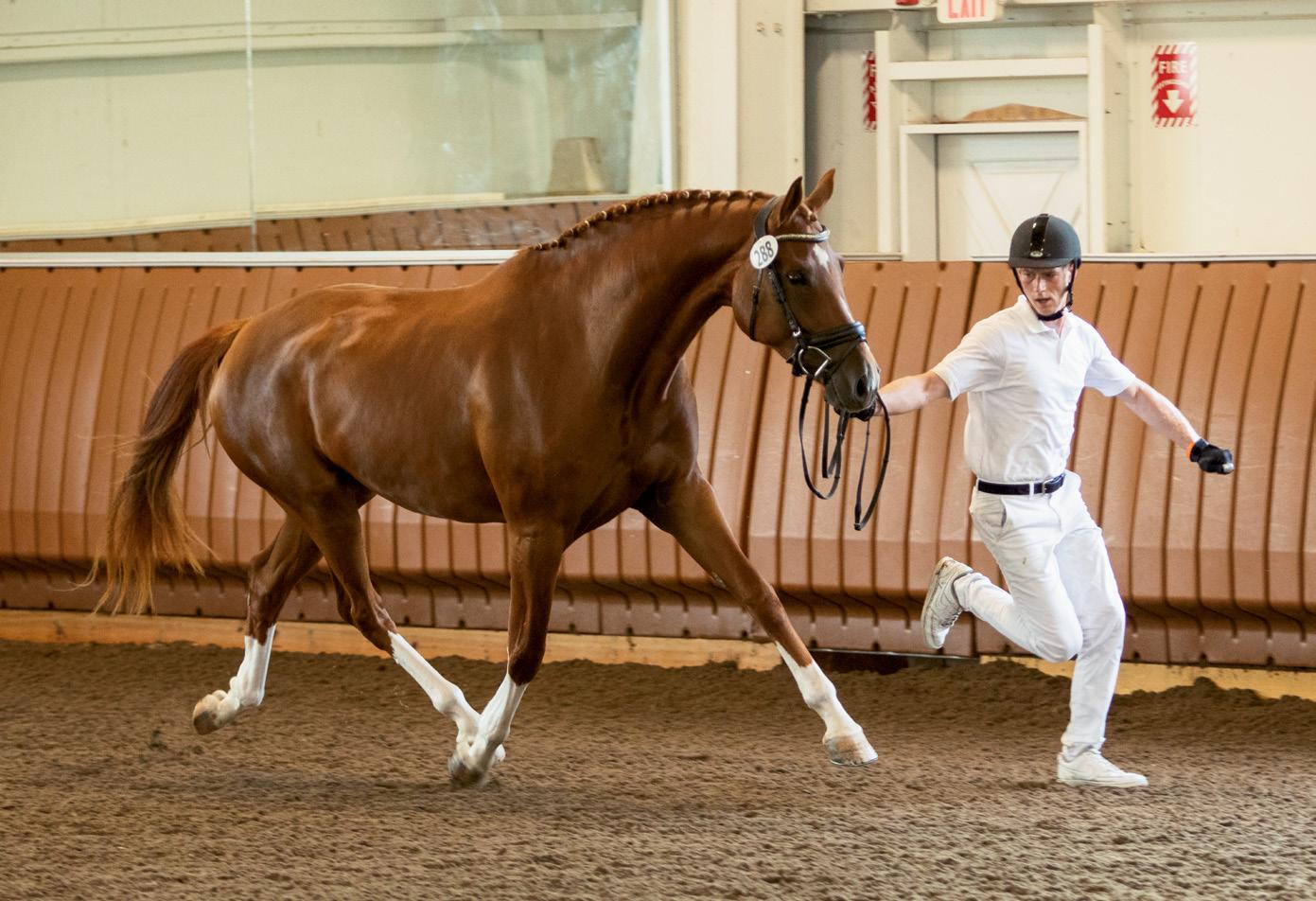
Thankfully, it is usually possible for a breeder to earn one Series Final qualifying score on the first day of the Final show itself, provided the show has a two-day format with an open show the day before the Final. A few Finals also offer “Born in the USA” prize money to winning US-born horses, thanks to generous sponsors of this program.
Challenge: Cost of showing. I have supported breed shows with my entries for many years, but entry fees, stabling, lodging, handler fees, and gas prices all have risen. I struggle to justify the extra expense visà-vis my return on investment. It’s also a lot of work to prepare a young horse to show, and I don’t show as many as I used to. A few breeding operations still bring multiple young and mature horses to breed shows, and these exhibitors are basically supporting their regions’ shows and USDFBC Finals singlehandedly. I admire them! I also tip my hat to those breeders who travel great distances to compete.
Challenge: Dearth of experienced handlers. In my region, at least, the lack of availability of handlers skilled in showing horses
in hand to their best advantage is becoming an issue. At Dressage at Devon last year, there were only a handful of professional handlers available, with a few popular ones “running” practically every horse in the show. The USDF has offered handling clinics, and I hope that the result will be some new handlers coming up the ranks.
Of course, you can handle your own horse, but it’s important to breeders to realize that a good handler can make a difference in how a horse places in the class. If you are hanging on the reins or lead rope, stumbling while trying to keep up with your big-moving horse, you put your horse at a disadvantage. Doing well and winning at a breed show requires running with your horse multiple times—which requires a level of fitness I myself have not enjoyed in many years.
At the same time, hiring those experienced handlers can be expensive. Years ago, handlers would often
not charge for championship classes. I suppose it was to promote themselves as handlers of the champions, but today most handlers charge for each run. I don’t begrudge this, but I have trained and used a few novice handlers in order to save some money. I encourage other breeders to do the same. We need new young handlers and they need experience, and they need to be promoted if they are good.
I encourage prospective DSHB judges to take the required USDF Sport Horse Seminars toward obtaining their DSHB licenses. Perhaps the USDF can consider a short track toward licensing for those individuals who are already judges for breed registries and who have demonstrated knowledge of the USDF sport-horse rules and procedures by testing. If breed shows have a larger and more local pool of judges from which they can hire, their expenses will be reduced.
stock for the dressage ring, and it is rewarding to see one’s horses earn recognition.
If you are a rider or trainer, consider going to a breed show to watch. You can learn a lot, and your next dressage prospect may be in the ring. Most shows indicate whether a horse is for sale. If you see a horse you like, find the breeder or exhibitor and ask questions. They would love to be approached by a rider or trainer. If you don’t have a horse to enter in a breed show, volunteering to scribe for a DSHB judge is a great learning experience, as well.
I encourage breeders to support their regional breed shows, or they may find that those shows disappear entirely. What a shame that would be!
For over a century, the Dehner name has been proudly worn by young and old alike.

Feel for yourself the comfort and fit that have made us one of the most sought-after boots in the business!
Log-on today to view our full line of boots and shoes
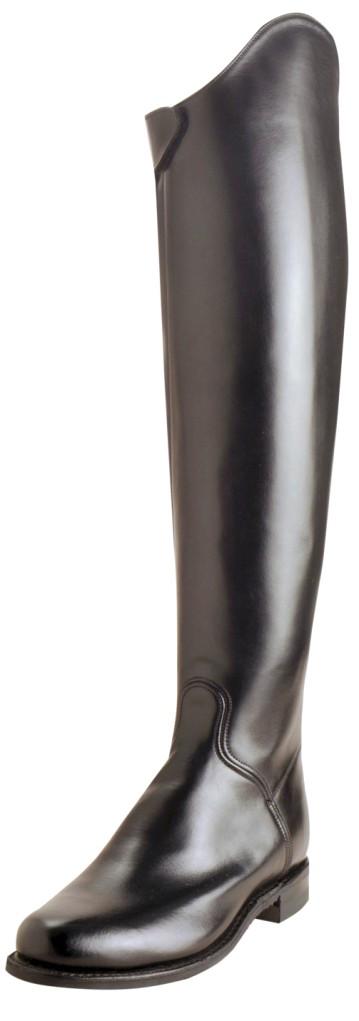
Perhaps the USDF should also consider changing the qualifying criteria for year-end DSHB awards from three shows to two. Reducing this requirement may encourage more participation from breeders, especially in regions in which shows are few and travel distances are great.
I encourage show managers to consider offering breed shows as part of existing recognized dressage shows, and I hope that those show managers who have done so in the past continue to offer a DSHB division, even in situations in which entry numbers have decreased. I don’t have an easy financial solution to this problem. Seeking financial sponsorships from breeders, suppliers, or donors may be one avenue.
Breed shows are a lot of work but also a lot of fun. They allow breeders to connect with other breeders and to show off the products of their labors. Breeders put their hearts and souls into producing foals and young
has been breeding horses for 43 years. With her husband, Jim, she owns Rolling Stone Farm in eastern Pennsylvania.
Her homebred Hanoverians and Oldenburgs have earned top-10 national dressage rankings and have won many titles both under saddle and in hand. She won the Adequan®/USDF Dressage Sport Horse Breeding Breeder of the Year title in 2016 and 2018, and in 2020 and 2022 she was named the Adequan®/USDF Dressage Breeder of the Year. She was also the US Equestrian Dressage Breeder of the Year from 2014 through 2021.


The USDF L program’s response to pandemic restrictions, “Taste of the L Program” has proven a versatile and popular online educational module
By Marilyn HeathDid you know that you can enjoy a “Wine Tasting from Home”? Well, now you can experience a “Taste of the USDF L Education Program” from home, as well!
During the COVID-19 pandemic, the USDF L program faculty and the USDF Judges Committee together created a remote “Taste of the L Program” module that is available to all USDF group-member organizations (GMOs) and other approved groups.
is also valuable for licensed dressage judges who are interested in learning what is being taught today to aspiring judges.
Although the L program was created as an introduction to dressage judging for those working toward the USEF “r” license, today the program is not just for prospective judges. The modern L program is divided into two parts. Part 1 (encompassing three weekend sessions called A, B, and C) is intended for
nized dressage competitions.
The remote Taste of the L Program is a three-part summary of the sessions in Part 1. Each summary session is one hour in length and is presented in alphabetical order by the L program faculty. It may be taught by three separate faculty members, or one person from the faculty may present all three. The format can be presented on multiple online platforms.
Each remote session outlines what is taught in the full L program. In the “Taste of the A Session” we touch on rules, including how to access the USEF rule book and its Equipment and Attire booklet. We briefly discuss the methodology judges use to arrive at consistent scores throughout each class and throughout the show. Then we talk about the biomechanics of the parts of the horse, and discuss how to use that knowledge of biomechanics to evaluate the basics according to the pyramid of dressage training. We finish by explaining the rhythm of each of the three gaits and discussing how the movements in the dressage tests may affect the basics.
The initial purpose of this initiative was to create a program that could be presented online, since it was not possible to meet in person. But even though live programs are once again taking place, the “Taste” program has remained popular. It is valuable to L graduates as a review and is approved for three hours of L graduate continuing education. It serves as an “appetizer” for those who want to get an overview of the program before they commit, and it
a wide group of dressage enthusiasts—riders, trainers, those pursuing a judging career, and, yes, even currently licensed judges who want to further their education. Trainers need to know how judges are taught to judge, how they arrive at the appropriate score, and how they formulate a correct comment that is helpful, accurate, and encouraging. Part 2 is the evaluative part of the program and is held at three separate USEF-licensed/USDF-recog-

“Taste of the B Session” introduces the purpose and criteria of Training through Second Levels. It addresses defining the essence of each movement, the treatment of modifiers, and the formulation of constructive comments. We discuss the movements of Training, First, and Second Levels.
The collective marks (gaits, impulsion, submission, and the two rider scores) are the subject of the “Taste of the C Session,” which also includes a discussion of the components of the collectives. There is also
a short presentation on judging freestyles, including a overview of how judges evaluate harmony, choreography, degree of difficulty, music, and interpretation.

We invite all USDF GMOs and other groups to host their own “tasting programs.” All approved Taste of the L Programs are listed on the USDF education calendar at usdf. org. For more information about hosting a remote Taste of the L Program, send e-mail to lprogram@ usdf.org.
USEF “S” judge Marilyn Heath, of Naples, Florida, is a longtime USDF L program faculty member and member of the USDF Judges and L Program Committees. She received the USDF Lifetime Achievement Award in 2013 in recognition of her contributions to the L program and to promoting excellence in dressage judging.
is the deadline for nominations for
Member (PM) Delegates in All Regions
To accept the nomination, and if elected, a PM delegate nominee must:
• Be a current Participating Member of USDF.
• Have a permanent residence and reside in the region for which they are running to represent.

• Agree to serve a one year term, from the time of election in 2023 until the election in 2024.
• Attend the 2023 Adequan®/ USDF Annual Convention.
Can you be both a dressage professional and a parent? Three moms weigh in on the choices and challenges involved.
By Jennifer MellaceMany of us started our love affair with horses as children. We would eat, sleep, and breathe these magnificent creatures, and we’d soak up every spare minute grooming, riding, and just being at the barn.
pros’ keen interest in the topic at past USDF/USEF Young Rider Graduate Programs, the question of whether one can successfully balance the demands of dressage with the demands of a family is of wide concern. To help shed light on this topic, we spoke with three wellknown trainers who have chosen to juggle both children and their dressage careers. They share how they made their decision, how they manage their dual obligations, and the joys and challenges in making it all work.
When Jaclyn Sicoli and her husband, Luke, decided to start a family, she worried about whether having kids would impact her dressage business, her relationships with her clients, her ability to manage her time, and her health.
Siegbert, the man who is now her husband, “turned that into a priority for me.”
The couple’s son, Noah Anthony Siegbert, was born in July 2021. Brock explains that “Anthony has a daughter from a previous relationship, so I was lucky enough to become a ‘bonus parent’ with her; and having Noah was very fortunate considering my age.” (She was 42 when she gave birth.)
But as you got older, you may have had to make some difficult choices regarding your equestrian involvement, particularly if you wanted a family. Those choices may have been amplified if you pursued dressage professionally—because a career in horses tends to be allconsuming.
Judging by young dressage
“The day that I told my barn I was pregnant was memorable because I expected some negative reactions,” says Sicoli, a USDF bronze and silver medalist, a USDF L graduate with distinction, and the owner/operator of Peace of Mind Dressage in Waterford, Virginia. Clients did ask whether lesson or training schedules might change as a result, but “I was shocked at how positive and supportive everyone was. It was confirmation that I could view my life and my decisions as a person, not just a horse trainer.”
Some dressage pros never envisioned themselves with kids, but life had other plans. US Olympic dressage team bronze medalist Allison Brock, of Wellington, Florida, “actually wasn’t sure if I would ever have a family.” But meeting Anthony
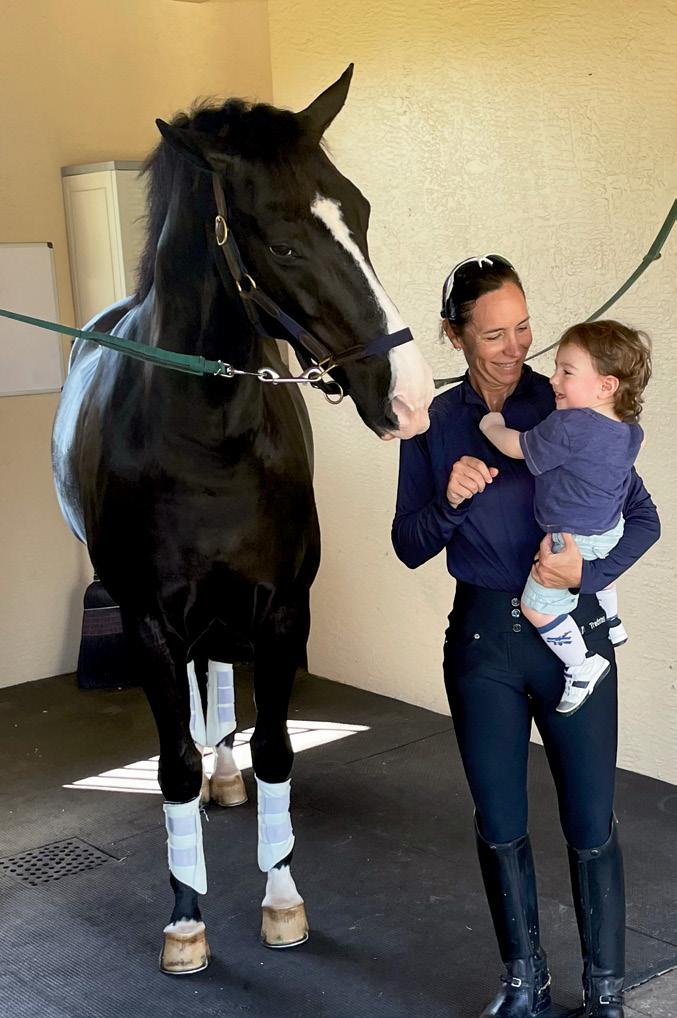
Some couples just know from the start that they will juggle both horses and children. “Luckily, there was never a decision to be made,” says Brock’s 2016 Rio Olympics teammate Kasey Perry-Glass, 35, of Orangevale, California. “My husband and I both respect and love each other’s passions and dreams to where we both want to make it all work—career and family.” Perry-Glass and her husband, horse trainer Dana Glass, are parents to Tru Lynn Glass, who celebrated her first birthday in November 2022.
If you have horses, you know that things can get crazy and that your plans can go out the window in a heartbeat. Add children to this mix and the juggling act just got 10 times harder. Our hard-working, high-achieving equestrian moms all wish there were more hours in a day, yet they have found ways to make both business and family priorities when needed.
“The biggest challenge for me has been finding a balance between work and family,” says Perry-Glass. “I am a person who wants to do it all and do it all 100 percent. Therefore, when I feel like something is
slipping, it makes me anxious and stressed.”
Perry-Glass often reminds herself that she can’t be everything to everyone all of the time. “There will be days that my work/life flow is easier than others, and there will be days that Tru will need me more than work does. I thought that before kids I was a good multitasker— but now I feel like a true pro at it, and it can definitely be overwhelming!”
Since having Noah, Brock has had to adjust her priorities, and one of the biggest changes has been her previously unlimited availability to her students.
“I try to not to handle calls once I am home unless it’s an emergency,” she says. “I also try not to leave my house before Noah is up in the morning so I can have some one-onone time with him before I leave for work.”
Brock admits that she doesn’t have a lot of down time to herself. “For me [down time] is staying home on Mondays with my son all day. I tried to finish early on Sundays through the summer, but that gets tough with the [Florida winter] show season coming up.”
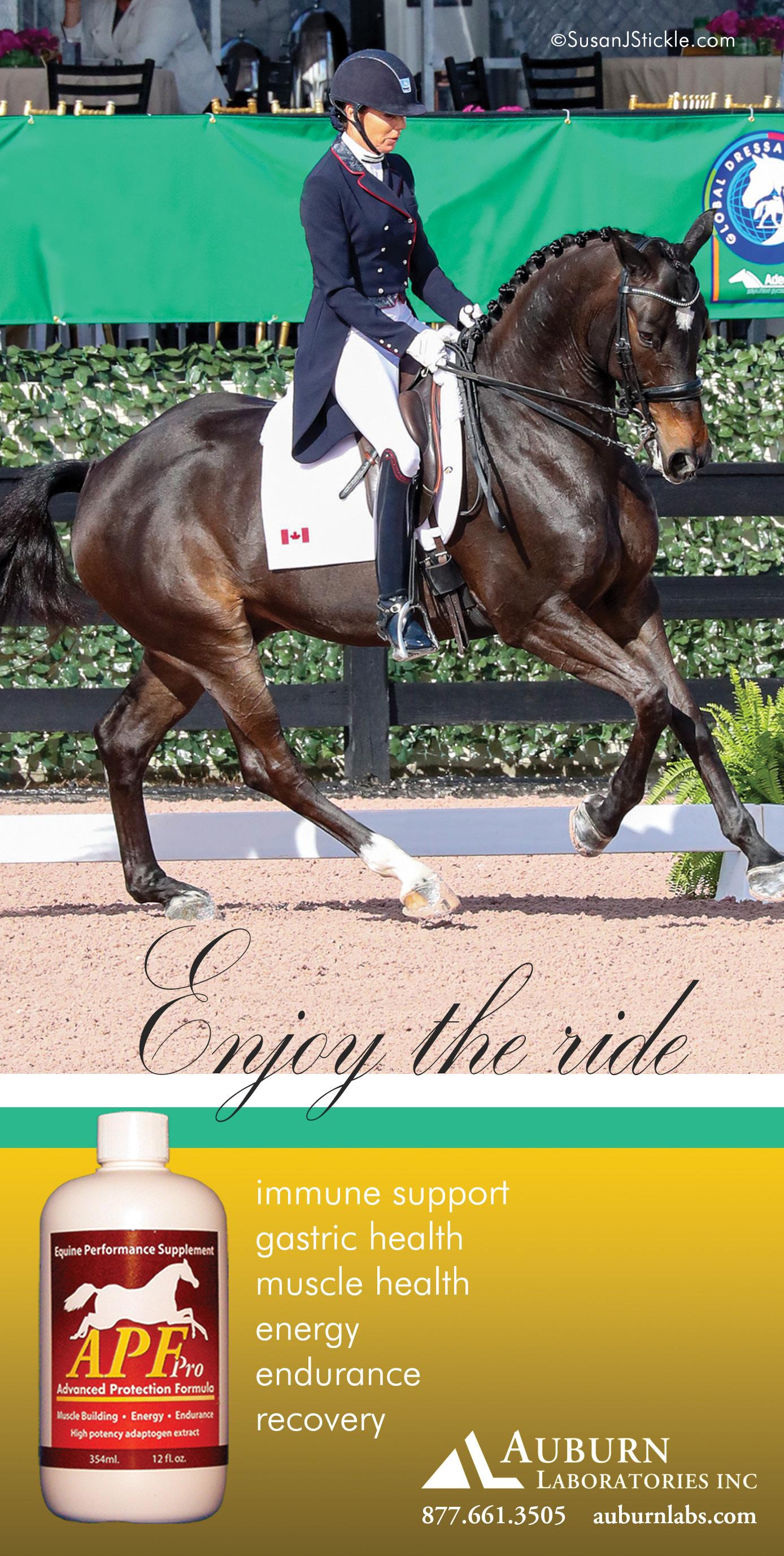
Sicoli says her desire to spend time with kids Hume, 7; Ina Maeve, 4; and Beatris, 1, has caused her to
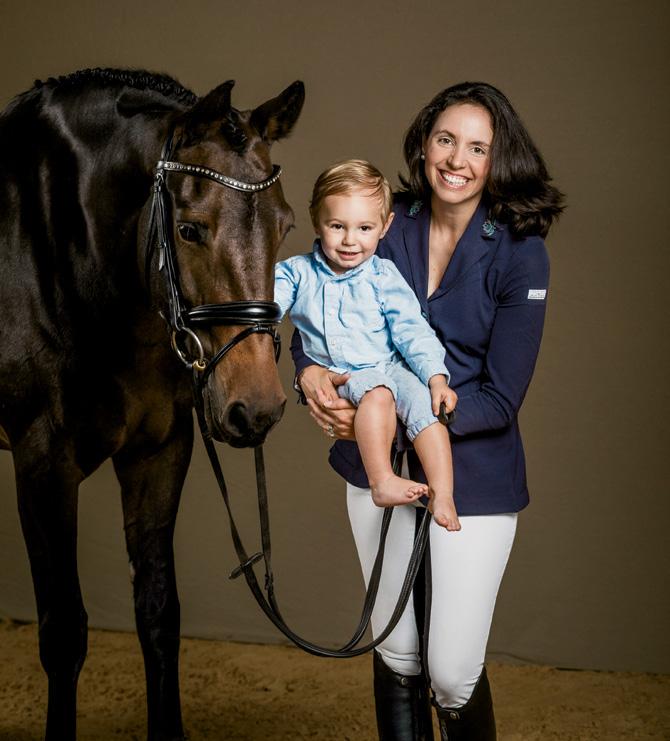
alter her judging and competition schedule, particularly for her own horses.
“It’s been hard to prepare for and engage in long competition weekends away,” she says. “I do expect, as the kids all begin school and get older, that it will be easier to compete more regularly.”
Finding reliable child care is a huge obstacle and cause of stress for nearly all working parents. In Sicoli’s experience, “There is always a solution, but it does take being flexible, including for emergencies, whether they are barn-related or familyrelated.”
When one or both parents are equestrian professionals, every day may be Take Your Child to Work Day. Sicoli’s eldest, Hume, loves horses and spent many of his infant and toddler days at the barn.
“I love that it was such a daily routine for him,” his mother says. “I was able to weave time with him into lunch or lessons.” Now that there are more kids, however, doing so is not as easy, and Ina Maeve and Beatris’s barn time is more structured, reserved for times when Sicoli is not working.
“All of our kids still love horses,” Sicoli says, “but Hume had the most natural introduction.”
Perry-Glass stresses the importance of building a support team. “For me, [I needed help with] the barn management and client scheduling,” she says. “I’m very blessed to have [rider, groom, and business operations manager] Meghan Laffin in my life. As much as I want to be communicating with everyone on everything, I have had to hand off most of it to her so I can focus on family time.”
Delegation isn’t always easy, especially for the typical type-A dressage enthusiast.
“It’s taken a lot for me to give up some control,” Perry-Glass admits, “but Meghan and I are in constant communication, so it works great. Plus, I trust her with my life and she
is pretty much family. Both she and Annie Phillips have really stepped up in the barn to not only be amazing high-performance grooms, but also great ‘barn aunties’ to Tru.”
The Lessons, the Joys, and Knowing When It’s Time Children, like horses, don’t come with a user’s manual. Things happen unexpectedly, and parents—like riders and horse owners—learn on the job. One of the lessons many of us have to learn, with both horses and kids, is that sometimes we need to let go and trust that things will be OK.
“I think if the journey with horses teaches us anything,” Sicoli says, “it’s to be flexible and let go of controlling everything. Life happens and horses happen, and it’s not always perfect or what we expected. I have had to learn to trust that it will work out.”
The values intrinsic in a career with horses can teach children important life lessons in an organic way, Sicoli believes.
“Raising our family on a farm has given the children important opportunities to watch us work, spend more time outdoors, learn about the cycle of life, appreciate nature, and understand the value of hobbies and sports,” she says. “Our barn community operates as a team, and that’s so important for kids to see.”
Perry-Glass celebrates the knowledge that Tru gets to see her parents doing what they love.
“I truly believe there is space in our lives for both [career and family],” she says. “The biggest joy is when I watch Tru’s face light up when she sees both Dana and I ride. I want to set an example for her to follow her goals and dreams.”
Another important lesson these moms have learned is to be kinder to themselves. If Perry-Glass had it to do over, she would be more patient and forgiving of herself through the pregnancy and postpartum time, explaining, “I was way too focused
on how people viewed me with gaining weight and not ‘bouncing back’ to the body I had before. I’m still not back to before, but I probably never will be, and I’m learning to embrace where I am now while staying healthy and strong.”
For Brock, self-care included taking charge of her own health. Some concerns prompted her to contact a hormone specialist when Noah was about nine months old. Blood work revealed that she was deficient in some vitamins and minerals, and “also uncovered some other underlying issues that were just minor enough that a general practitioner wouldn’t take it seriously enough to do something about,” she says. “It really helped me recover postpartum, and I feel great now.”
Having kids is a big step, but the dressage pros we talked to agree: If you truly want a family, then go for it.
“I love what I do—the training, teaching, and coaching,” says Brock. “And I love having our kids. My life is extremely full and rich with all the interactions I have with different horses, people, and my family. Just do it! There will never be a perfect time. And there will always be opportunities waiting for you.”
Sicoli concurs. “I see so many moms who ride and have careers in the horse world, and we all do it differently. I think people should feel confident to follow their own heart and goals. It’s like the adage for grade school: Not everyone will like you or agree with you. Build your own life and dreams, and those who want to follow and be part of it, will.”
Jennifer Mellace is a published author who writes about topics ranging from health and wellness to lifestyle and business. She lives in Frederick, Maryland, with her husband, two children, and three dogs. Visit her website at MellaceWrites.com.
To
DressageClinic.com
Educational videos from the top dressage trainers around the globe. 50% discount on membership

Luxury dressage boutique certain to delight the most discerning of dressage enthusiasts. $100 worth of free product by receiving a $50 member card two times per year
Dressage training video library with training advice and tips from the world’s most respected judges and trainers. 45% discount on membership video.dressagetodayonline.com


The Sport Horse Marketplace for listing your horses, finding your next equine partner, and posting your equestrian business or products locally and globally. USDF Members receive a 15% discount https://www.horses4yc.com/
H&C is the leading international equestrian sports network, available globally via connected TVs, mobile, and web and on leading digital and pay-TV platforms.

USDF Members receive a 15% discount on a subscription for H&C’s annual membership, H&C+ https://horseandcountry.tv/en-us/
Full line of exceptional products including dressage arenas, footing, horse jumps, and barn and stable equipment.
5% discount on all Premier Equestrian items www.dressagearena.net

Custom banners to fit every business need, budget, and size. 20% off all orders www.printastic.com

24/7 nationwide roadside assistance for you and your horse. Join USRider with no activation fee for a savings of $29 off the normal new membership rate www.usrider.org

In January 2020, adult-amateur dressage rider Sue Aquino received a call at home in Boston that her 22-year-old Dutch Warmblood cross, Flip, was showing signs of colic. When Aquino arrived at the barn, her veterinarian informed her that Flip wasn’t responding to medical treatment and should head to the equine hospital at Tufts University in nearby North Grafton, Massachusetts.
says Aquino, who reports that Flip indeed underwent surgery for what was diagnosed as a strangulating lipoma.
This condition is slow to develop, which is why it’s most often seen in older horses. And given the prevalence of mature mounts in our sport, it’s not surprising that veterinarians encounter higher numbers of lipoma cases in dressage horses. Here’s what you need to know.
soft tissue of the horse’s intestines— encircles the small intestine or, less commonly, the small colon.
“These tumors are common in horses older than age fifteen,” says Anje Bauck, DVM, PhD, DACVSLA, clinical assistant professor of large-animal surgery at the University of Florida College of Veterinary Medicine in Gainesville. “For the most part, these tumors sit in the abdomen and don’t cause any problems; but in some horses, the fat tumor can get wrapped around the intestine and cut off blood flow, causing an extremely painful and sometimes fatal type of colic.”
As the fatty mass dangles from the intestinal wall, “that stalk swings like a ball on a string and can go around the intestine, causing an obstruction,” says Wren Burnley, DVM, a USDF gold medalist who owns and operates Wrenwood Dressage in Fulton, Kentucky, with her husband, fellow trainer J. T. Burnley.
The operative word here is can. As Burnley puts it, “If you took a ball on a string—like a yo-yo, for example—and swung it around, it might wrap around something, but it also might not.”
KNOW YOUR HORSE: Is a daytime snooze typical, or it is cause for concern? Unusual behaviors could be a first sign of distress, so it’s important to know your horse’s norms.

Prior to accepting the referral, Tufts stipulated that Aquino consent to proceed with surgery if its veterinary staff deemed it necessary. “I had to make that decision ahead of time while I was still at the barn,”
Strangulating-lipoma colic occurs when what’s known as a pedunculated lipoma—a benign, slow-growing fatty tumor attached by a stalk to the
So what triggers the entrapment? A strangulating lipoma “is more likely to happen with movement and could include rolling,” says Burnley, “but the lipoma could also be there for years and never encircle the intestine. Age is the only predictive factor for strangulating lipomas.”
In fact, says Bauck, age is so correlated with the condition that a strangulating lipoma is top of mind at a veterinary hospital when an older horse is admitted for colic surgery.
STRANGULATING LIPOMA: A fatty tumor (arrow) has become wrapped around this horse’s intestine, cutting off circulation and causing a painful colic that can only be remedied with surgery
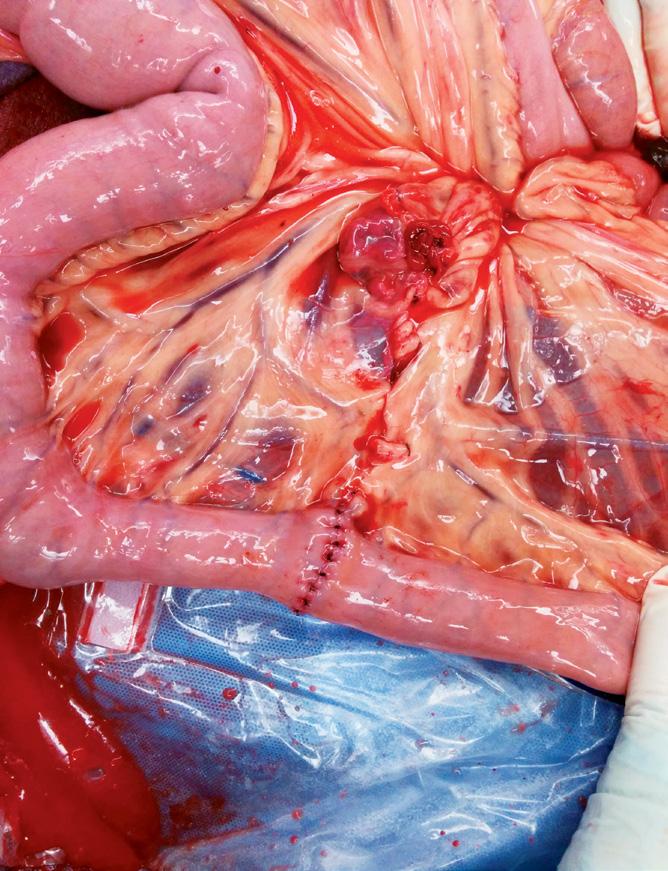
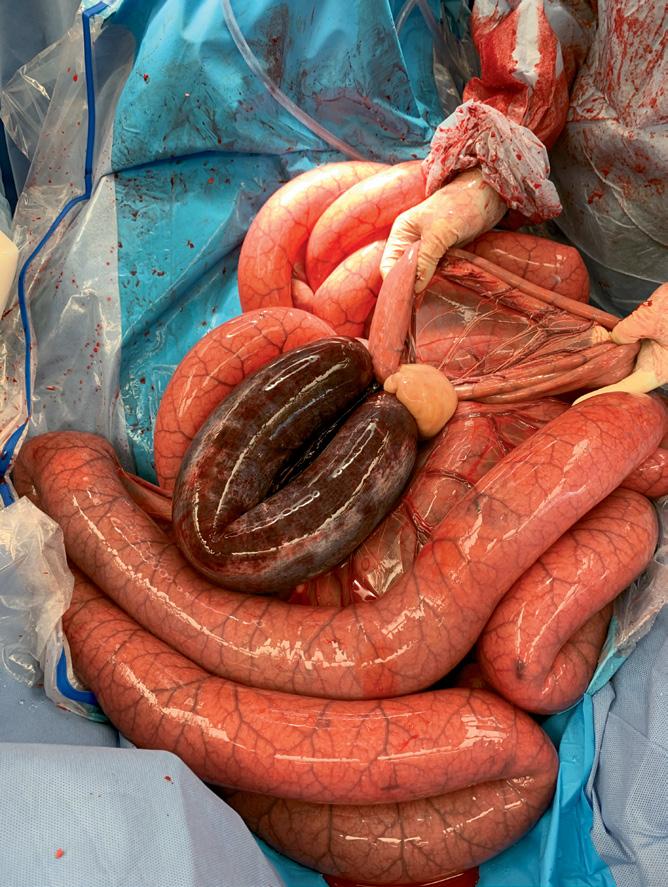
A horse with a strangulating lipoma may display typical colic-like symptoms, such as restlessness, lack of appetite, lack of interest, rolling, pawing, stretching out, looking at or biting the sides, sweating, failure to pass manure, an elevated heart rate, and a distended belly.
“It looks like colic, but the only thing that could separate this from any other colic would be unrelenting pain, even with drugs like Banamine,” says Burnley.
“Different horses will show different levels of pain; the hallmark is that the horses with strangulating lipoma will be persistently colicky,” Bauck says. “By that I mean, after a dose of Banamine, they might get a little more comfortable but will continue to show signs of colic through multiple rounds of analgesic drugs. In general, they tend to be more painful than other types of colic and may become dehydrated more quickly, so from an owner’s perspective, notable would be the persistency and severity of the signs of colic.”
The field veterinarian may use various tools in an attempt to diag-
nose the source of the horse’s belly pain, says Bauck. Options include a rectal examination; an abdominal ultrasound to look for distension of the small intestine, which is the most common area of the intestinal tract affected by lipomas; and extracting a sample of fluid from the abdomen, which some veterinarians can perform in the field but which more often than not takes place at a referral surgical center.
The only treatment recourse for a strangulating lipoma is surgery to remove the tumor and any associated damaged intestine. The good news is that “post-surgical prognosis is typically equal to any other colic procedure,” says Burnley. “Especially when we’re talking about older horses, we’re talking about their health status prior to surgery and how quickly they get to surgery. When these factors are good, we are more likely to have a good outcome.”
Adds Bauck: “As far as the overall success rate, the literature and my own personal experience tells us that about sixty to seventy percent of horses that undergo colic surgery for this condition would survive to hospital discharge. Depending on what section of the intestine is affected and how badly it is affected will determine the specifics of the type of surgery, but often these cases will require what we call a resection, where a section of the affected intestine has to be surgically removed, attaching the healthy bowel to itself. The specifics of the complication rates can depend on the type of surgery; it’s a major surgery and can certainly have complications in the immediate post-surgery period. However, many horses will do well if they are given the chance to go to surgery.”
Post-surgery, “there is the potential for a condition called postoperative reflux, where the fluid in the intestine and stomach build,” Bauck continues. “There are a variety of reasons the intestines may not move
RESECTION: If a section of bowel is damaged from strangulation, surgeons can excise that portion and reattach the healthy ends. Complications can arise, so it’s better to remove the lipoma before resection becomes necessary.
as well after surgery. Some horses get through it and the intestines are able to start working again properly, but a small percentage of horses will need to go back to surgery.
“If they survive the surgery and go home, they tend do really well; but there is a small percentage of horses that may experience longterm complications with the GI tract.”
Fortunately, for horses that undergo surgery for a strangulated lipoma, a repeat incidence is rare, according to Burnley. She explains that “While the surgeon is in the abdomen, all visible lipomas are removed, not just the one that’s strangulating the intestine. If the horse recovers, reoccurrence is less likely, as the visible lipomas have been removed.”
Given all this, wouldn’t preventive screening be a smart move, whether during annual wellness exams or as part of a prepurchase exam? Unfortunately, says Bauck, there are currently no diagnostics available to identify horses at risk. [
A2021 retrospective clinical study published in Equine Veterinary Journal examined data regarding risk factors and outcomes of colic cases caused by strangulating lipomas that required surgery. These statistics, gathered from post-anesthesia through end of life, indicate that older horses have similar survival rates as younger horses in the short term after such surgery and that, overall, horses that did not require resection (removal of damaged portion of intestine) had much stronger chances for long-term survival.
When owners hesitate in sending horses to surgery for strangulating lipoma, positive outcomes diminish.
“Any delay in colic surgery is going to increase the cost of treatment and decrease the success rate,” says study co-author David E. Freeman, MVB, PhD, Dipl. ACVS, Appleton Professor in Equine Surgery at the University of Florida College of Veterinary Medicine in Gainesville.
“This study demonstrates that horses that do not need a resection for a strangulating lesion do far better than horses that do,” Freeman says. “The message from this is simple: If horses undergo surgery as soon as possible, they may not need a resection and therefore have a better outcome. Any delay over 12 to 24 hours is going to push a horse that does not need a resection into the resection group, and will reduce the prognosis consequently.”
The study, “Effects of age, disease and anastomosis on shortand long-term survival after surgical correction of small intestinal strangulating diseases in 89 horses,” is available online on PubMed. Read the abstract at pubmed.ncbi.nlm. nih.gov/35023209/.
No horse owner likes to consider the possibility of a colic episode, but our experts recommend making a plan before a crisis is under way. Know your financial ability to cover a potentially costly surgery and hospital stay, whether you choose to purchase equine insurance or to selfinsure. Make sure your barn team knows your wishes in the event you aren’t present and can’t be reached.
If your horse is covered by insurance or a colic-surgery rebate program (such as SmartPak’s ColiCare or Platinum Performance Colic Coverage), know the coverage limits and requirements. Does the carrier need to be notified prior to referral to a surgical center? Is surgery required for a mortality-insurance payout in the event of colic? Is there specific language your veterinarian needs to include in the report? Be aware that carriers may exclude coverage for colic for horses over a certain age or that have experienced prior colic episodes.
“For insurance purposes, we have to be very specific about the time line and that the owner keeps the insurance agency in the loop, whether the horse needs colic surgery or is past being operable,” says Burnley. “What owners tend to learn too late is that they haven’t informed the insurance agency quickly enough that the vet has been called or the horse has been referred for surgery. Also, be sure to let your vet know your horse is covered.” When she’s treating a colic case, she herself will phone the insurance agency if the owner hasn’t done so yet.
On the Radar—or Not?
“Many horse owners don’t realize there are many different types of colic that can’t all be treated the same,” says Bauck. “Owners of horses older than fifteen should take signs of colic very seriously, as older horses are especially at risk for lipomas. This is different than an impaction that may be managed with medical therapy; this is a type of colic that
the only chance to save the horse’s life is surgery—and the faster we can get them into surgery, the better the chances of survival.”
“Spend time with and handle your horses every day,” Burnley advises. “The retired older pasture horse could be colicking and we might not notice it: They can be rather stoic, and they often nap in the sun. If something is not right and we miss the signs of colic early, the less positive the outcome is likely to be.”
“Over the course of this past year, I have heard many stories about people unexpectedly losing their more senior horses,” Aquino says. “They suspect that a strangulating lipoma was the cause, but without a necropsy, you don’t know for certain. I think many of us adult amateurs have never heard of this issue, although I now understand it is possibly the most common cause of death in older horses.”
As an aside, Burnley notes that horses aren’t the only animals that can experience pedunculated lipomas; many horse owners may be familiar with the condition in dogs.
“Lipomas are common in many animals as a benign mass of fat cells in its own fascial sac,” she says.
All’s Well That Ends Well Aquino is happy to report that Flip, who had never previously colicked, enjoyed a full recovery after surgery to remove a pedunculated lipoma twisted around his small colon, which thankfully did not require resection. The grateful owner is planning a Dressage Foundation Century Club ride for 2023, when Flip’s and her combined age will total 100.
Natalie DeFee Mendik is an awardwinning journalist specializing in equine media. Visit her online at MendikMedia.com.
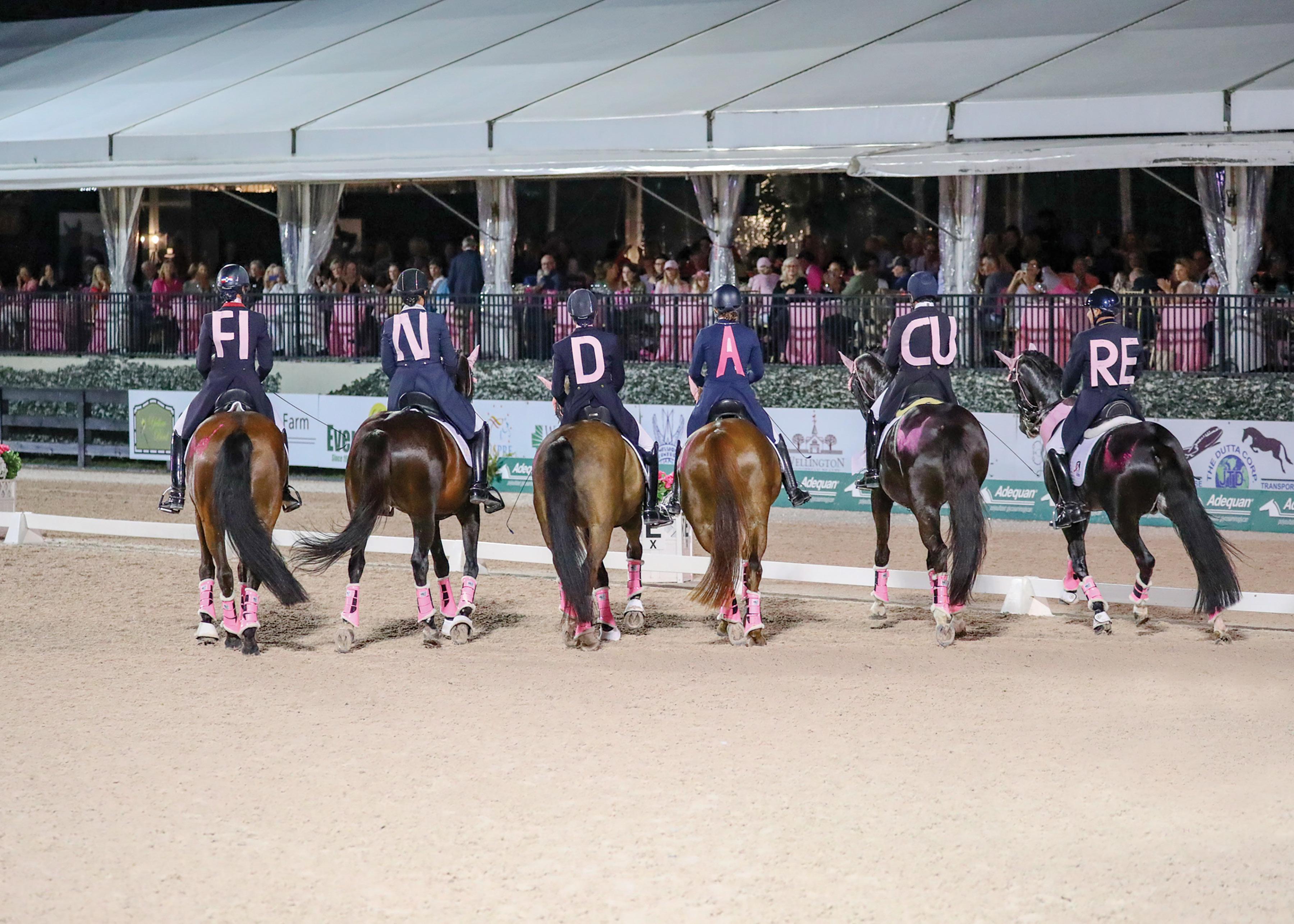
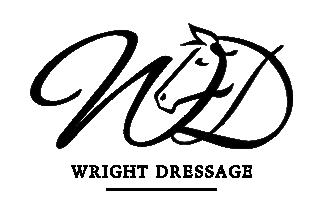
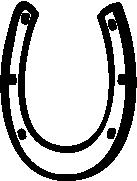



Dressage’s version of a rock star came to Mount Holyoke College Equestrian Center in South Hadley, Massachusetts, to headline the 2022 Absorbine/ New England Dressage Association (NEDA) Symposium, October 15-16.
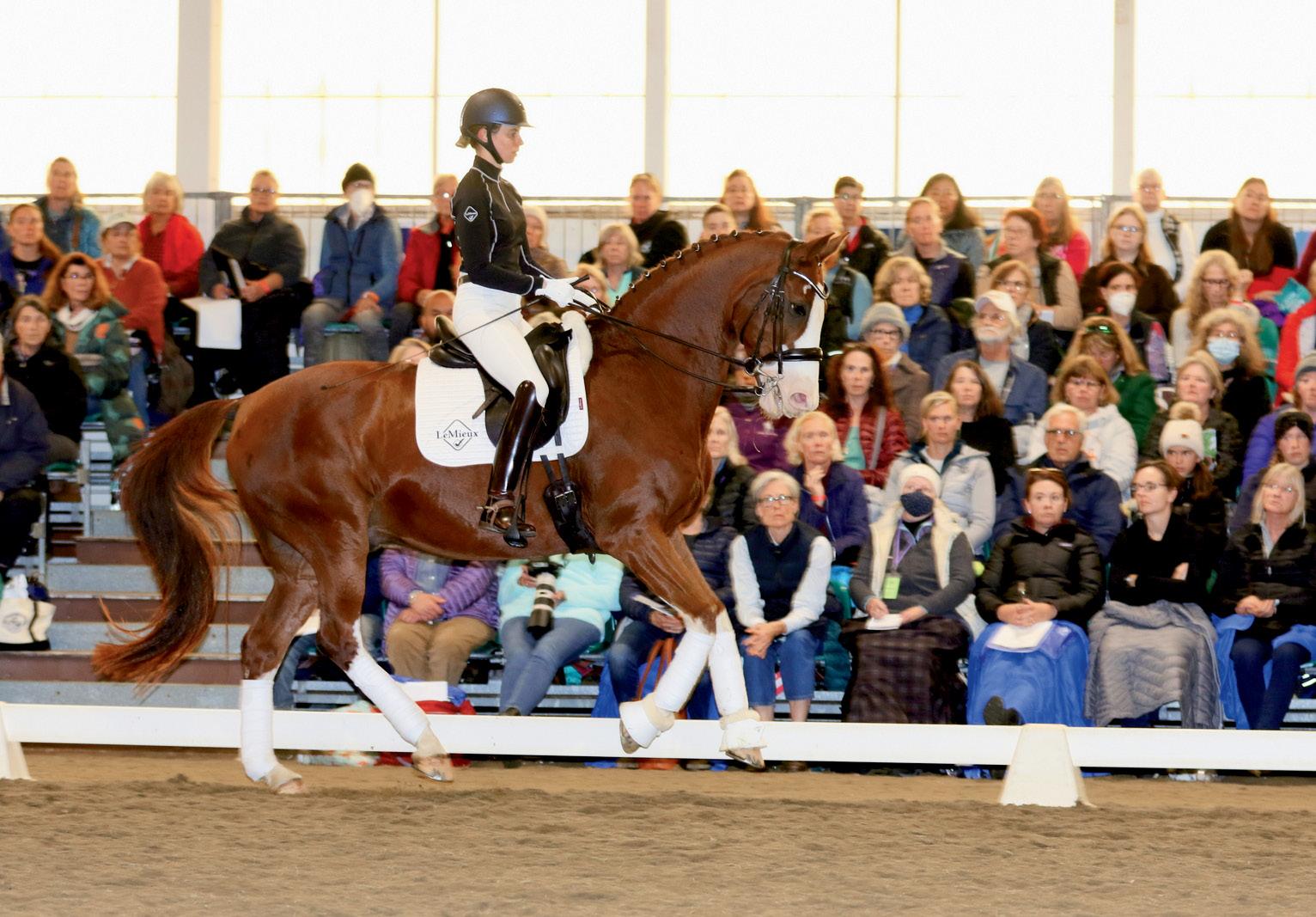
Carl Hester is the most successful British dressage competitor in history and a six-time Olympian, but that’s not the allure. It’s that, when Hester teaches, he puts the secrets of our sport into words—words that often paint a new picture and bring
able and makes it look, well, rather simple. Then, in his offhanded British way, Hester tells a little joke and admits that he, too, struggles sometimes.
“I don’t have the gold keys,” he said of that treasure box of secrets. “I teach what I’ve learned from others. It’s just hand-me-downs.”
From the NEDA symposium, here are 27 of Hester’s brilliant hand-me-downs.
ence (more than 700 were in attendance at Mount Holyoke each day) can be intimidating for a lone young horse, especially when the crowd laughs or applauds (and there was plenty of both). It was much easier for the young horses when each had a companion nearby. The point, said Hester, is to give the youngsters a good experience so they might learn something for their future.
a chuckle, as well. His “Carlisms” are disarming because dressage enthusiasts tend to be so serious, and then Hester says something rather simple about the unattainable—and then a rider who was struggling just yesterday demonstrates the unattain-
1. Young horses. Safety comes first with all horses, but especially with young horses. “You must be able to have contact, change gears, and have some kind of balance and control,” Hester said.
At the symposium, young horses demonstrated in pairs because they “get help from their friends.” An audi-
2. Are you shopping? Most dressage enthusiasts today are being forced to buy younger and younger horses in order to get both what they want and what they can afford, Hester said. So when you’re searching, keep your aim in mind.
“For me,” he said, “it’s quite easy because my goal is Grand Prix, and if you look at the Grand Prix test, you’ll see how many marks there are for the canter, so the horse must have a good canter in both directions. A poor walk can also ruin an otherwise good Grand Prix test. The trot is the pace we can change the easiest. If you want to compete at any level successfully, your horse can’t have a rhythm problem. It’s the beat that we look at, and the shape of the horse and the expression we can create within that beat.”
3. Horse management. At Hester’s yard in Gloucestershire, England, some of the horses live out and some live in, but they all get turnout. All horses school four days a week, hack two days, and have a day off. Hacks include hill work— “not enormous hills, but enough to open up the shoulders going down and develop pushing power going up. On work days, the horses are hacked; they stretch and do cantertrot transitions. Then I get on for a half-hour of schooling.”
“just hand-me-downs,”
4. Balance first. Hester wants all horses to move in a natural, relaxed, quiet way. Sometimes horses are ridden too forward to be able to maintain the balance. Hester explained that “if you drive when the horse isn’t in balance, you only drive him onto your hands.” He helps the horses to find their own balance with easy transitions: Walk, halt, walk. Trot, walk, halt. If a horse steps backward in the halt, Hester gently corrects him by riding forward to trot, then to a smaller trot, then to a small walk, and then to halt again.
“Those that are naturally balanced and move in an easy way are the easiest to keep sound,” he said, “so make sure your horse doesn’t move in a way that’s punishing to the body.”
5. The walk. Improvement in the walk comes from the horse using his head and neck. Be sure your horse isn’t nodding his head toward his knees at the moment when he should be reaching. “Imagine rowing the horse’s head away from you. Use your arms. Improving the walk is not about more leg. Use alternating leg aids, and push the head and neck out and away. Turning left and right encourages the horse to reach with his shoulders.
“When collecting, instead of thinking of collected walk, think of extended walk with contact and the poll up. Keep ‘rowing’ the head out.”
6. The aids. The most common advice dressage riders get is “inside leg to outside rein,” but Hester stressed that we must also remember “outside leg and inside rein” so that we can control the whole horse.


And:
• Turn from the outside aids.
• Give the rein often; if the contact is constant, the horse’s mouth gets a bit dry.
• If the reins get too long, your hands move backward and you end up riding from “front to back.” Keep your hands in front of the saddle.
• “As young riders, we were asked to lean over to the inside and look at the hind leg. It was a way of teaching us what the weight aids were.”
7. Rider position. If your horse were to disappear from beneath you as you rode, would you land on your feet or on your bum? “That’s a good way to think of how you need to sit on a horse,” Hester said. “Sit like you stand on the ground. Your body needs to be balanced over your feet.”
“Carry your thumbs up, and your right hand must be married to your left hand.”
In the half-halt, make the front of your body longer than the back.
The rider’s upper body often needs to be inclined more forward. Hester explained: “When you watch a downhill skier, he brings his upper body forward when he wants to go forward, and when he wants to come back, it comes a bit back. I want to see the rider’s upper body go forward when the horse goes forward.”
8. Incorrect riding. Horses don’t always show “resistance” when there’s a problem with the riding. Sometimes, Hester said, they’re just resigned to the problem.
9. Rising trot. “Rising to the trot helps the horse understand rhythm.
Rhythm is the foundation of the scale of training.”
10. Half-transitions. If you only go forward, you end up riding your horse “downhill” with his hind legs out behind. Balance him with what Hester called half-transitions: by bringing him back and almost doing a downward transition. You might sit for a few trot strides, or go almost to walk. In that moment, you gain control of the hind legs, and then you go forward again and “open the door.”
“If you don’t have [control of] the hind leg before you go forward, the transition doesn’t help the balance,” Hester explained.
11. Transitions. The purpose of transitions is “to keep the horse interested, on the aids and in balance. How many should you do? It depends, but within minutes you might do 30 or 40. It’s important that you have the ability to shorten the stride before you make a downward transition. Then, every time the horse does a transition, he takes the weight behind.”
12. “Swing speed.” Hester used this term to refer to the tempo of the gait at which the horse’s back can swing, meaning that “the tail and the back swing rhythmically, and there is expression and positive tension in rhythm.” Going faster than the “swing speed,” he said, creates tension. [
Thanks to the New England Dressage Association; to 2022 symposium organizer Beth Beukema; to Mount Holyoke College director of riding Paula Pierce; and to the demonstration riders, horses, and owners: Katie Bachli, Clinton Corners, New York, riding her own Forever P, a fouryear-old Hanoverian mare (For Compliment x De Niro) bred by Prosperity Farm
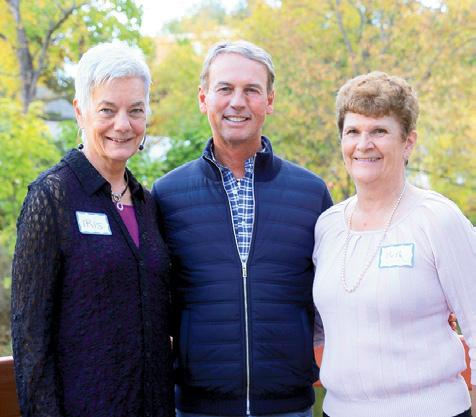
Courtney Bolender, North Salem, New York, riding her own six-year-old Hanoverian mare, Isolde (Fürstenball x De Niro)
Leah Drew, Lincoln, Massachusetts, riding the 12-year-old Hanoverian gelding Jazz Beat (Jazz x Sandro Hit), owned by Berryfield LLC
Shannon Dueck, Loxahatchee, Florida, riding the seven-year-old Oldenburg mare Angelika MW (Franziskus x Welt Hit), owned by the Ayscha’s Angels Syndicate
Kevin Hadfield, Mendon, Massachusetts, riding his own four-yearold Oldenburg gelding, Fine Royal (Feinrich x Rubin Royal)
McKayla Hohmann, Colfax, Wisconsin, riding the 21-year-old KWPN gelding Numberto (Negro x Ahorn), owned by Elisabeth Austin
demonstration riders Kevin Hadfield, Katie Bachli, Courtney Bolender, Shannon Dueck, Olivia LaGoy-Weltz, Mica Mabragaña, Lillian Simons, Jocelyn Kraenzle, Lauren Sammis, McKayla Hohmann, Katie Robicheaux, Leah Drew, and Jordan LaPlaca
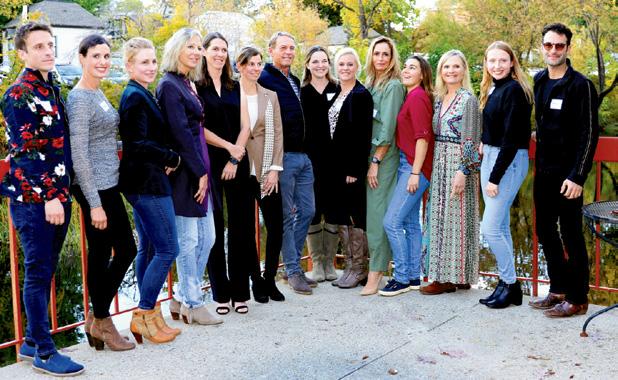
Jocelyn Kraenzle, Slatington, Pennsylvania, riding the eight-year-old Oldenburg mare Shurreal (Sezuan x Royal Prince), bred and owned by Rolling Stone Farm
Olivia LaGoy-Weltz, Haymarket, Virginia, riding the seven-year-old Hanoverian mare Fade to Black (Fantastic 33 x St. Moritz 3), owned by Mary Anne McPhail
Jordan LaPlaca, Ledyard, Connecticut, riding the seven-year-old Oldenburg gelding Gold Play (Grey Flannell x Sir Donnerhall), owned by Nancy Hutson
Mica Mabragaña, North Salem, New York, riding the 12-year-old Hanoverian gelding Diamond Rosso (by Diamond Hit), owned by Marjaleena Berger
Katie Robicheaux, Plainville, Massachusetts, riding the 13-year-old Danish Warmblood mare Mølgaards Rafiness (Skovens Rafael x Ibi Light), owned by Lucy Koerne
Lauren Sammis, Pittstown, New Jersey, riding the seven-year-old Danish Warmblood mare Heiline’s Oh Land (Goldfinger VDT x Diamond Hit), owned by Peggy Gordon
Lillian Simons, Sharon, Connecticut, and Hosanna LHF, a five-year-old Oldenburg mare (Hotline x Shakespeare RSF) bred by Rolling Stone Farm and owned by Lillian and Wesley Dunham.
13. Trot-canter-trot transitions These transitions develop connection and throughness. If your horse comes above the bit in a canter depart, don’t be obsessed with it. Instead, “Be obsessed with not interfering with your inside hand. Pat your horse on the inside of the neck to release. Aim to be able to do the transition from canter to trot without your hands or at least with your hands in the same place.”
14. Canter-walk-canter transitions. These transitions develop collection. The first stride of canter must be forward and up in the withers. In preparation for the downward transition to walk, bring the canter almost on the spot. “The last stride before walk must be without contact. Release your hands at that moment.”
15. Collected and medium trots. The amount of impulsion in the collected trot is similar to that in medium trot. “You want to feel that you can get a medium trot in one step. It’s not a change in energy. It’s a change in the length of stride.”
16. Suppleness. You can’t make a horse supple if he’s in the same position all the time. Move him around: Stretch, collect, bend, and straighten. Then do it again. “Go forward and back until your horse is an elastic ball that becomes more willing, quicker, and more forwardthinking.”
17. Straightness forever. “We work on straightness all our lives. The solution is always shoulder-fore. You just keep placing the inside hind leg under the center until the horse is aligned. He can’t collect if he’s not straight.”
18. Corners. “Everything we do happens from a corner. Ride corners.”
19. Leg-yield. There is no bend in leg-yield. If the horse is bent left, for example, he will drift right. He should be flexed at the poll but straight in the body. Then he should go sideways from your inside leg, not from your rein. The rider’s active leg
should “breathe,” pressing and then releasing, rather than being strong or gripping.
“A breathing leg puts the horse in front of the leg, as opposed to on the leg,” Hester said.
Leg-yielding in canter is an excellent exercise, although it’s not in any dressage test, he added. It opens up the canter and encourages the horse to reach more.
20. Stretching. Stretching is both a physical and a mental exercise. It gets the horse’s back swinging so that he uses his body in a way in which everything is moving. Done correctly, the stretching horse moves naturally and in self-carriage on a long (not loose) rein.
When you lengthen the reins, check to see that your horse’s neck goes both forward and downward.
“The stretch is in many tests now,” Hester noted. “If your horse has trouble stretching, you’re going to have a better chance at the end of the session when he’s tired and wants to relax his neck down.”
21. Behind the leg. It’s tempting to ride too much forward when you feel that the horse is going to break gait or that he is not in front of the leg. Instead, Hester advised, “Do the opposite. The horse needs to be balanced and become hotter in collection.”
22. Practice the center line and halt. The first thing you have to do in a dressage test is enter, halt, and stand still. That’s not always easy, especially when you’re competing in front of a crowd.

“The warmup at the World Cup [Dressage Final] is indoors and quiet.” Hester said. “Then you go down the chute to 25,000 cheering fans, and you have 40 seconds to go down the center line.” To prepare, “My students and I ride the beginning of the test and the end of the test every day. Then at a competition it’s easier.”
In addition, make a habit of standing square and still—no sloppy halts. “When I was a young rider, my horse had to stand square before I got on, before I got off, and when I was just talking to my trainer. That was drilled in.”
23. The horse’s frame. “If I put an imaginary glass of water between your horse’s ears, I don’t want it to see the water dribble down in front of the horse,” Hester said. “If you ride in a short-necked balance, you can be sure the weight of the horse ends up in your hands. If you have wrinkles in front of the saddle, the horse is retracting his neck. The horse should be wide at the base of his neck. Look in the mirror: The throatlatch should be shaped like a U, not like a V.”
24. Be accurate. “That’s a shocking circle,” Hester said to one rider. “You’ll find that when you’re accurate with the circle, you won’t need your hands so much.”
25. The curb. When riding in a double bridle, the curb rein shouldn’t be the dominant rein. “When the horse feels the curb, he’s inclined to lie on your hand,” Hester explained. “You can’t raise the poll and you can’t make the horse light with the curb.”
26. Self-carriage. “You don’t need a trainer to tell you to give and retake the reins. Do it on your own. If the weight in your reins is light enough, you can give without losing the frame of the horse.”
27. Improve by doing. “We all get to be better riders by riding. Lots of people without a great seat get a great seat just by working on it.”
Beth Baumert is a USDFcertified instructor/trainer through Fourth Level, a USDF L program graduate with distinction, and the author of When Two Spines Align: Dressage Dynamics and How Two Minds Meet: The Mental Dynamics of Dressage She is the current president of The Dressage Foundation. For many years she owned and operated Cloverlea Dressage in Columbia, Connecticut, and served as the technical editor of Dressage Today magazine. She divides her time between Connecticut and Florida.
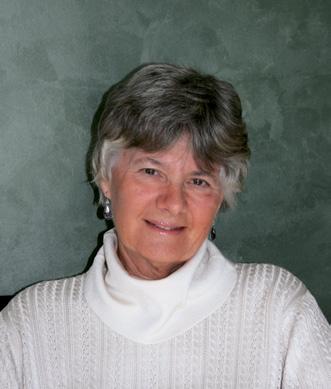
The USDF was founded as a federation of dressage clubs. Meet the charter GMOs that are still in existence today.
Edited by Jennifer O. Bryant
In February 1973, dressage enthusiasts from around the country convened in Lincoln, Nebraska, to organize the USDF as the first US national organization devoted exclusively to dressage.
By the time of the USDF’s inaugural business meeting in November 1973, a total of 26 clubs had signed on as USDF affiliate organizations, earning the distinction of calling themselves charter
Delaware Valley Combined Training Association
Dressage and Combined Training Association (later Central States Dressage and Combined Training Association, and now Central States Dressage & Eventing Association)
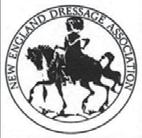

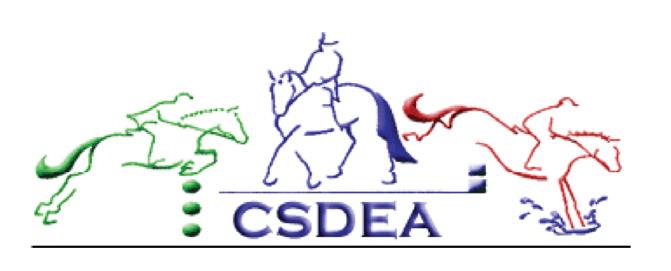
Eastern States Dressage Association (now DCTA)

Equestrians’ Institute (Washington state)

Florida Dressage Society

Illinois Dressage Association (now DCTA)
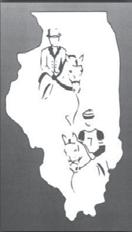
Indiana Dressage Association (now Society)

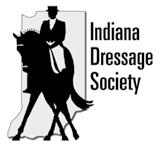
International Equestrian Association (Pennsylvania)
Kansas City Dressage Society

Long Island Dressage and Combined Training Association
Midwest Dressage Association Nebraska Dressage Association New England Dressage Association
Ohio Valley Dressage and Combined Training Association

Oregon Dressage Society
Potomac Valley Dressage Association
Rocky Mountain Dressage Society

St. Louis Area Dressage Society
The organization was established as a federation of local and regional dressage organizations.

Members of those clubs, the USDF founders decided, would automatically become members of the newly created national organization. The clubs that affiliated with USDF were therefore called group-member organizations, or GMOs.
GMOs. Some have since disbanded, changed their names, or been absorbed into other GMOs.
The charter GMOs were: Andover (Massachusetts) Dressage Club
California Dressage Society Deep South Dressage Association (now Dressage and Combined Training Association)


Texas Dressage Society (now Alamo Dressage Association)
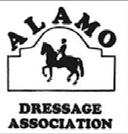
Virginia Dressage Association
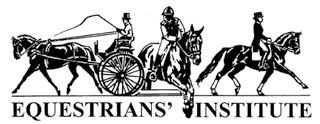
Westchester-Fairfield Dressage Association

Winds Reach Dressage and Combined Training Association (now Eastern Iowa Dressage & Eventing Association)
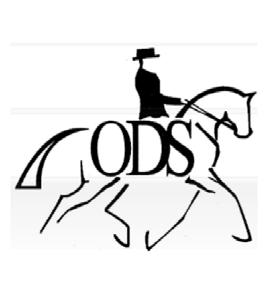

Wisconsin Dressage Association (now DCTA).

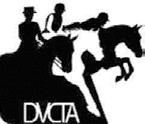
Of those original 26, 22 still exist today. Let’s learn a little bit about the history of these pioneering GMOs.
Alamo Dressage Association
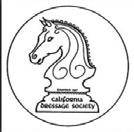

Where: Primarily Texas Current membership*: 88
About seven people met in San Antonio, Texas, in 1972 with the intention of starting a dressage club. Among them were Cindy Joiner; Lorrell Joiner, who was elected the group’s first president; and Lisa Russell, wife of 1952 US Olympic show-jumping team bronze medalist Col. John Russell. The founders named their club the Texas Dressage Society because it was the first dressage organization in the state of Texas—the first one, in fact, in the entire area now known as USDF Region 9.
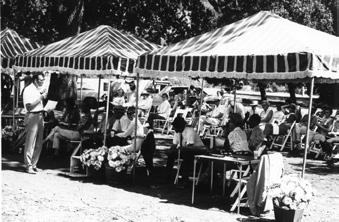
Then-US national dressage team coach Col. Bengt Ljungquist often traveled to Texas to assist the fledgling club by offering dressage clinics, helping with organization, and teaching members how to organize dressage shows. In its early years, the GMO hosted dressage shows that were large for the era. In 1974, Californian Hilda Gurney gave a demonstration ride aboard her famous partner, Keen.
In 1981, the organization was rechristened the Alamo Dressage Association (ADA). Today, the ADA hosts schooling and recognized shows as well as clinics and other educational opportunities (next up is a mounted clinic and judge-education event with FEI 4* dressage judge Cesar Torrente this February). The GMO maintains a dedicated Facebook page for youth members. The ADA also offers awards for volunteers and sponsors as well as for achievement at recognized, schooling, and virtual shows.
* GMO membership numbers reflect USDF data on file as of November 2022.
Freestyle and Western dressage awards are also offered.
Learn more: AlamoDressage.org.
California Dressage Society Where: Primarily California and Nevada
Current membership: 2,639
There are large GMOs, and then there’s the California Dressage Society (CDS).
The USDF’s largest GMO has 29 chapters (including a Las Vegas chapter and one for out-of-state members), almost too many activities to mention, and a central office to keep track of it all. It’s hard to believe that this huge organization started with just seven people.
CDS was the first GMO to offer judges’ forums, championship-show divisions for amateur riders, a futurity competition for young dressage horses, championships for junior riders, an instructor-training program, and regional competitions for adult amateurs. Today the CDS Annual Championship Show remains the GMO’s flagship competition, along with the CDS Regional Adult Amateur Competition and the CDS Junior Championships. The CDS Annual Meeting, featuring a symposium, is a big draw. There are clinic series, a quadrille program, and prestigious year-end awards. Each chapter also sponsors its own activities and awards.
Learn more: California-Dressage. org.
Where: Minnesota, Wisconsin, Iowa, North Dakota, and South Dakota Current membership: 383
Those seven—who included future Olympian Hilda Gurney— met in 1967 at the home of the late trainer and judge (and USDF Lifetime Achievement Award recipient) Elizabeth Searle and fellow judge Hermann Friedlaender. The following year, CDS held its first official activity: a dinner to honor Kyra Downton, the first Grand Prix-level rider in California, who in 2002 was posthumously inducted into the Roemer Foundation/USDF Hall of Fame.
Five CDS board members attended the USDF founding meeting in 1973, among them then-CDS president Stephen Schwartz, who went on to become USDF’s first president.
The GMO now known as the Central States Dressage & Eventing Association (CSDEA) was founded in September 1970 as the Dressage and Combined Training Association. The group consisted of 128 members throughout the states of Minnesota, Wisconsin, Iowa, Nebraska, Kansas, Illinois, and Michigan.
Today the CSDEA is an active single-chapter GMO that offers clinics and other educational events, a youth program, recognized and unrecognized dressage shows and horse trials, tack swaps, and social events. The CSDEA Dressage Festival and Championships is an annual highlight. GMO members can qualify for dressage and eventing year-end awards, and there is a volunteer-recognition program, the capstone of which is the annual Von Bluecher Award, presented at the CSDEA awards banquet to an out-

standing volunteer and named for the inaugural 1989 recipients, Max and Karin Von Bluecher.
Learn more: CSDEA.org.
Deep South Dressage & Combined Training Association
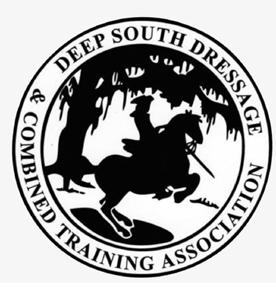
Where: Primarily the Florida Panhandle and southern Alabama and Georgia
Current membership: 113 Ann Ticehurst, a Florida-based dressage instructor and judge, had been studying dressage with Col. Hans Handler, then director of the Spanish Riding School of Vienna. Ticehurst arranged for Handler’s son, Michael Handler, to conduct a weeklong clinic in Florida in September 1971. The clinic attracted twelve riders from across the South, who were so impressed that they decided to form a dressage organization. They chose the name Deep South to reflect their varied locations.
Today the Deep South DCTA has four chapters: Emerald Coast (the

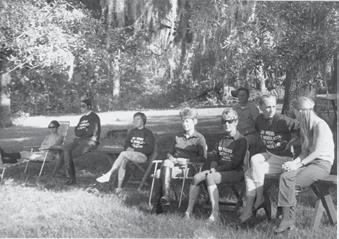
Delaware Valley Combined Training Association
Where: Pennsylvania, Delaware, Maryland, and New Jersey Current membership: 204
In 1965, in Chester County in southeastern Pennsylvania, several Pony Club moms including Archie Leidy, Jeanne Braceland, Jill Willcox, and Sheila Wall Hundt decided to start a “Pony Club for adults.” They reached out to the wider horse community, sponsoring schooling shows and horse trials.
One Delaware Valley Combined Training Association (DVCTA) dressage show outgrew its early base at Willcox’s farm; after a stint at the Radnor Hunt Club in the early 1970s, it moved to the Devon Horse Show grounds in 1975 and was christened Dressage at Devon. About the same time, one of DVCTA’s horse trials grew into the Chesterland Three-Day Event. The club’s early emphasis was on eventing; as open space became scarcer, dressage became more of a focus.
As of 2006, Dressage at Devon is its own entity, separate from DVCTA, although many volunteers are DVCTA members, and the DVCTA’s Quad Squad quadrille team regularly performs at the show. Other GMO activities include schooling and recognized dressage shows, dressage and jumping clinics, and support for junior and adult teams.
Learn more: DVCTA.org.
GMO’s oldest remaining chapter), Florabama, Northwest Florida, and Suwannee Valley. GMO members enjoy access to clinics; schooling and recognized shows; and awards for service and volunteerism as well as for year-end achievement in dressage, eventing, and Western dressage.
Learn more: DeepSouthDressage.com.
Eastern Iowa Dressage & Eventing Association
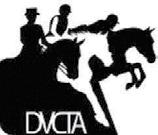
Where: Primarily eastern Iowa Current membership: 55
Transplanted to Iowa from her native Baltimore, equine enthusiast Betsy Coester founded Winds Reach Farm in Iowa City in 1956. The selftaught dressage rider and trainer did well enough that she garnered a
mention in a 1961 issue of Sports Illustrated, the magazine’s “Pat on the Back” item stating in part that “Mrs. Coester filled her bookshelves with the equestrian equivalent of Fanny Farmer and went to work learning to train Iowa horses from the printed page. She did so well at the job that today she has a stable of 42 trained show horses, at least two of which are good enough to compete nationally.”
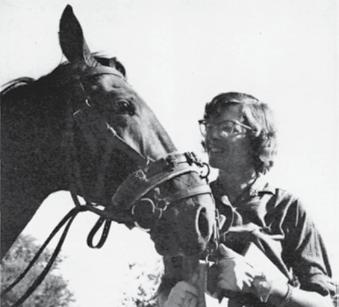
Coester and other area dressage enthusiasts founded a dressage club in 1972, named Winds Reach Dressage. Coester attended the USDF founding meeting in 1973, and the club—later renamed the Eastern Iowa Dressage & Eventing Association—became a charter GMO.
The small GMO has revitalized itself in recent years. Volunteers including former EIDEA president and marketing pro Jean Rude reversed a downward membership trend by introducing creative initiatives and events, both in-person and virtual. The club organizes an impressive lineup of educational events, some of which are held at Winds Reach Farm, which remains in the Coester family.
Learn more: EasternIowaDressageandEventing.com.

Where: New Jersey and surrounding areas
Current membership: 395
The late USDF Lifetime Achievement Award recipient Lazelle Knocke and the late Roemer Foundation/USDF Hall of Fame inductee Capt. John H. “Jack” Fritz are among the prominent founding members of the club established as the Eastern States Dressage Association. The New Jersey-based GMO launched in 1969, with Knocke’s husband, Fred Knocke, as its first president.
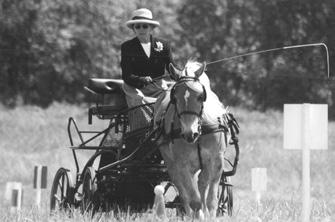
For years, ESDCTA’s major activities centered around the US Equestrian Team Foundation headquarters in Gladstone, New Jersey, which once boasted an impressive cross-country course as well as the iconic Hamilton Farm stables and stone-walled outdoor arena. Much of the facility’s land was sold off in the 1990s, but ESDCTA still holds dressage shows in the Dick and Jane Brown Arena. Eventing competitions and some ESDCTA dressage shows are now held at the Horse Park of New Jersey in Allentown; a planned July 2022 CDI (FEIrecognized dressage competition) was canceled, although the nationallevel show was held. The GMO also offers a variety of grants, awards, and educational opportunities for youth and adult members.
Learn more: ESDCTA.org.
Equestrians’ Institute
Where: The Pacific Northwest
Current membership: 285
By 1974, a group of western Washington state parents who’d
started a Pony Club chapter back in 1960 decided to establish a similar “horsemastership” club for adults, which they called Equestrians’ Institute (EI).
to form a GMO of their own, the Illinois Dressage Association. The name changed to the Illinois Dressage and Combined Training Association in the mid-1980s when the state’s dressage and eventing organizations merged to strengthen both clubs economically.
Along with dressage and eventing, driving has always been part of EI’s business model. Members of a certain age have fond memories of an annual Christmas party and parade of decorated horses, ponies, and carriages. EI still hosts an annual recognized combined-driving event and driving clinics, often held at Donida Farm Equestrian Center in Auburn, Washington. An “Everything but the Kitchen Sink Weekend” features schooling and lesson opportunities, a driving derby, a dressage festival, and events for drivers, all at Donida Farm.
For the dressage enthusiasts, there are recognized and schooling shows as well as clinics and other educational events. The eventers get a horse trials and combined tests. EI now also offers sport-horse education, and the GMO offers scholarships as well as year-end awards for driving, eventing, and dressage.
Learn more: EINW.org.
Illinois Dressage and Combined Training Association
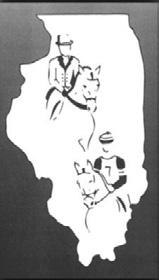
Where: Primarily Illinois Current membership: 236
The Illinois Dressage and Combined Training Association (IDCTA) was created in 1972. Within a year, the club’s founders attended USDF’s organizational meetings and decided
Today the IDCTA hosts a full spectrum of dressage and eventing competitions and educational events. There are awards (dressage, eventing, and Western dressage), scholarships, and more.
Learn more: IDCTA.org.
Indiana Dressage Society
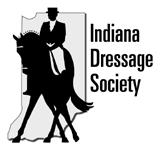
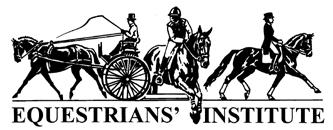
Where: Primarily Indiana Current membership: 235
Founding members Dan and Melba Kirtley discovered dressage in the late 1960s while Dan’s Navy unit was stationed in Colombia. On their return home to Indiana, they found a group of Hoosiers who were just learning about dressage themselves, and formed the Indiana Dressage Society (IDS) in 1972.
Dan Kirtley was the IDS’s official delegate at USDF’s organizational meeting in 1973. Fellow IDS member and lawyer George Glass served on the committee that drew up the USDF bylaws.
Today, many IDS events are
Online Extra
The Indiana Dressage Society celebrated its 50th anniversary in 2022. Watch the GMO’s anniversary video, Grass Roots to Grand Prix.
held at the Hoosier Horse Park in Nineveh, Indiana, south of Indianapolis. The 200-plus-acre facility includes a cross-country course and was the site of the 1987 Pan American Games equestrian events.
A mixture of educational events and schooling and recognized shows, including the Indy Dressage Classic I & II, keeps the IDS vibrant and active today.
Learn more: IndianaDressage.org.
International Equestrian Organization
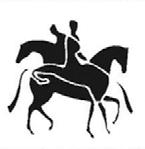
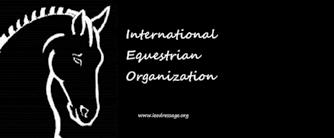
Where: Primarily central Pennsylvania Current membership: 67
size and influence. Today the IEO is a small GMO with a big name that speaks to the vision and determination of its founder. The IEO continues to serve its community with a series of schooling shows—in a sign of changing times, the shows are recognized by North American Western Dressage—as well as educational opportunities, youth activities, and year-end awards.
Learn more: IEODressage.org.
Kansas City Dressage Society

Where: Primarily western Missouri and eastern Kansas Current membership: 102
on the needs of the dressage enthusiasts who live there.
Where is the birthplace of dressage in the United States? If you guessed California or somewhere in New England, you’d be wrong. The central-Pennsylvania town of York arguably holds that distinction, as the location of America’s first dressage club and USDF’s oldest GMO.
The late champion equestrian (she excelled in both dressage and jumping, as well as in exhibition riding) Lilian Wittmack Roye emigrated from her native Denmark to the US in 1949 on a one-year contract with Ringling Brothers and Barnum & Bailey Circus. After her circus career ended, Roye settled in York, where her Bri-Mar Stables became an early equestrian training center. In 1955, she organized one of this country’s first dressage shows, and she was instrumental in founding the International Equestrian Organization (IEO) in 1958. In 1976, the IEO hosted the first CDI in this country. Roye was posthumously inducted into the Roemer Foundation/USDF Hall of Fame in 2016.
As dressage took hold elsewhere in the country, other shows and training facilities eclipsed York in
In 1967, dressage enthusiasts including Arlene Rigdon, Lois Arnold, and Linda Landers began an equestrian study group. The gatherings grew, and in 1973 the group established the Kansas City Dressage Society (KCDS).
At the time, KCDS was one of the largest dressage organizations in the US, and it signed on as a USDF charter GMO that same year. Many of KCDS’s founding members were instrumental in establishing the USDF and its original set of bylaws.
Today the KCDS offers a wide spectrum of activities to its members—among them, dressage schooling and recognized shows, clinics, year-end awards and an awards party, and online social and discussion events.
Learn more: KCDressage.org.
Long Island Dressage Association
Where: Primarily New York’s Long Island
Current membership: 26
Long Island is part of New York state, of course, but its physical separation makes it ripe for an organization focusing
In 1974, most such enthusiasts in the area were actually eventers who were looking to better their dressage scores. One of the trainers they turned to was Swedish-born rider/ trainer (and now FEI 5* dressage judge) Anne Gribbons, who with husband David Gribbons owned Knoll Farm, a dressage training/ boarding and warmblood breeding facility in Brentwood. Recognizing the need for an organization, the Gribbonses founded the Long Island Dressage and Combined Training Association (LIDCTA). Knoll Farm and the LIDCTA hosted shows and clinics with such dressage luminaries as Vladimir Littauer (The Development of Modern Riding).
At the time that future Roemer Foundation/USDF Hall of Fame member Graf George won team bronze at the 1992 Olympics with rider Michael Poulin, he was owned by LIDCTA member Dee Muma.
In 2001, the Gribbonses sold the Long Island farm and relocated their operation to Florida. The GMO, which has since changed its name to the Long Island Dressage Association, still offers clinics, shows, and year-end awards to its members.
Learn more: LIDressage.com.
Midwest Dressage Association

Where: Primarily Michigan
Current membership: 194
The state of Michigan was home to several dressage pioneers and pioneering accomplishments, many of which happened under the auspices of the Midwest Dressage Association (MDA).
Founded in 1969, the MDA played an important role in advancing dressage education. Early members included the late trainer
EDUCATION STANDOUT: MDA member Violet Hopkins founded the USDF/Hopkins National Seminar for Instructors (now USDF FEI-Level Trainers’ Conference), which were held at her Tristan Oaks Farm. The late Col. Anders Lindgren demonstrates at the 1985 Hopkins seminar.
and USDF founding member Chuck Grant and the late rider/trainer Violet Hopkins, whose instructor seminars at her Tristan Oaks Farm in Union Lake later became the USDF FEI-Level Trainers Conference. Both Grant and Hopkins were among the earliest inductees into the Roemer Foundation/USDF Hall of Fame. They have since been joined by MDA members the late Maj. Robert Borg, who coached US dressage and eventing competitors at three Olympic Games and who won dressage team silver in London 1948; and world-renowned equinebiomechanics expert and inaugural Michigan State University McPhail Dressage Chairholder Dr. Hilary Clayton. Other notable current or former MDA members—who are also members of the MDA’s own Hall of Fame—are dressage judge/ trainer and USDF Lifetime Achievement Award recipient Maryal Barnett and 1983 dressage Pan Am Games gold medalist Carole Grant.
Today’s MDA offers its members a variety of educational, competitive, and awards opportunities.
Learn more: MidwestDressage.org.


Where: Primarily Nebraska Current membership: 109
The history of the Nebraska Dressage Association (NDA) is inter-
twined with that of the USDF itself.
In the 1930s, a young Nebraskan named Lowell Boomer (1911-2011) made pilgrimages to Fort Riley, Kansas, home to the US Army’s cavalry school, to watch US Olympians Cols. Hiram Tuttle and Isaac Kitts train their horses, then would try to emulate what he’d seen at home with his own horses. As an adult, he juggled a career as the owner of Boomer’s Printing Company in Lincoln with the responsibilities of owning and operating his nearby Great Plains Equestrian Center.
and other educational events, and scholarships and other opportunities for youth, among others.
Learn more: NebraskaDressage.org.
New England Dressage Association
Where: Primarily New England and New York state Current membership: 1,502
When dressage enthusiasts Priscilla Endicott and Pamela Fitzwilliams returned from their trip to watch the 1968 Mexico City Olympics, they sought like-minded riders in the area who wanted to learn more about the sport.
FOUNDING FATHER: Nebraska Dressage Association and USDF founder Lowell Boomer in an undated photo
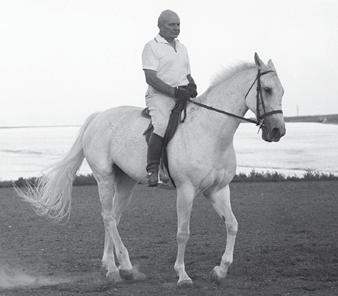
In 1972, US dressage enthusiasts agreed that the time had come to create a national dressage organization. Boomer neatly solved the thorny issue of where to locate said organization by pointing out that Nebraska is the geographical center of the country. He organized the now-famous USDF founding meeting in Lincoln in February 1973; that same year, he established the NDA, which of course was a USDF charter GMO. In 1989 he founded the charitable organization The Dressage Foundation.
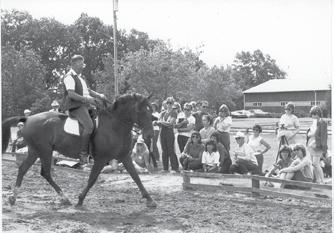
Changing with the times, the NDA has broadened its focus to include Western dressage, offering year-end awards in both disciplines. The GMO also hosts schooling and recognized dressage shows, clinics
The group gathered informally at Endicott’s home in Massachusetts until someone suggested they take the next step. The New England Dressage Association (NEDA) was founded in 1972, with Endicott as president. NEDA became a charter GMO at USDF’s founding meeting the following year, and Bill Woods attended the first USDF conventions as NEDA’s official delegate. NEDA’s first major dressage show was held in conjunction with the famous Ledyard Farm Horse Trials in Wenham, Massachusetts.
NEDA is now USDF’s largest single-chapter GMO. The organization has been at the forefront of dressage in the US, bringing top trainers over from Europe for clinics and seminars. Area luminaries from the late Centered Riding founder Sally Swift to Olympians Carol Lavell and Lendon Gray have been involved with NEDA. The GMO’s highest-profile educational event is the NEDA Symposium, which each fall brings in a world-renowned clinician for a weekend of learning with top-class demonstration horses and riders. There are numerous other educational opportunities, including virtual lessons and
the award-winning webinar series NEDA Know-How.
NEDA’s competition offerings have included the the NEDA Fall Festival of Dressage, which became a CDI held in conjunction with the Great American/USDF Region 8 Championships and the USDF New England Breeders Championship Series Final. A full slate of recognized shows throughout the season plus year-end awards, scholarships, a stallion-service auction, and frequent judge-education and other USDF programs are some of the many additional member benefits.
Learn more: NEDA.org.
Oregon Dressage Society
Where: Primarily Oregon and Washington state
Current membership: 490
Among USDF’s larger GMOs, the Oregon Dressage Society (ODS) was founded in 1971 in the northwest corner of the state. In the 1980s, to facilitate expansion and member growth, the organization created the North Willamette Valley, Twin Rivers, Portland Area, and Cascade chapters. Today ODS is organized into four regions and 13 chapters. A central office helps to run the business of the organization.
The ODS offers a robust slate of activities and awards. It organizes two championship shows, one at the ODS League (unrecognized) level and one USEF/USDF-recognized. There is a full calendar of schooling and recognized shows, clinics, and educational opportunities, including USDF programs and judges’ forums. An extensive awards program recognizes achievements by riders, instructors, support people, and many categories of dressage competition and sport-horse breeding. ODS also offers scholarships for professionals, amateurs, and youth.
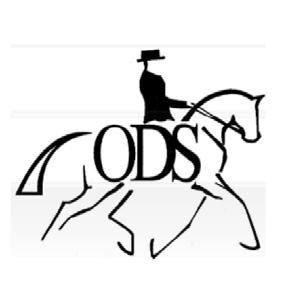
Learn more: OregonDressage.com.

Where: Maryland and surrounding areas
Current membership: 498
The Potomac Horse Center in Gaithersburg, Maryland, was the original home of the Potomac Valley Dressage Association (PVDA), founded in 1964.
The PVDA’s original board of directors roster read like a Who’s Who of dressage at the time, including renowned trainers and judges Linda Zang, Sally O’Connor, the late Gen. Jonathan Burton, and the late Col. Donald Thackeray.
Zang’s Idlewilde Farm in Davidsonville, Maryland, became the de facto US dressage training center of the time, hosting the late Roemer Foundation/USDF Hall of Famer Col. Bengt Ljungquist of Sweden, who coached Team USA to dressage team bronze at the 1976 Olympic Games. In 1982, PVDA hosted the first-ever regional dressage championship in US, named in Ljungquist’s memory (see “GMO: The First Regional Dressage Championships,” November/ December 2022). PVDA would go on to host the inaugural USDF Region 1 Dressage Championships.
Today’s PVDA has 12 chapters and hosts schooling shows, recognized dressage shows, and a Chapter Challenge schooling-show championship. Members enjoy a robust slate of clinics and other educational offerings, awards, and scholarship opportunities. Its best-known event is the annual Ride for Life dressage show, established in 2004, that to date has raised nearly $1 million for the Johns Hopkins Breast Center.
Learn more: PVDA.org.
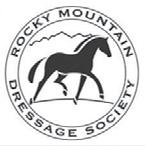
Where: Primarily Colorado, Wyoming, and Utah
Current membership: 662
The Rocky Mountain Dressage Society (RMDS) was formed in 1971 by 26 dressage enthusiasts. From its early days in a part of the country where dressage was practically unknown, the RMDS has grown into a large and vibrant GMO with eight chapters that offer activities and support on the local level. A Colorado-based central office helps to keep the large GMO running smoothly.
Today the Rocky Mountain region is home to a thriving dressage community, reflected in the RMDS’s plentiful member offerings. The GMO hosts its own annual championship show; and the area, which boasts several top facilities, has been the site of several Great American/USDF Region 5 Championships. There are recognized and schooling dressage shows as well as numerous clinics and educational events, including clinics for adult amateurs and a symposium specifically for dressage professionals. General dressage symposia bring in top trainers. RMDS frequently hosts USDF educational programs. There are performance and breed year-end awards, plus a slew of special awards and trophies, including RMDS’s own Horse of the Year roster.
Learn more: RMDS.org.

Where: Greater St. Louis, Missouri, area
Current membership: 92 Dressage instructor Sonya Kershaw and about nine novice dressage riders—mostly Kershaw’s students—started the St. Louis
Area Dressage Society (SLADS) in 1972, holding meetings at Kershaw’s home in Arnold, Missouri. That same year, SLADS held its first dressage clinic, with Michiganbased Violet Hopkins, founder of the USDF seminars for dressage instructors.
In the early years, SLADS ran several schooling shows and fun activities. Today the charter GMO offers schooling shows and an annual recognized dressage show. The nearby National Equestrian Center in Lake St. Louis is a premier equestrian competition and event facility that often hosts the Great American/USDF Region 4 Championships. SLADS member benefits also include year-end awards for volunteers and for achievement at schooling and recognized dressage shows, scholarships, clinics and educational events, and a members-only online discussion forum.
Learn more: SLADS.org.
Virginia Dressage Association
Where: Primarily Virginia Current membership: 596
from the Northern Virginia chapter (VADA/NOVA), and the CDCTA and VADA have jointly sponsored many USEF/USDF programs.
Through the years, VADA members have enjoyed access to top trainers and facilities. Early recognized shows were held at Frying Pan Park in Herndon and at the Foxcroft School in Middleburg. The Virginia Horse Center in Lexington and Morven Park International Equestrian Center in Leesburg have been the site of BLM Championships, USDF Region 1 Championships, and many others. VADA now owns and manages the Dressage at Lexington show.
VADA’s chapters each host clinics, schooling shows, and other events. VADA offers a slate of yearend awards in categories including volunteerism, dressage sport-horse breeding, and for trainers and adult amateurs, as well as for achievement in schooling and recognized dressage shows. The Bred in Virginia award recognizes accomplishments at licensed dressage shows by Virginia-bred dressage horses.
Learn more: VirginiaDressage.org.
Wisconsin Dressage & Combined Training Association

involved in eventing, and the GMO changed its name to the Wisconsin Dressage & Combined Training Association (WDCTA).
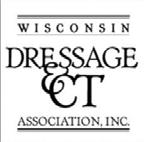
The Virginia Dressage Association (VADA) was founded in 1973 as an outcrop of the Potomac Valley Dressage Association. In 1983, the organization was split into three chapters. Two nonaffiliated dressage clubs, the Southwest Virginia Dressage Association and the Southeast Virginia Dressage Association, later joined VADA, making the GMO a truly statewide organization. Today VADA comprises eight chapters: Central, Charlottesville, Fredericksburg, North East, Northern Virginia, Shenandoah Valley, Southeast, and Southwest. A dressage and eventing association, the Commonwealth Dressage and Combined Training Association (CDCTA), was spun off
Where: Wisconsin and Michigan’s Upper Peninsula Current membership: 126
In the 1960s, Wisconsin resident Lois Aller became an “early adopter” of dressage. Impressed by a dressage demonstration that Aller gave in 1971, a dozen or so spectators decided that the state needed an organization to promote the sport and founded the Wisconsin Dressage Association.
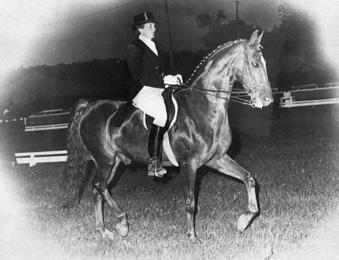
In 1986, the WDA expanded to provide more opportunities for the growing number of members
Today the WDCTA is organized into a state association and four chapters: Central, Kettle Moraine, Southwest, and Upper Peninsula. There are a state board and committees, and each chapter also has a slate of officers. Chapters hold shows, clinics, and other events geared toward those in their geographical areas. WDCTA offers year-end awards in dressage, eventing, Western dressage, and in-hand competition and also recognizes a Member of the Year. One highly anticipated event on the GMO’s calendar is a symposium with US Olympian Laura Graves hosted by the GMO’s Southwest Chapter, to be held this May in Madison, Wisconsin.
Learn more: WDCTA.org.
These charter GMOs helped grow the USDF into what it is today. We salute all of our GMOs and look forward to the future!































n 1972, there was a smattering of local dressage clubs around the country, but otherwise our sport was largely nonexistent in the US. Even the American Horse Shows Association (AHSA, now known as the United States Equestrian Federation, or USEF) paid it little heed.
Dressage supporters didn’t like feeling ignored.
“AHSA has not done enough for dressage to date,” the late dressage judge Col. Donald W. Thackeray, then a member of the AHSA Dressage Committee and director of the United States Equestrian Team, told a group of 26 dressage enthusiasts in Bloomfield Hills, Michigan, that September. “It is the American Horse Shows Association, not just the American Horse Association. It covers a widespread number of interests. Dressage needs a different approach.”
“Perhaps if there was a separate dressage organization,” Thackeray continued, “it could implement the AHSA [Dressage] Committee’s work.”
“We need a central point for obtaining knowledge and help,” concurred the late Violet Hopkins, a Midwest Dressage Association (MDA) representative. But she thought that “local organizations should retain their autonomy.”
“Need a mother club for local organizations?” asked Kay Meredith of the Ohio Valley Combined Training Association. Others agreed than an “umbrella” structure made sense: “We need a federation of existing organizations,” said AHSA Dressage Committee member and Northern Ohio Dressage Association representative Emmy Temple.
The Michigan group decided to send its meeting minutes to dressage supporters in California, with a request that the West Coasters hold an idea-gathering session of their own and report back. The goal: hold an official organizational meeting of the as-yet unnamed dressage “mother club” in February 1973.



Nebraska Dressage Association and Central States Dressage and Combined Training Association representative Lowell Boomer suggested his state as the site of the organizational meeting, “as it is the center of the country.” The organizers placed a notice in The Chronicle of the Horse: In “A Report to You from the Temporary Committee on National Dressage Activities,” they requested that “all who are interested in the advancement of Dressage” convene at the Radisson Cornhusker Hotel in Lincoln, Nebraska, February 17-18, 1973.
“It is hoped that every Dressage organization in the









































country will send representatives who are authorized to act for their groups….It is most important that you have a voice in creating this organization,” the notice read.

Seventy dressage enthusiasts, from New England to California, answered the call. Nineteen of those were “official delegates” of their home dressage clubs.
A temporary executive committee consisting of Melanie Lofholm, Margarita (“Migi”) Serrell, Lillian Zimmerman, Sally O’Connor, and Lowell Boomer was placed “in charge of developing the structure of the new organization, assigning responsibilities, establishing the bylaws, and taking care of incorporation. The Federation’s temporary headquarters is in Lincoln.” (Those “temporary” headquarters, in office space shared with Lowell Boomer’s Boomer’s Printing Company, would remain USDF’s home until 2002.)
Following what became known as the USDF founding meeting, the organizers got to work establishing the new dressage federation’s governance framework.
On March 8, 1973, Boomer, the acting secretarytreasurer, issued USDF’s first press release, announcing the group’s intention to establish a dressage federation: “In essence, the USDF will seal a framework in which individuals can progress with their horses and be rewarded for it; in the process, the general understanding of dressage will be improved.”
The press release continued: “A pro tem Board of Governors consisting of representatives from 19 local and regional groups, and chaired by Mr. Stephen H. Schwartz of California…elected a Committee of Five and charged it with the responsibility of launching the Federation.”
The press release directed clubs with a minimum of 25 dues-paying members to apply for USDF membership by filing their bylaws or procedures. The Board of Governors also intended to create “Individual Memberat-Large” and “Contributing Member” membership categories. Each local club would be assessed an “initiation fee” of $25, to be followed by annual dues of $1 per member. Individual members-at-large (now called USDF participating members) would pay $15 a year.
USDF founding member the late Ivan Bezugloff Jr., editor of Dressage (later Dressage & CT) magazine, reported in the April 1973 issue that “Since the Board of Governors will, with time, become a rather large body, it was decided that an Executive Committee, comprising seven members, shall be elected by the Board from among its members.” [
“Prospects for success of the new organization are bright,” Bezugloff wrote. “It should, however, be remembered that only a very little step has been taken thus far, and only a façade was created. It will take a combined effort on the part of the American dressage community as a whole to put something solid behind this façade, so that it will not fall down with the first gust of wind…. It is important that all of us join this organization, so as to assure a bright
The USDF, created in concept in February 1973, became official that November, when its first business meeting (now the annual convention) was held.


The delegates at the February 1973 USDF founding meeting briefly considered naming the organization
The Dressage Community. That name quickly got scrapped in favor of American Dressage Federation.
Unfortunately, American Dressage Federation was a little too similar to American Dressage Institute, at the time a well-known educational organization in Saratoga Springs, New York. ADI president the late Migi Serrell suggested the name United States Dressage Federation instead, and the ADF became the USDF.
(Potential ADF/ADI confusion was averted, but a new mixup ensued when in 2003 the AHSA changed its name to the United States Equestrian Federation, or USEF. To this day, people get USDF and USEF confused.)
More than 50 people representing 22 dressage clubs attended the USDF’s inaugural business meeting, November 10-11, 1973, in Lincoln, according to Dressage magazine. During the busy two days, they adopted bylaws, established committees, and elected officers.
Dr. Stephen Schwartz, then president of the California Dressage Society, became USDF’s first president. The late Lazelle Knocke was elected vice president; Betsy Coester, secretary; and Bezugloff, treasurer and participating-member representative. Three regional representatives—forerunners to today’s nine regional directors—also were chosen: Sally O’Connor, Eastern; Lillian Zimmerman, Central and Mountain; and Lynn Todd, Western. Boomer became USDF’s first executive secretary (now known as the executive director).
Nine “standing committees” that had been established prior to the November meeting were ratified: Awards and Record-Keeping, Scheduling, Education, Officials, Standards

and Rules, Publicity, Membership, Breeders, and Dressage Exhibitors.
There were 26 “group member” dressage clubs (now known as groupmember organizations, or GMOs) at the time of the meeting. These organizations were given the designation of charter GMO (see “GMO: The Charter Members” on page 36).
Some of the USDF’s best-known awards were already created by the time of the November meeting, with the plan of presenting the inaugural round of honors in 1974:

• Bronze, silver, and gold rider medals, each requiring two scores of 60% or better at the respective levels
• Horse of the Year awards for “Levels I, II, III, IV and International,” each requiring a minimum achievement of a 55% average at three shows and under three different judges
• Trainer awards, based on Horse of the Year award scores, with the trainer of the horse with the highest average percentage being named Trainer of the Year.
The committee also established USDF recognition of AHSA-recognized (now USEF-licensed) dressage shows, available for a $5 fee.
USDF president Stephen Schwartz wanted to improve dressage education in the US, starting with the education of dressage judges. The USDF formed a committee, with Migi Serrell tasked with the training of more advanced judges and retired US Air Force officer and Potomac Valley Dressage Association founding member Col. Clarence “Colonel Ed” Edmonds put in charge of the lower-level judges.
Edmonds is credited as the creator of the USDF L Education
Program. “L” stood for learner judge; participants are no longer called that, but those who successfully complete the program are known as L graduates or graduates with distinction.
Many other USDF volunteers have contributed to the development and enduring success of the L program, which now is the mandatory prerequisite for all prospective licensed dressage judges in the US and has served as the model for judge-training programs in other countries. The program has expanded to include auditor attendance as a means of educating riders, trainers, and others about judging methodology. There are also now continuing-education sessions for L graduates and licensed judges, and today the USDF is also responsible for the education of USEF-licensed dressage judges.
In 1979, dressage education took a leap forward with the creation of the Violet M. Hopkins National Seminars for Dressage Instructors. Hopkins, an instructor/trainer in Michigan, endowed a trust fund to benefit the USDF and advanced the organization funding to begin producing “annual national seminars for dressage

instructors, featuring distinguished instructors and authorities of international reputation,” Dressage & CT reported in October 1978.
Hopkins, then-USDF president Kay Meredith, and then-USDF Region 1 representative (later FEI “O” judge) Linda Zang organized the inaugural Hopkins seminar, which was held at Hopkins’ Tristan Oaks Farm with clinician Col. Aage Sommer, a Danish “O” judge.
The Hopkins seminars eventually grew too large for the Tristan Oaks facility. For two years, the event was held at the University of Nebraska. Recruited by Sommer, the late Maj. Anders Lindgren of Sweden came on board as a clinician, and by 1983 Lindgren was conducting USDF Regional Instructors Seminars. Seminar veterans Maryal Barnett, Bill Woods, Susan Woods, and Mary Flood began leading USDFsanctioned Regional Instructors Workshops in 1986.
Like other European trainers, Lindgren was a product of his country’s system of educating and licensing equestrian professionals. He believed strongly that the US should institute its own system of dressage

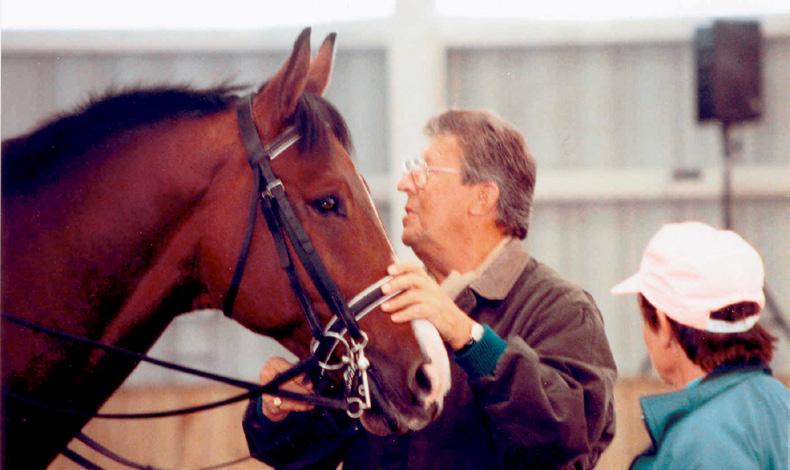

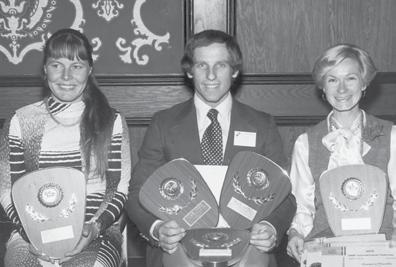
Inaugural USDF convention held
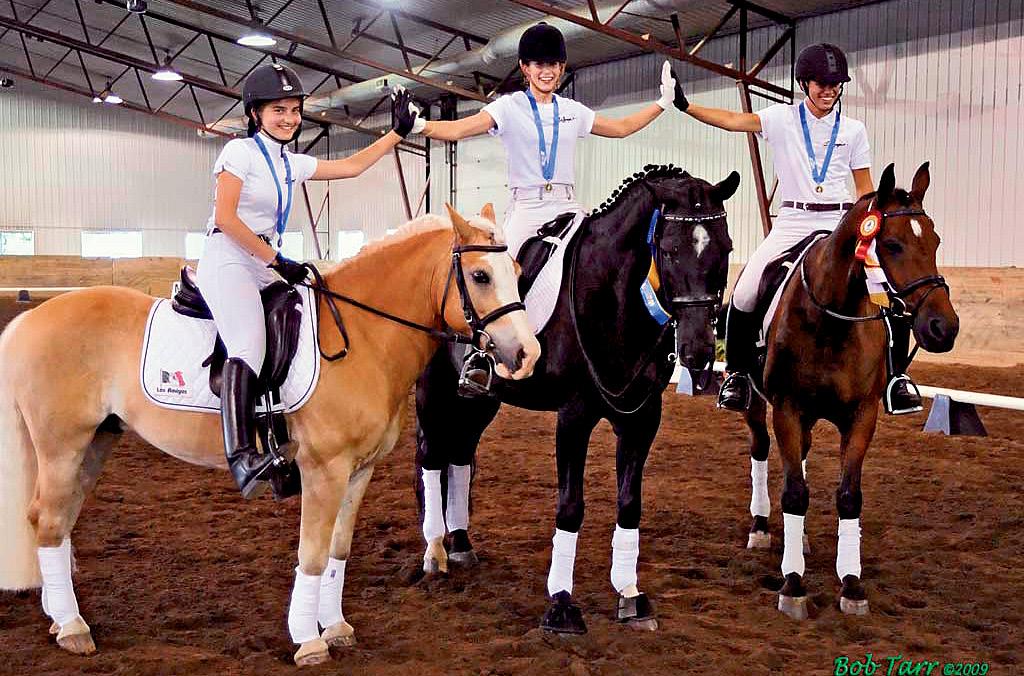
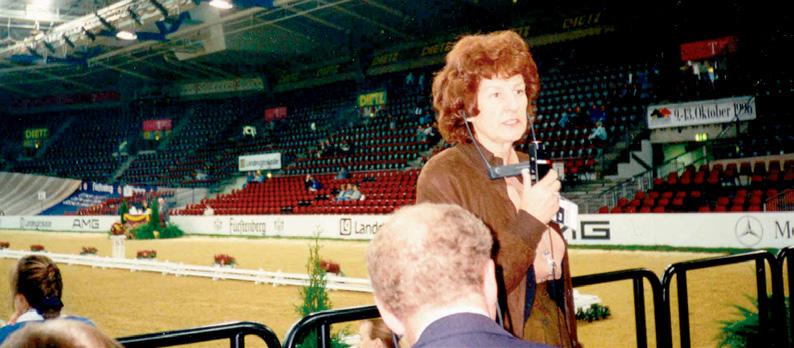
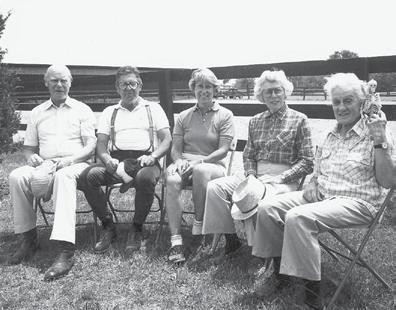
USDF
First
First issue of USDF Connection published Relocation of USDF headquarters from Lincoln, NE, to Lexington, KY

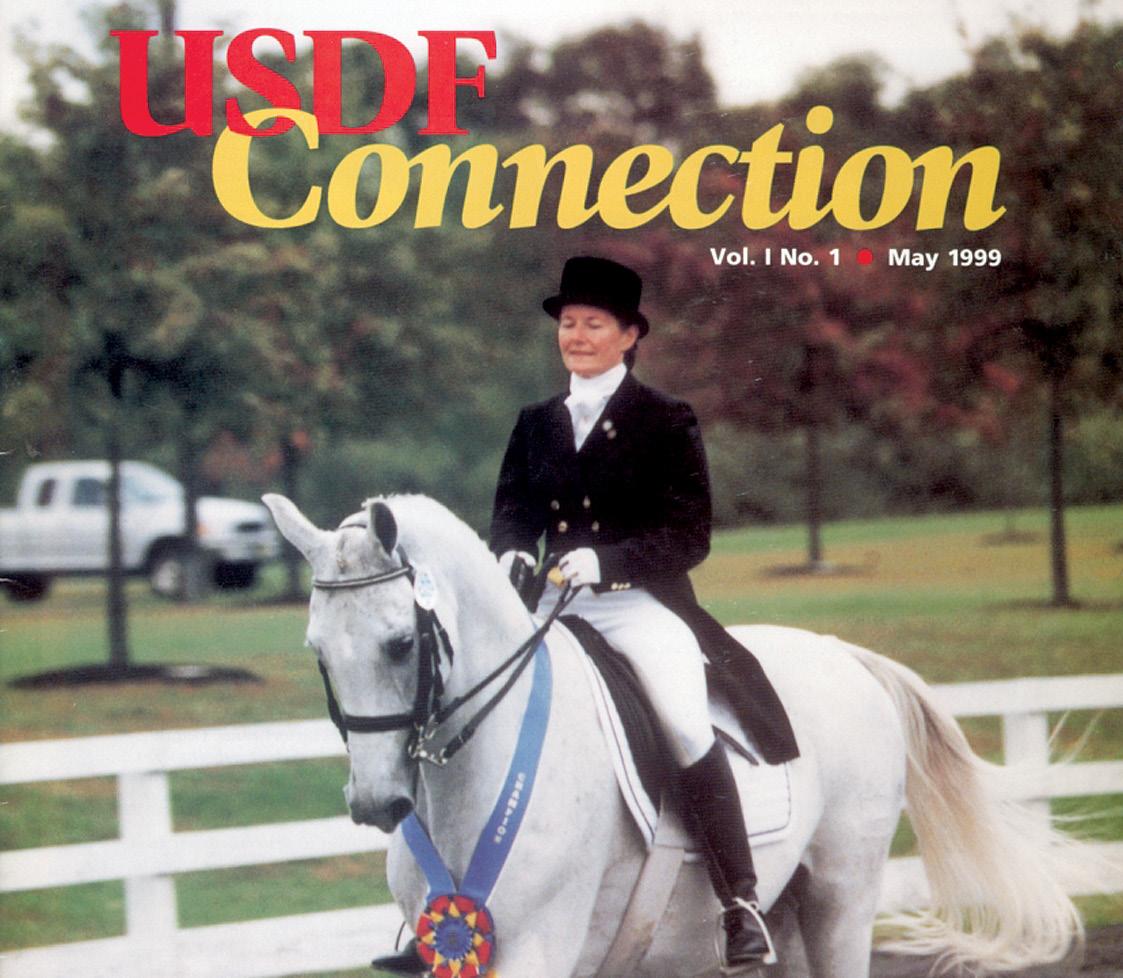
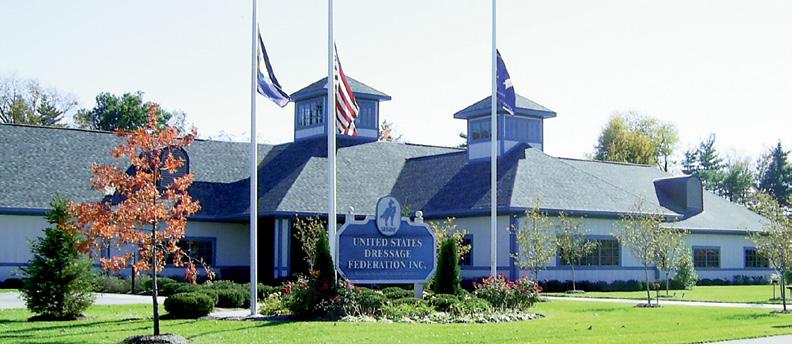
USDF “Year of the Freestyle” celebrated with National Freestyle Symposium

USDF Adult Clinic Series debuts in all nine USDF regions
The 2010 Alltech FEI World Equestrian Games in Lexington, KY, the first equestrian world championships to be held outside of Europe, draw thousands of visitors to the Kentucky Horse Park and the USDF NEC
Inaugural US Dressage Finals, the first national dressage championships for Training Level through Grand Prix since the early 1980s, held at the Kentucky Horse Park
First Sport Horse Prospect Development Forum held USDF introduced and implemented FEI Instructor Certification Program; first exam held National Education Initiative established; first grants awarded
USDF signs extensive Memorandum of Understanding with US Equestrian
Inaugural USDF Adult Amateur Equitation Regional Final classes held USDF assumes responsibility for USEF dressage licensed officials’ training and education
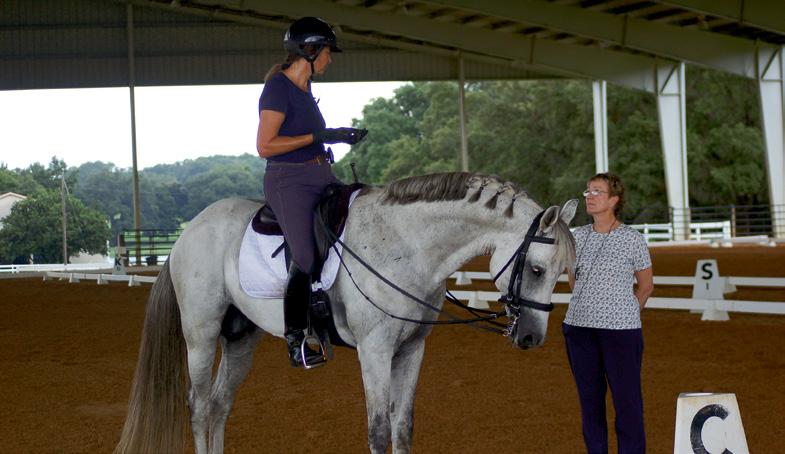
Junior/Young Rider division added to US Dressage Finals
Para-dressage rider awards added to USDF roster

instructor/trainer certification. According to Susan Woods, “After two years of discussion, Bill Woods was contacted by Lowell Boomer and asked to present a certification proposal at the 1987 convention in Seattle. At that time, the concept was to certify instructors who had worked through the Regional Workshops and Seminars, with final examinations to take place at the National Seminar.”
That proposal was defeated, but a reworked initiative passed in 1988. After a year of ironing out details, a pilot “mock testing” session was held in Florida in 1990. The initial slate of certification examiners consisted of Michael Poulin, Lilo Fore, Lendon Gray, Gerhard Politz, Belinda Baudin (now Nairn-Wertman), Robert Dover, the late Edgar Hotz, Carole Grant Oldford, and Betsy Steiner.


Although the USDF’s certification program has been criticized as too expensive and too difficult, it has survived and adapted, and it was cit-
ed as the model when the US Eventing Association instituted its own instructor-certification program. For years, the program offered certification only through Fourth Level. Today instructor/trainers may earn certification at the FEI levels, and the program also offers the designation of associate instructor to those who have completed the workshop series but have not yet earned certification. In addition, the program has to date recognized as honorary instructors 21 dressage professionals who have demonstrated mastery of training, teaching, and riding.
At the same time that certification was gaining momentum, attendance at the USDF/Hopkins Seminars began to dwindle, according to Susan Woods. Yet supporters believed that giving instructors and trainers the opportunity to learn from the world’s best was too important to abandon altogether. USDF volunteers and staffers developed the USDF National Dressage Sym-
posium concept, and the inaugural event was held in Orlando in 1991, with Lindgren and Swedish dressage judge Eric Lette presenting.
Over time the national symposium evolved into more of a mainstream event aimed at the general USDF membership. In 2002, USDF commemorated its “Year of the Freestyle” with the first-ever (and to date never repeated) National Freestyle Symposium, led by British judge Jennie Loriston-Clarke, US Olympian Debbie McDonald, and several noted freestyle designers. In 2003, the symposium changed from a stand-alone event to being held in conjunction with the USDF annual convention. Received enthusiastically at first—and featuring such luminaries over the years as Kyra Kyrklund, Jan Brink, Ingrid Klimke, and the USEF national dressage coaches—the convention/symposium format gradually waned in popularity. The national symposium was discontinued in 2012.
What has survived, however, is the “train the trainers” concept behind the old Hopkins seminars. In 1993, Michael Poulin advanced the concept of an intensive educational event aimed primarily at dressage professionals. His idea paved the way for the USDF FEI-Level Trainers Conference, which debuted in 1994 with Finnish Olympian Kyra Kyrklund as the clinician. Suspended in 2021 and 2022 because of the coronavirus pandemic, the Trainers Conference has enjoyed a successful run in an established “through the levels” format with top demonstration horses and riders, conducted by one or more A-list trainers, judges, or both. The 2023 conference, scheduled for January, will feature David Hunt, Henk van Bergen, Lilo Fore, and Linda Zang.
The USDF over the years developed numerous other educational opportunities targeted at various membership segments. USDF Adult Dressage Camps started in 1989, and in 2003 they were replaced by the USDF Adult Clinic Series, which itself was supplanted in 2017 by the USDF National Education Initiative. Since renamed the GMO Education Initiative, the program consists of four approved formats, and hosting GMOs can apply for grants to help offset the costs.
The year 1990 saw the launch of the USDF Technical Delegate Apprentice Program. TD education continues today and now is part of USDF’s educational responsibilities regarding USEF dressage licensed officials.



Another program aimed primarily at adult amateurs and youth, USDF University, began in 1993. Participants receive “University credits” for attending accredited educational events and can earn certificates and recognition.
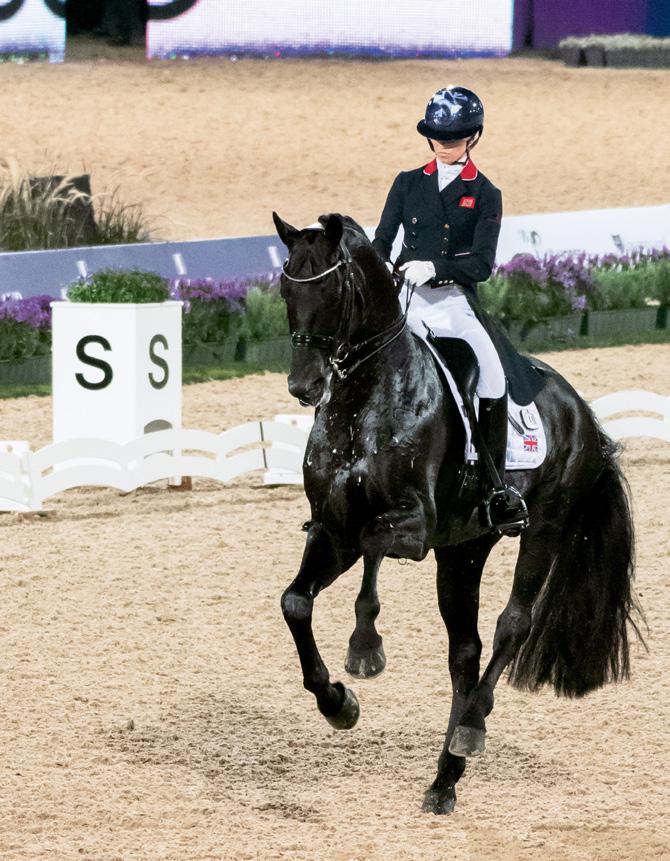
The USDF, which fields the US


dressage teams for the FEI North American Youth Championships, also has a long tradition of providing educational and competitive opportunities to children and young adults. The USDF Advanced Young Rider/ Junior Rider Clinic Series (now the FEI Youth Clinic Series) debuted in 1996. USDF Youth Outreach Clinics, for “grass roots” riders, launched in 2017. Held every other year, the
classroom-format USDF/USEF Young Rider Graduate Program offers sessions to educate and support fledgling dressage pros. Eligible young people may take part in the USEF/ USDF Dressage Seat Medal Program or the Intercollegiate Dressage Association Quiz Challenge. There are also several awards, grant, and scholarship opportunities for youth.
Breeders of dressage sport horses

rightly assert that without their efforts, we would have no dressage sport. In 2005 USDF added awards for sport-horse breeders to its awards roster. USDF Sport Horse Seminars launched in 2008, followed in 2013 by the USDF Sport Horse Prospect Development Program, created as an educational bridge between the inhand and under-saddle competition years. There are now also a sporthorse seminar specifically for youth and a clinic for in-hand sport-horse handlers.
The magazine you’re reading made its debut in 1999. Feeling that it had outgrown its USDF Bulletin newsletter, beginning in 1994 the USDF partnered with two consumer-magazine publishers in succession that for a time produced USDF’s official publications, Dressage Today and Dressage & CT, respectively. After corporate mergers led to the shuttering of D&CT in 1998, the USDF decided to take charge of its own member magazine and launched USDF Connection.
As the world increasingly went online for information and entertainment, the USDF followed suit. In 2010 it added a multimedia educational database called eTRAK to the USDF website. Now called the USDF Education Library, the members-only

resource contains a wide array of multimedia educational materials. There are also online courses from USDF and accredited outside providers, USDF GMO education lectures, and more. And to bolster its educational and promotional outreach beyond its existing membership, in 2019 USDF launched YourDressage.org, a website containing interactive features, usersupplied content, and select educational material.
The first US dressage championships, held from 1981 through 1984 in Oklahoma City, were the Insilco United States Dressage Championships. The top 10 USDF Horses of the Year at each level received invitations, as did the winners of AHSA and US Equestrian Team (USET) Regional Finals, according to an announcement in the March 1981 issue of Dressage & CT.
In 1983, the event was also designated as the AHSA and the USET championships; but by 1984 the competition had become the target of controversy, and USET withdrew its association. With USET’s departure, sponsor Insilco backed out as well, spelling the end of the championships. It would be nearly three decades before another USDF
national championships would emerge to take their place.
Evidently realizing that a new, enduring national championships would have to be constructed from the ground up, the USDF began the process in 1994 with the establishment of the AHSA/USDF Regional Dressage Championships. ThenUSDF president Ellin Dixon Miller was instrumental in getting the series recognized by the AHSA, which elevated the competitions’ profile.
The Regional Championships program proved successful and continues to this day. Held in each of USDF’s nine regions, there are divisions for open, adult amateur, and junior/young rider competitors in levels from Training through Grand Prix, plus freestyle. The Regional Championships roster has since expanded to include each region’s USDF Dressage Seat Medal semifinal, as well as its USDF Adult Amateur Equitation Regional Final.
To build a war chest for a USDF national championships, a portion of the fee paid by competitors to enter Regional Championship qualifying classes went into an escrow account. The account grew over the years, but still the concept faced obstacles: When and where would a national championships be held? How could it

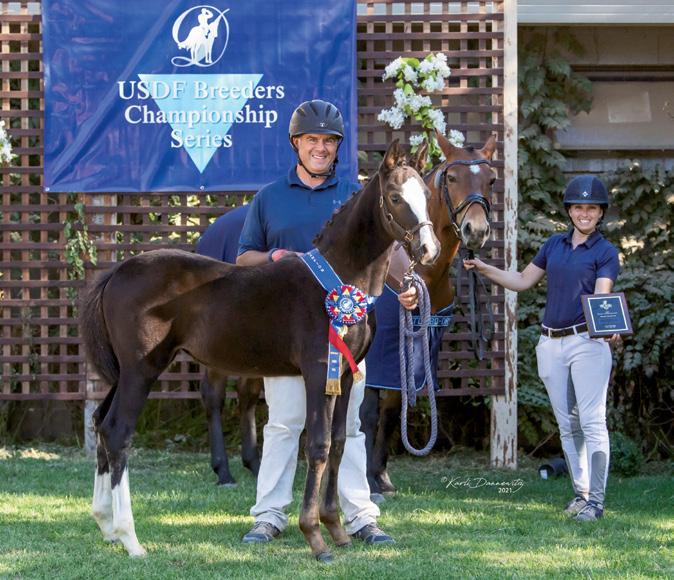
REGIONAL CHAMPION: USDF’s Regional Championships program has grown in popularity. Pictured are 2021 Great American/ USDF Region 9 Second Level Adult Amateur champions Bonnie Canter and Vitali.

SPORT-HORSE
RECOGNITION: Handler Kevin Reinig with Alanna Sellers’ Dutch Warmblood filly Rosa Cum Laude RTH (by Cum Laude), who won the 2021 USDFBC Western Series Current Year Foal championship
Since 1996, USDF has recognized extraordinary contributions to American dressage and to the USDF on a national or regional/local scale with induction into the Roemer Foundation/USDF Hall of Fame, the USDF Lifetime Achievement Award, and the USDF Member of Distinction award. Learn more at usdf.org/halloffame.
CONTRIBUTIONS: For his role in creating the USDF L program, Col. Clarence Edmonds (center) received the USDF Lifetime Achievement award in 2005 from then-USDF president Sam Barish and thenUSDF Historical Committee chair Anne Moss
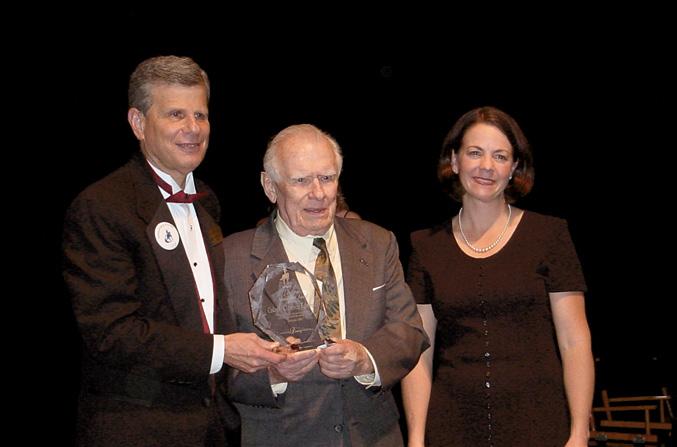
1996 Lowell Boomer 1997 Chuck Grant Gifted Keen 1998 Violet Hopkins Col. Bengt Ljungquist Col. Donald W. Thackeray 2000 Capt. John Fritz Lt. Col. Hans Moeller Graf George 2001 Maj. Gen. Guy V. Henry Jr. Jessica Newberry Ransehousen 2002 Ivan I. Bezugloff Jr. Kyra Downton Col. Hiram Tuttle 2003 Maj. Anders Lindgren Karl Mikolka Margarita “Migi” Serrell 2004
Capt. Andrew Bela de Szinay Dr. Max Gahwyler
2005 Seldom Seen 2006 Maj. Robert Borg Sarah “Sally” Swift Roemer 2007 Maj. Gen. Jonathan Burton Hilda Gurney Edgar Hotz 2008 Fiona Baan Robert Dover 2009 Linda Zang Brentina 2011 Lendon Gray 2012 Michael Poulin Ravel 2013 Charles de Kunffy Anne Gribbons 2016 Lilian Wittmack Roye Rocher 2017 Liselotte “Lilo” Fore 2019 Jane Savoie Axel Steiner 2020 Dr. Hilary Clayton Gary Rockwell Verdades 2022 Janine Malone USDF Lifetime Achievement Award 2002 Lazelle Knocke Elizabeth “Liz” Searle
2003 Peter Lert Marianne Ludwig 2004 Kay Meredith 2005 Col. Clarence Edmonds 2007 Ellin Dixon Miller 2010 John “Jack” Kimball Judith Noone 2013 Marilyn Heath 2014 Maryal Barnett Janine Malone 2015 Lloyd Landkamer 2016 Samuel Barish 2019 Fern Feldman 2021 Terry Ciotti Gallo Lois Yukins 2022 Lisa Gorretta USDF Member of Distinction 2016 Janne Rumbough 2017 Winnie Heiney-Duncan Lois Heyerdahl 2018
Priscilla Endicott Sue Hughes Martha McDaniel Mary Anne McPhail 2022 Bonna McCuiston
be made both prestigious and within financial reach such that competitors would come from all over the country, thus making the competition truly national in scope?
Meanwhile, a different type of competition program got under way. In 1998, the USDF launched the USDF Breeders Championship Series (USDFBC) of regional competitions and finals for sport-horse breeders. The brainchild of Hanoverian breeder and then USDF secretary Janine Malone, the USDFBC series grew out of a two-competition regional breeders championships in the Northeast. There were originally 11 USDFBC series regions, so designed to lessen the distances that young horses have to travel, but in 2022 there were the standard nine. Champions and reserve champions in various in-hand and under-saddle divisions qualify to compete in their respective series finals for overall regional titles.

The long-awaited USDF national championships finally became a reality with the 2013 debut of the US Dressage Finals. That year, and every year since, it has been held in November, following the conclusion of the nine
Regional Championships, at the Kentucky Horse Park in Lexington.
An immediate success, the Finals have grown each year, particularly as a showcase for dressage freestyles and as a major competitive goal for many adult amateurs. To help ease the financial burden on those traveling the longest distances, the USDF offers travel grants to competitors in designated Western states plus Alaska and Hawaii.
For the first seven years (the 2020 Finals were canceled on account of the COVID-19 pandemic), the US Dressage Finals were open only to open and adult-amateur competitors. Youth riders clamored to be included, as well, and in 2021 junior/young rider divisions for Training through Fourth Levels were welcome additions to the Finals roster.
USDF initially gave three types of awards: rider medals, Horse of the Year awards, and Trainer of the Year awards. Trainer of the Year is no more, but the awards program itself has exploded in size in USDF’s 50 years. The bronze, silver, and gold rider

medals, introduced in 1974, are some of USDF’s most enduring and coveted. Gold, silver, and bronze freestyle bars were added in 2002. Recognition for competitors earning all six rider medals and freestyle bars, called Diamond Achievement Recognition, was awarded for the first time for the 2021 competition year.
HORSE OF THE YEAR: These year-end awards have always been among USDF’s most prestigious. Rider Robert Dover (right) accepts the Col. Thackeray Trophy for the 2004 USDF Grand Prix Dressage Horse of the Year from then-USDF vice president George Williams on behalf of Dover’s 2004 Athens Olympics mount, FBW Kennedy.


Arguably the most prestigious USDF awards are the USDF Horse of the Year titles, bestowed annually on the top-ranked horses from Training Level through Grand Prix and on the top-scoring horses in the Dressage Sport Horse Breeding and Materiale divisions. Achievement in sport-horse breeding is also recognized through the USDF Dressage Breeder of the Year and Dressage Sport Horse Breeding Breeder of the Year rankings and year-end awards.
Since 1982, breed associations and registries have offered awards for achievement at various dressage levels and divisions, including sport-
The USDF is grateful to the officers, regional representatives, regional directors, and at-large directors whose efforts and dedication have helped make the organization what it is today.
Stephen Schwartz 1974-1976
Kay Meredith 1977-1982
Lowell Boomer 1983-1988
Lazelle Knocke 1989-1993 Ellin Dixon Miller 1994-1999 Sam Barish 2000-2009 George Williams 2010-2018 Lisa Gorretta 2019-2021 George Williams 2022-
Lazelle Knocke 1974
Kay Meredith 1975-1976
Stephen Schwartz 1977-1978 Peter Lert 1981-1982
Lazelle Knocke 1983-1988 Elizabeth Searle 1989-1996 Sam Barish 1997-1999 George Williams 2000-2009 Melissa Creswick 2010 (interim)
Beth Jenkins 2011-2013
Lisa Gorretta 2014-2018 Kevin Reinig 2019-
Betsy Coester 1974
Mary Jean Rogers 1975-1977
Jayne Ayers 1978-1982 Elaine Kendig 1983-1986 Ellin Dixon (Miller) 1987-1990
Carolyn VandenBerg 1991-1996
Joan Humphrey 1997-2002 Janine Malone 2003-2013 Margaret Freeman 2014-2022
Treasurer
Ivan I. Bezugloff Jr. 1974-1976
Jayne Ayers 1977
Ruth Arvanette 1978-1992 (assistant treasurer in 1977)
Fred Earnshaw 1993-1995
Tom Townsend 1996-1999
Barbara Tuohino Funk 2000-2009
Steven Schubert 2010-2018
Lorraine Musselman 2019-
Western Representative (Western Region director as of 1976)
Mary Dodd 1974-1977
Midwest Representative (Central Region director as of 1976)
Lillian Zimmerman 1974-1975 Natalie Lamping 1976-1977
Eastern Representative (Eastern Region director as of 1976)
Sally O’Connor 1974-1975 Lazelle Knocke 1976-1977
Region 1 Representative (Region 1 director as of 1988)
Linda Zang 1978-1979
Jerry Weikert 1980-1981
Sandy Rokosz 1982-1987 Sam Barish 1988-1995
Janine Malone 1996-2001 Alison Head 2002-2010 Lisa Schmidt 2011-2016 Bettina Longaker 2017-
Region 2 Representative (Region 2 director as of 1988)
Natalie Lamping 1978-1981
Joanna Thomas 1982
Charles Barnett 1983-1987
Verta Cole 1988-1994
Lisa Gorretta 1995-2000 Sue Hughes 2001-2009
Ken Levy 2010-2018 Debby Savage 2019-
Region 3 Representative (Region 3 director as of 1988)
Dennis Farnham 1978 John Kimball 1978-1987
Sherry Frank 1988-1989
Charlotte Trentelman 1990-1995
Pam Schwartz 1996-1998 Susan Bender 1999-2001 Sandi Bishop 2002-2010
Kimberly Taylor 2011-2013 Susan Bender 2013-2022
Region 4 Representative (Region 4 director as of 1988)
Marianne Ludwig 1978-1979 Gail Wood 1980-1981 Marlene Schneider 1982-1983
Lois Arnold 1984-1987 Mary Vlazny 1988-1989 Miki Christophersen 1990-1994
Jeanne Ahrenholz 1995-2000
Linda Landers 2001-2006 Sarah Patrick 2007-2009 Lloyd Landkamer 2010-2015 Linda Landers 2015 (interim appointment following Landkamer’s death) Anne Sushko 2016-
Region 5 Representative (Region 5 director as of 1988)
Frank Hebard 1978-1983 Marcie Stimmel 1984-1985
Sue Malone-Casey (Regional Assistant) 1984-1985 Lela Street 1986-1987
Veronica Holt 1988-1992 Jane Hendricks 1993-1995 Janet Brown (now Foy) 1996-2001 Theresa Hunt 2002-2010 Heather Petersen 2011-
Region 6 Representative (Region 6 director as of 1988)
Lee Ann Gibbs 1978-1979 Naida Whittaker 1980-1981 Debbie Moore 1982 Naida Whittaker 1983
Suzy Moery 1984-1989
Joyce Steinbock 1990-1994 Gail van Demoere 1995-2000 Gaye McCabe 2001-2006 Donna Longacre 2007-2015 Carolynn Bunch 2016-2018
Peter Rothschild 2019-2021 Noah Rattner 2022-
Region 7 Representative (Region 7 director as of 1988)
Sue Jones 1978-1979 J. Victor Beckett 1980-1983 Peter Lert 1984-1995
Jan Enneking Welch 1996-1997
Pat Hart 1998-2001 Melissa Creswick 2002-2004 Terry Wilson 2005-2016 Carol Tice 2017-
Region 8 Director (Region 8 formed in 1988)
Vivien Bobo 1988-1994
Lendon Gray 1995-1997 Fern Feldman 1998-2012 Debra Reinhardt 2013-2021
Helen van der Voort 2022-
Region 9 Director (Region 9 formed in 1990)
Rebecca Snell 1990-1995
Sarah Jane Martin 1996-2000
Leigh Olejer 2001 Kathryn Kyle 2002-2007 Bess Reineman Bruton 2008-2013
Sherry Guess 2014-2021 (stepped down midyear) Bess Bruton 2021-
Activities Council At-Large Director
Lisa Gorretta 2012-2014 Susan Mandas 2014-
Administrative Council AtLarge Director Kevin Bradbury 2012-2020 Barbara Cadwell 2021-
Technical Council At-Large Director
Carolyn VandenBerg 2012-2017
Sue McKeown 2018-
horse breeding (the registries themselves decide which awards they wish to offer), through the USDF All-Breeds Awards program.
By the 1990s, the USDF had outgrown its office space in downtown Lincoln, Nebraska. Prompted in part by the AHSA’s decision to relocate from New York City to Lexington, Kentucky, USDF began considering a move to the “Horse Capital of the World.”

In May 2002, with newly hired executive director Stephan Hienzsch
at the helm, the USDF headed to Lexington. Only a few Lincoln-based staffers chose to make the move, so one of Hienzsch’s first duties was to recruit and hire nearly an entire office staff.
While the staff settled into rented office space in a Lexington shopping mall, the USDF began to dream of a home of its own. The Kentucky Horse Park was offering a sweet deal: for a nominal fee, a lease on a prime plot of land next door to the stately new headquarters building of US Equestrian, the largest of the equine organizations that had taken up residence in the part of the Horse Park known as the National Horse Center. A capital
campaign soon kicked off to raise the construction funds, and in 2006 thenUSDF president Sam Barish cut the ribbon and officially opened the USDF National Education Center (NEC).
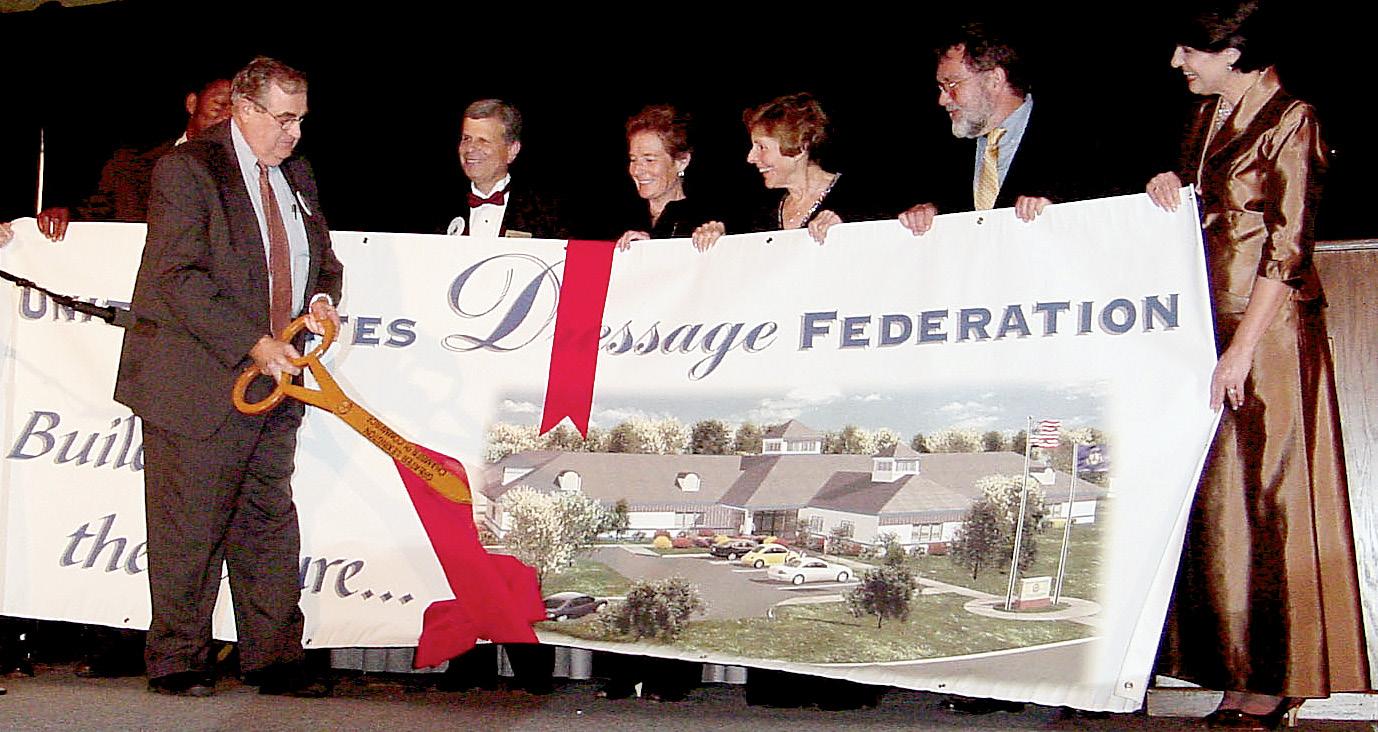
The NEC is a combination office and destination. Horse Park visitors are welcome to tour the Roemer Foundation/USDF Hall of Fame, shop in the Lendon F. Gray Bookstore, and admire the perpetual trophies and works of equine art on display.
Visitors to the USDF NEC might be surprised, given the USDF’s array of programs and responsibilities, to learn that the organization operates with a modest staff and a relatively tight budget. It can do so in part because much of the USDF’s important work is done by volunteers. From the president to committee members and Board of Governors delegates, these dedicated dressage supporters are all volunteers.
That volunteer structure is one of the USDF’s secrets to success. It is a key reason that the organization has thrived over the years, surviving periodic economic downturns and staying afloat during a pandemic that caused many other businesses to close their doors. The USDF is its volunteers, and volunteers are the USDF. By being a member, you are part of the organization. Come be a part of the proud tradition established by some of our sport’s greatest visionaries. Help shape the next 50 years of the USDF and American dressage.

Monies collected through the Circle of Friends have made it possible for USDF to offer over 30 educational programs and 2000 annual awards, while furthering the organization’s mission of education, recognition of achievement, and promotion of dressage. By donating to the Circle of Friends, you are not only supporting these endeavors, but also your ‘friends’ throughout the dressage community.
Visit USDF’s secure online giving site at www.usdf.org/donate. Questions? Please email us at donate@usdf.org or call 859-971-2277.

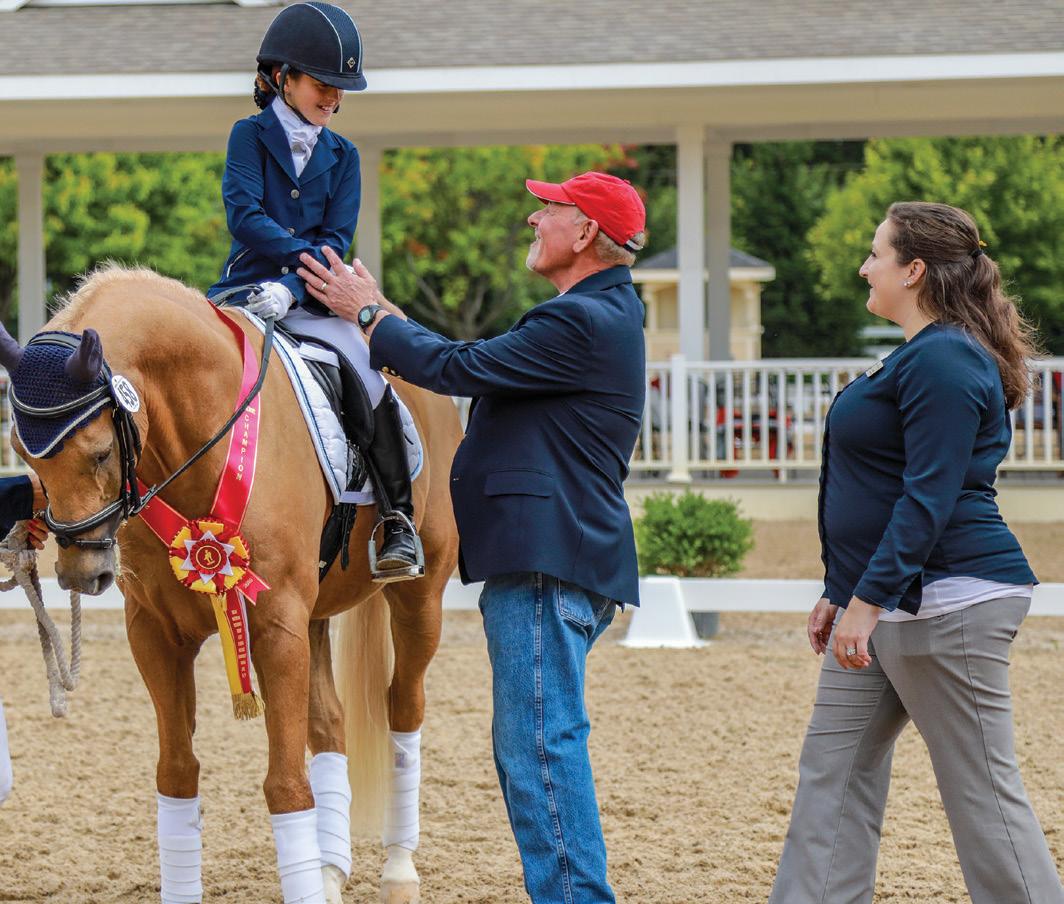
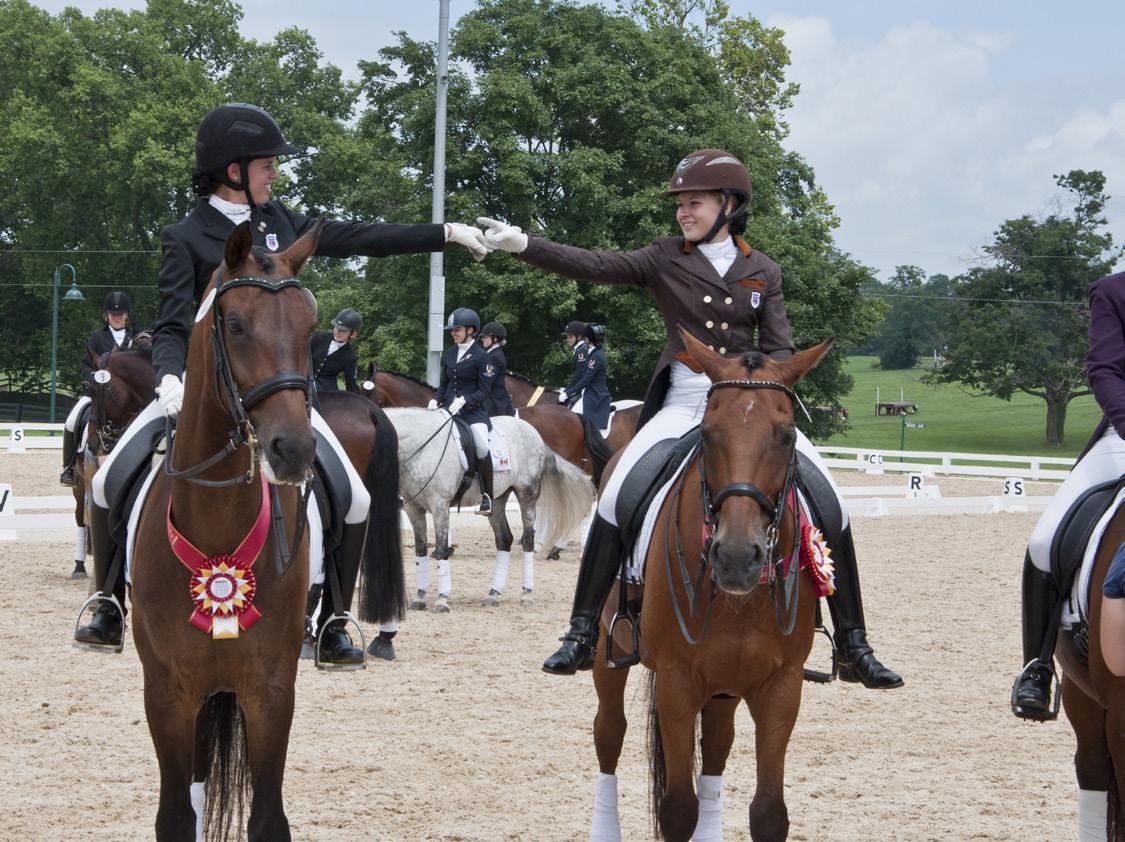
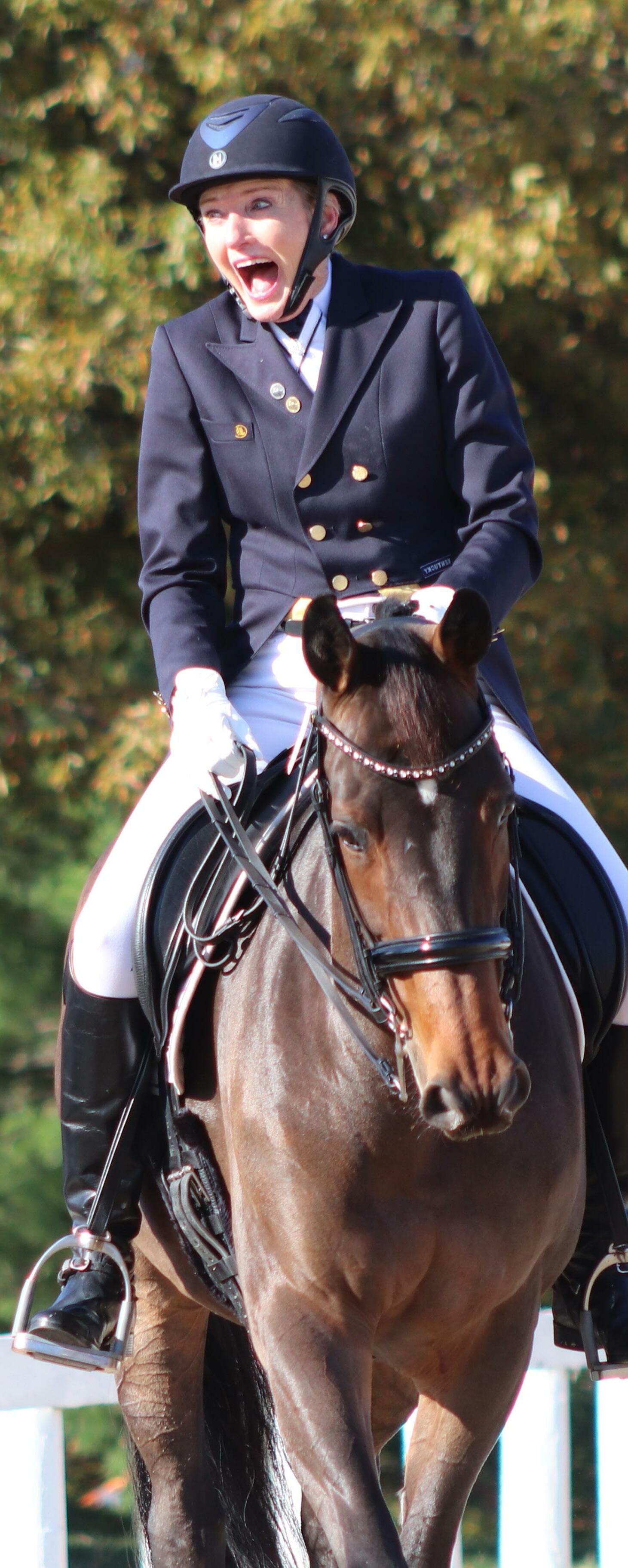
Is an Iberian horse right for you? Experts offer advice on buying, training, and showing.
 BY SUE WEAKLEY
BY SUE WEAKLEY
The first time dressage trainer and competitor Tyra Vernon rode an Iberian horse, “I had a blast,” she says. “I thought, oh, these little Ferraris are way easier to ride than a warmblood [and some other breeds]!”
Today, Vernon says, Iberians are the mainstay for her amateur-heavy clientele, comprising 95% of the horses at her BREC Dressage in Ocala, Florida.
”I feel like the Iberian horses have played such a big part in dressage here in the United States, providing our amateur riders with trustworthy horses with which they can more easily reach the upper levels,” Vernon says. “At the end of the day, they’re having fun, and they love it! And at the same time, you can ride one at a professional level.” (Vernon herself does just that, currently competing her 2011 Lusitano gelding, Hadrian Interagro [Baldor Interagro – Latina, Cantor], at the CDI Grand Prix level.)
Are you wondering whether a “little Ferrari” might be right for you? In this article, we’ll take a look at the breeds’ history; then we’ll share expert advice on buying, training, and showing an Iberian horse.
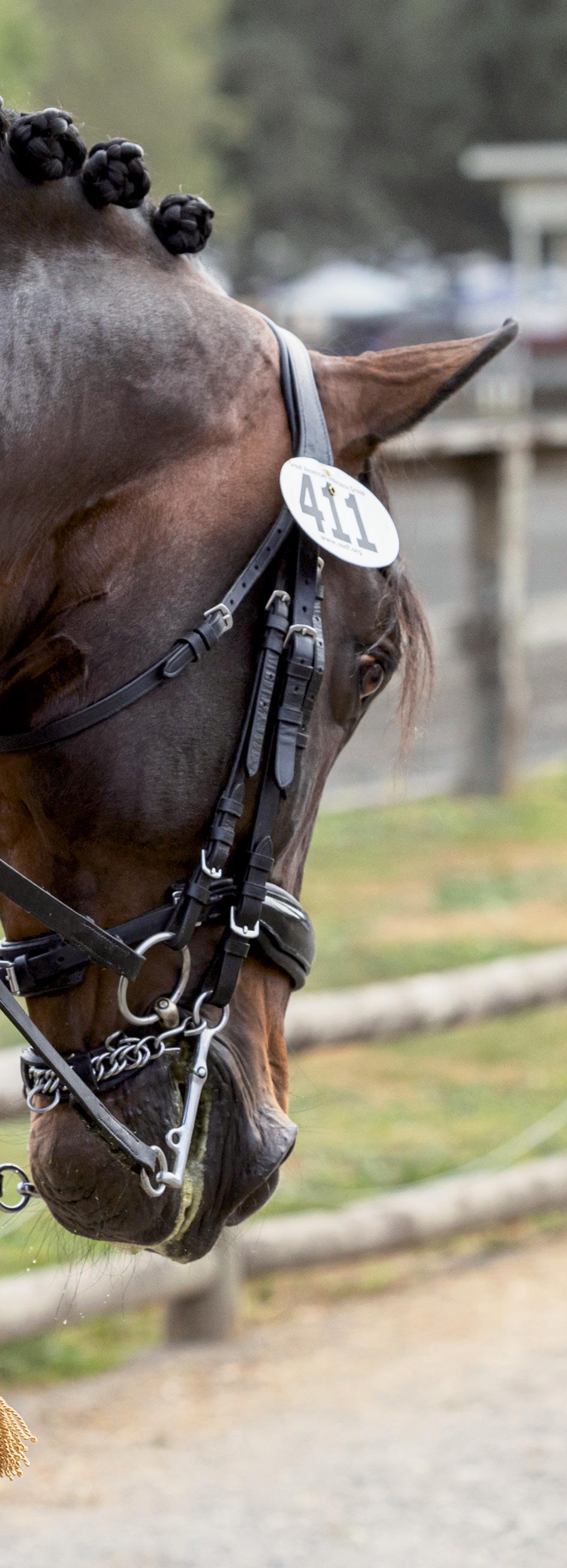
Iberian horses have been prized for their handiness and bravery in war since 4000 BC. The Greeks and Romans used them as cavalry mounts, and Xenophon praised the “gifted Iberian horses” during the Peloponnesian Wars in 400 BC. Having excelled in haute école dressage since the Renaissance, they are becoming increasingly popular for dressage in modern times.
Seventeen breeds are native to Europe’s Iberian Peninsula—the countries of Spain, Portugal, Andorra, a small portion of France, and the British territory of Gibraltar—and are thus known as Iberian horses. Two of the best known are the Pura Raza Española of Spain (commonly referred to as the PRE) and the Puro Sangue Lusitano of Portugal (the Lusitano).
PREs and Lusitanos are carefully controlled by their respective registries, including guidelines for breed standards and bloodline purity.
Kimberly Van Kampen, owner of Hampton Green Farm in Michigan and Florida, is a premier US breeder of PREs. Her criteria for buying an Iberian horse are almost identical to those for any horse intended for dressage. [
Start researching Iberian horses and you’re bound to come across references to Andalusians. According to Hampton Green Farm owner and PRE breeder Kimberly Van Kampen, Andalusian is a blanket term (like “warmblood”) that refers to any Baroque horse, whether papered or not, with genetic roots in the Iberian or Andalusian regions.
“It’s never incorrect to use the term Andalusian,” Van Kampen says. “It’s just less accurate than saying [the specific breed name, such as] PRE or Lusitano.”
There are a host of Andalusian crosses, including the Warlander (Friesian/Andalusian), the Iberian Warmblood (Andalusian/warmblood), the Azteca (Quarter Horse/Andalusian), the Hispano-Arabe (Andalusian/ Arabian), and the Spanish-Norman (Percheron/Andalusian).
When Van Kampen evaluates a prospect, she asks herself: “Is this a dressage competitor? Does it have three basic gaits, and are they good-enough quality to be scored well? What kind of temperament can I handle? If I’m a low-level rider and I’m a little fearful, I’m going to want a horse that’s a little slower to react than the FEI rider who needs a quick-moving, hotter horse. Next, do you want a mare, stallion or gelding?”
Van Kampen notes that, although Spaniards generally don’t ride PRE mares, she has found that they make extraordinary riding horses. Still, she recommends geldings for their ease in showing and transporting to and from Europe because of quarantine restrictions on mares and stallions.
“Another really important thing for our breed,” she says, “is size. So many dressage riders think they’ve
got to have a 17-hand horse, and in my experience, for our breed the bigger PREs are out of type. They’re a little slower, and they’re generally not as sound as the breed standard of around 16 hands.”
In addition to their smaller size, many Iberian horses have a distinct appearance that distinguishes them from other sport horses. A Roman profile is common, and Van Kampen says that their heads and often-substantial necks are usually set more upright than those of draft breeds or Thoroughbred-type horses. As a result, “They look bigger if they’re ridden correctly. I think most men that I’ve seen in Spain ride 16-hand horses, and they don’t look too big on them because of the horses’ big necks and their presence and how they move.”
Hampton Green Farm’s PRE stallion Grandioso III (Adelante –Grandiosa, Sevillano IX), ridden in the 2012 London Olympics and the 2016 Rio Olympics by Jose Daniel Martin Dockx of Spain, is a good example. “We told everybody he was 16 hands, but he really sticks out at 15.3,” Van Kampen says.

Although Iberians are known for their good temperaments, they can be a bit “spicy” to ride, says longtime enthusiast Heather Bender, an FEIlevel trainer and competitor in Palm City, Florida.
“There’s a little bit of a mistake that people think, because they’re Iberian, they’re going to be the perfect adult-amateur horse,” Bender says. “That’s where the bloodlines and the breeding come into play. Lusitanos tend to be on the hotter side.
The Spanish horses have spent more time in their breeding programs breeding a variety of types, and just because you say ‘Spanish,’ you cannot classify them into one box.”
We asked experts to share their advice for those who are interested in buying an Iberian horse, in the US or abroad.
Buy from a reputable dealer, and work with a trainer you trust who knows Iberian horses. Some Iberians don’t actually have formal dressage training, says FEI-level rider/ trainer and USEF “S” judge Alison Head, of Aiken, South Carolina. “I know somebody who recently bought a Lusitano, I believe from Italy,” Head says. “He jumped through fire and he had Spanish walk, but he can’t walk, canter, or bend in a normal way. He doesn’t understand basic aids.” There are reputable people in Europe who put correct basics on their horses, she says, but you have to know how to find them.
Search out breeders that specialize in dressage horses. “Remember that these breeds [PREs and Lusitanos] have closed stud books, and there is no crossing with other breeds,” says Van Kampen. She adds that some breeders focus on characteristics other than dressage attributes—such as breeding for “good hair”—so doing your homework on the front end can save time.
Keep in mind that Iberians are common breeds in Spain and Portugal and may have been trained by people ranging from Olympians to “back yard” riders, perhaps using questionable methods.
“A lot of horses that go for sale as dressage horses were trained by people who have never been in the show ring and have never been patient,” Van Kampen cautions.
”They’re making horses very quickly. Look for a horse that wasn’t trained with fear and roughness as much as you possibly can. Iberians just have a superior mind, and those horses trained with nervousness and force are difficult to bring back to the relaxed kind of work that’s so important in our sport. You have to be very careful when you’re dealing with people who train these horses in their back yard.”
Don’t take the vetting for granted. Van Kampen once bought a horse that had been doped for her test ride and for the prepurchase exam. When she got him home, she discovered that “he was a monster, and over time he became crazier and crazier.”
Bender is currently competing two Lusitanos at the Grand Prix level: Alvarinho Interagro, a 2004 stallion (Tufão Interagro – Upiki Interagro) owned by Debra Eddington; and

Diacono Interagro, a 2007 gelding (Quinio Interagro – Meiga) owned by Priscilla Baldwin. The veteran trainer—she has more than 200 Grand Prix tests under her belt and has been in the saddle for 55 years— asserts that, if she trained her Iberians the way she rides warmbloods, they wouldn’t have made it to Grand Prix.
“Yet they’re winning,” Bender says. “It is very clear what those requirements are, and how we get that done on the Iberian horse sometimes needs to be different. They can be improved in their balance and rhythm. Some of those horses, you can actually look at them in the beginning and think, ‘Oh, this isn’t going to work,’ and then when you change their balance and you get them in the right place for their proportions, you can make their rhythm correct. And if you can do that, then we can talk about taking them into the dressage [show] ring.”
Vernon agrees that an Iberian’s
The question of whether the Lipizzan—the breed made famous by the Spanish Riding School of Vienna—is an Iberian horse is a difficult one and depends on one’s perspective.
Lipizzans, like many other breeds, are descendants of horses from the Iberian peninsula, and are distant cousins to Andalusians and Lusitanos. All are categorized as Baroque horses. The Lipizzan breed has been referred to as a “living museum,” as the breed standards have not changed for over 200 years.
During my years riding and training Lipizzans at Tempel Farms in Illinois, and even before that time, I always heard them referred to as an Iberian breed. After all, in 1581, horses imported to Austria from Spain were part of
training program should take into account its unique conformation, strengths, and challenges.
“My experience with the majority of the Lusitanos is it’s actually a little bit hard to get them long and low and really using their back,” she says. “They’re a little tricky in the connection, and it’s not as easy as it might seem. These guys are a little bit more active but hollow, and you’ve got to figure out how to put the front end and the back end together and lift the back up. In normal conformation, they can collect fairly easily because that’s what they are bred for; they can [learn to] sit and pirouette and half-pass in half the time an 18-hand warmblood does.”
CLASSICAL: Unquestionably a Baroque breed, the Lipizzan has Iberian influences, among others. Current USDF president and high-performance dressage rider/trainer George Williams (pictured aboard Neapolitano VI Serafina in an undated photo) rode and trained the stallions at Tempel Farms in Illinois for 20 years.

the original breeding stock used to produce horses for the Spanish Riding School, hence the name of the institution. But if you Google the question of whether Lipizzans are considered an Iberian breed, you do not come up with a clear answer. I tried to research the issue the old-fashioned way—by looking through my numerous horse books.
Jane Kidd’s 1976 book, The Complete Horse Encyclopedia, states that Arabians were imported to Austria in the nineteenth century “to improve the famous Lipizzaners used at the Spanish School of Riding. As these High School horses originated in Spain, they already had Arab ancestors. The horses of the Iberian peninsula had Oriental ancestors brought in by conquerors from North Africa and the Middle East. Spain’s and Portugal’s most famous breed, the Andalusian, has distinctive Arab characteristics; so, too, has Italy’s Neapolitan, which originated from Andalusians and Arabs and which became the most sought-after horse for High School in the post/Reformation era.”
The Spanish Riding School itself produced an article, published in a 2005 issue of The Chronicle of the Horse, entitled “The History of the Lipizzaner Breed.” The article refers to the breed’s Iberian heritage but stops short of calling the Lipizzan an Iberian breed.
According to Head, Spanish and Portuguese horses often have powerful necks and large chests, with the ability for much expression and reach through the shoulders. This can give the appearance that the hindquarters lack activity or strength—and in fact, strength in the entire top line can be slow to develop. It can be tempting to send the horse more forward, down, and round “over the back” in the hopes of developing more push and activity behind. But that can be the wrong approach, Head says.
“Unfortunately, that can create too much push down into the shoulders, so that the front end is blocking the hind end,” she explains, “particularly because they are often eager to please and respond to the forward aid. You have to think a bit more toward the classical style, where you start them with a slower tempo and better balance, with the poll up and the neck reaching forward to the contact. Over time, as strength develops, you will be able to ask for more power and activity. The activity often isn’t the problem; it’s the balance.”
COURTESY OF TEMPEL FARMSIf you choose a horse with classically Baroque conformation and you don’t have access to an Iberiansavvy trainer, you could encounter training issues, Bender cautions. She advises riders without such trainers to consider seeking out an Iberian whose build is closer to that of a modern sport horse, explaining that these types “do well when you ride them forward, and they don’t get choppy and short.”
That said, Bender adds, “I have met very few ‘sewing machines’ that I bet different training couldn’t change, so do not give up hope. Look for a different plan.”
Bender says she has never felt any prejudice against her horses in the dressage competition arena.

“ You can’t blame the judges and say that they are being prejudiced,” she says, noting that Iberians can lose points if they get “groundbound and flat. If I got that horse’s back up and got him relaxed, my scores would skyrocket.”
In Vernon’s experience, it pays to be letter-perfect accurate when showing an Iberian. “You’ve got to outride all the warmbloods in accuracy, and you’ve got to have your square halt and rein back perfect. In the Iberian world, this is what we do.”
Those who own and ride Iberian horses tend to be passionate ambassadors of the breeds.
Bender raves about their bravery, sensitivity, trainability, and athleticism. “They are workhorses,” she says. ”They’d just as soon be out
there for nine hours a day if you let them. Their attitude is amazing.”
Vernon praises the breeds’ ridability and steady temperament, calling them “more of a team player, and the riders can do more things.”
Van Kampen says that many female equestrians are drawn to these Baroque beauties, and that the attraction seems mutual.
“They are wonderful equine companions for the adult amateur, noncompetitive lower-level woman,” she says. “They’re handsome; they’re macho; they have that ‘Latin gentleman’ attitude about them that makes make them so much fun. And, of course, they love women.”
Beyond the long-maned “fantasy horse” allure, Head thinks there is a certain type of person who tends to do better with the Iberians: “You have to enjoy the challenge of the sensitivity, and then it’s really fun.”
Even with all of her previous
dressage experience, Head admits that she had no clue how light the aids could be until she rode an Iberian.
“I had no idea that I could ride with that kind of lightness. To me, it was eye-opening. I do suggest that people try them, because I think if you find one that you click with, if it suits the way you like to ride, then they’re really such fun horses to have, and they tend to be really pretty sound and sturdy.”
Sue Weakley is a photojournalist and self-described Iberian-horse fangirl who divides her time between Mississippi and Florida.

uccess in breeding horses requires three P’s: preparation, patience, and persistence. But a fourth P—the process—may still be quite challenging, especially when mares and stallions have issues with fertility. However, some advances in equine-reproduction technology in recent years are cause for optimism.
“Several newer procedures can enhance the ability of a mare to conceive,” says Dr. Maria Schnobrich, a boardcertified theriogenologist (animal reproductive specialist) at Rood and Riddle Equine Hospital’s LeBlanc Reproduction Center in Lexington, Kentucky.
Two of those procedures involve the oviducts, the delicate tubes that run between the ovaries to the tip of the uterine horn, where fertilization occurs. Problems with the oviducts are relatively rare, Schnobrich says—uterine infections, poor conformation of the reproductive tract, and stallion subfertility are more likely culprits when a mare fails to conceive—but if a mare fails to produce an embryo or establish an early pregnancy and other causes have been ruled out, then experts may look for an oviduct blockage or other issues involving the oviducts.
A 1986 study found that more than 87% of mares had plugs—accumulations of dead cells and degenerated eggs— in their oviducts. “While these oviductal accumulations seem common, their effect on fertility is not known, as they are even found in pregnant mares,” Schnobrich says. “Mares rarely have clinical signs of severe oviduct infection or distention with fluid, as can be seen in pigs or cows; but there is evidence that, on a microscopic level, inflammation exists with moderate frequency, and its effect on fertility is not known.” In cases of suspected oviduct dysfunction, “many of the treatments are aimed at removing the plugs, restoring patency [openness] of these delicate narrow tubes, and resolving inflammation.”
The first treatment targeting the oviducts is called deephorn PGE1 treatment. PGE1, also known as misoprostol, is a synthetic form of the hormone prostaglandin. The deep-horn treatment involves depositing PGE1 into the tip of the oviduct using a special pipette. The procedure was developed in Brazil by veterinary researcher Dr. Marco Alvarenga, whose study of 22 mares, as reported in 2018, showed that 68% conceived after deep-horn treatments through two breeding cycles.
According to Schnobrich, some mares develop mild to moderate reproductive-tract inflammation after PGE1 deep-horn treatment. She recommends that the procedure
be done when the mare is in heat, followed 12 to 24 hours later by uterine flushing. Advantages of deep-horn PGE1 treatment are that it can be done on the farm and that, at around $200, the procedure is relatively inexpensive.
The second infertility treatment involving the oviducts is more expensive and requires a trip to a veterinary clinic. Called hysteroscopic hydrotubation, it is a procedure used to flush out the oviducts by passing a solution through the cervix. Hysteroscopic refers to an inspection of the uterine cavity, and hydrotubation means flushing with a saline solution, liquid medication, or both. In this delicate technique, perfected by Japanese veterinarian Yuji Inoue in 2013, the practitioner uses endoscopy to place a catheter at the opening of the mare’s oviduct, then flushes saline solution from the uterus into the ovaries.
Hysteroscopic hydrotubation must be performed in a clinic setting by a veterinarian experienced with the procedure for best results, with an average cost of $800-$1,000. One potential drawback, says Schnobrich, is that the the uterus must be inflated with air in order to pass the catheter through into the oviducts, which can cause severe inflammation and discomfort. In addition, there is always the risk that flushing will cause inflammation or contamination of the peritoneum (the membrane lining the abdominal cavity) and the oviducts, although there are no reports of these complications thus far, she says.
Another potential cause of infertility or subfertility in equines is problems with the endocrine system. This system of several small glands produces a myriad of hormones that regulate a wide array of bodily functions, including growth, metabolism, sweating, stress response—and reproduction, among others. Advances in diagnosing and treating endocrine disorders, along with assessments of mares’ and stallions’ overall health, will lead to higher rates of success in the breeding shed, Schnobrich believes.
Disorders of the endocrine system, such as equine metabolic syndrome (EMS) and pituitary pars intermedia dysfunction (PPID, commonly known as Cushing’s disease), can wreak havoc on fertility. Supporting a horse’s immune and endocrine systems and gut health can be beneficial, says Schnobrich, who adds that traditional therapies—such as weight loss and exercise for metabolic patients and pergolide for PPID—remain mainstays. Nutraceutical products that may also be beneficial include InsulinWise from Kentucky Performance Products, which contains resveratrol; and Platinum GI from Platinum Performance, she says. [
There have been major advances in freezing and thawing of embryos,” Schnobrich says. “Whether the embryos are flushed out of the mare or produced by in vitro fertilization [IVF] using intracytoplasmic sperm injection [ICSI, a process whereby a single sperm is injected directly into an egg to create a fertilized embryo], success rates with equine embryo transfer are higher than they’ve ever been. It’s exciting because you can flush the mare, freeze the embryo now, and use it later.”

On the stallion side of the equation, Schnobrich’s Rood and Riddle colleague Dr. Etta Agan Bradecamp has been successfully using new semen-filtering techniques to improve conception rates by allowing the better-quality sperm to be selected from a dose of semen. A 2021 review of these new techniques by University of California, Davis researchers Morgan F. Orsolini, Stuart A. Meyers, and Pouya Dini examined eight such methods that could potentially be used to improve pregnancy rates when employing artificial insemination or IVF. They wrote that “the use of assisted reproductive techniques is…providing valuable opportunities to produce
foals from animals which are unable to breed, conceive, or carry a pregnancy to term, due to either sub-fertility or logistical management issues.”
Arguably the most major recent development in the science of equine reproduction, says Schnobrich, was the October 12, 2022 announcement by the University of Pennsylvania’s New Bolton Center of a new technique in handling sperm for better IVF success.
University of Pennsylvania School of Veterinary Medicine professor of reproduction Dr. Katrin Hinrichs and her team “have developed a new treatment of cooled sperm to allow for fertilization of eggs without the need for ICSI,” Schnobrich explains. “This procedure is encouraging, and I believe in the next few years we will see a major change in how we do IVF in horses.”
The development is significant because IVF’s success in horses has traditionally been limited as compared to humans and other animal species. The use of ICSI has modestly improved success rates, but ICSI is more technically difficult to achieve than the “true” IVF done in other
species. That’s because ICSI requires the use of a high-powered microscope and manipulation in a lab to produce an equine embryo; in other words, additional laboratory procedures are required in order to achieve success, rather than the equine sperm’s fertilizing the egg on its own.
The problem is that “When we put horse sperm with eggs, they don’t even try to penetrate them,” Hinrichs explained in the news release. “They just swim happily about ignoring the egg, leaving us with a zero-fertilization rate.”
The new procedure involves preincubating the sperm in a “capacitation” bath for 22 hours, then adding in equine eggs and incubating sperm and eggs together for another three hours to prepare them for successful fertilization. The result, Hinrichs reported, was a 74% rate of production of blastocysts (structures formed in mammals’ early embryonic development). Three of those blastocysts were transferred to mares from the New Bolton Center research herd, and three healthy foals were born at the New Bolton campus in Kennett Square, Pennsylvania, in 2022.
There is still work to be done to refine this latest method, but the achievement is cause for celebration and optimism in the horse world. The forecast for horse breeders: Even better things are yet to come, and in the not-too-distant future.



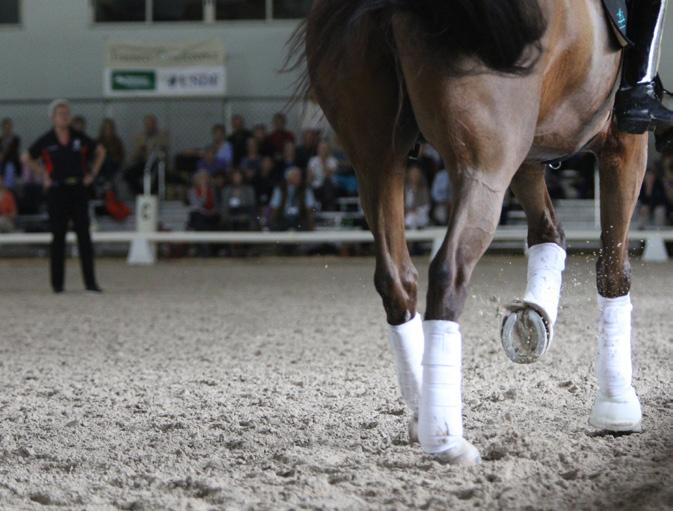
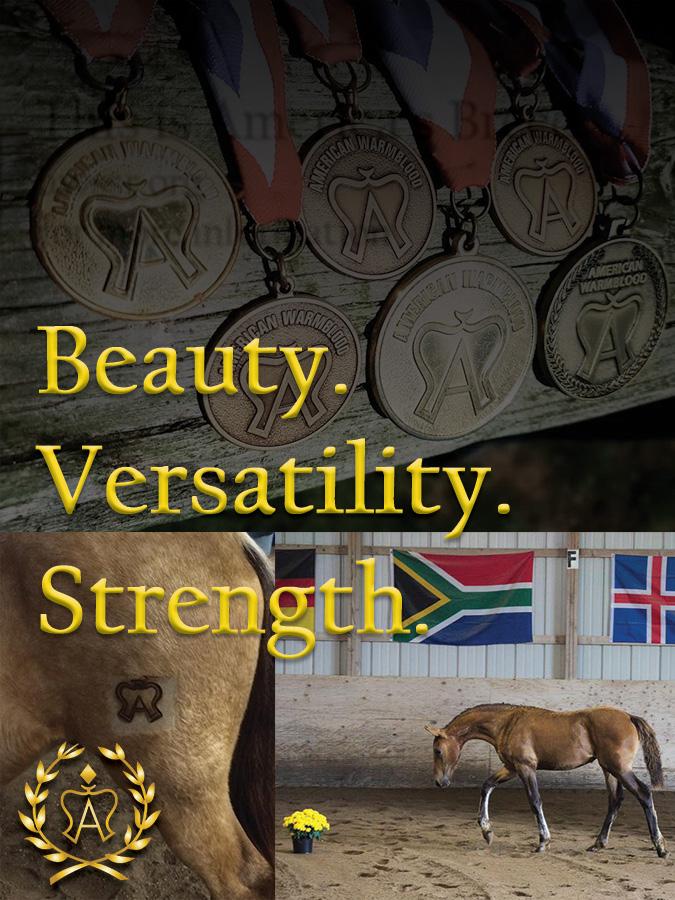

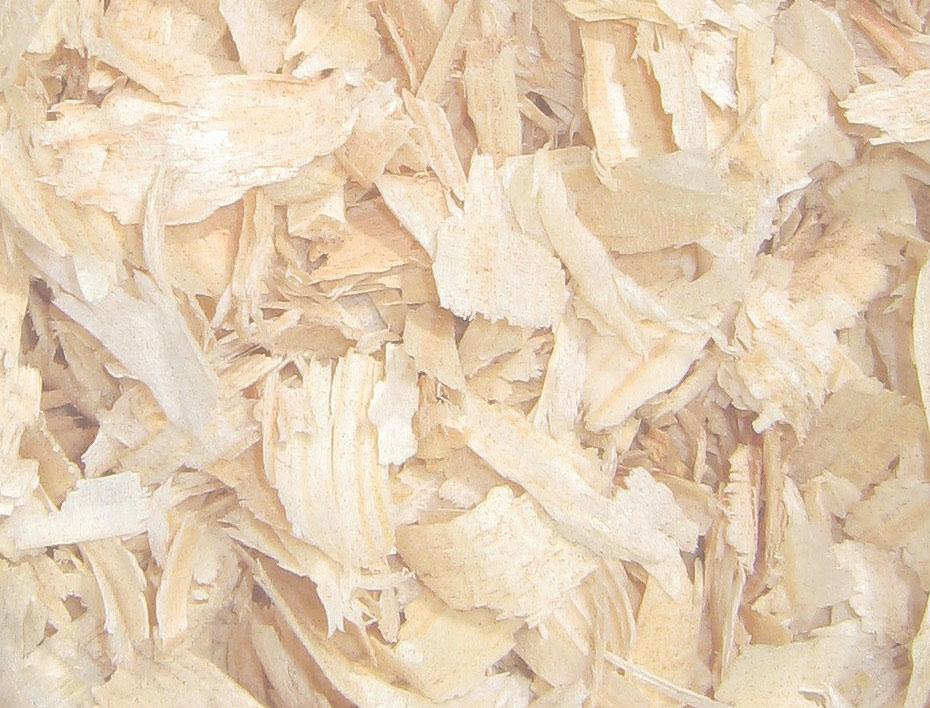
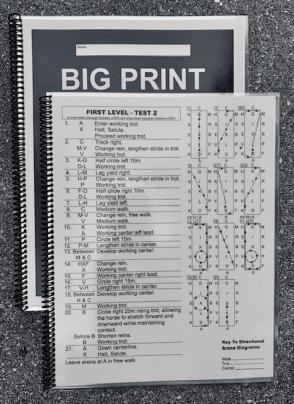








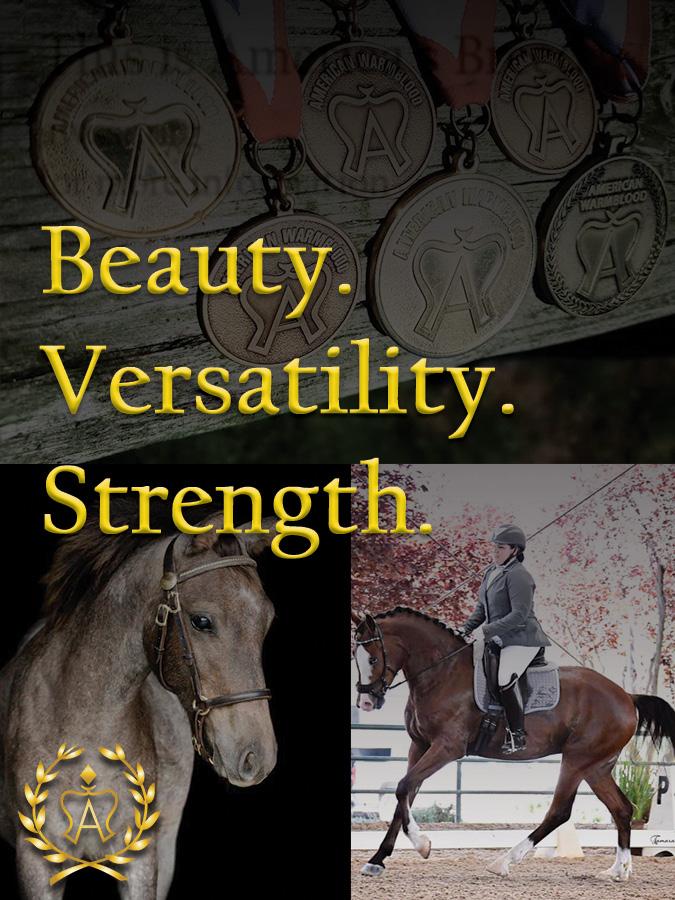

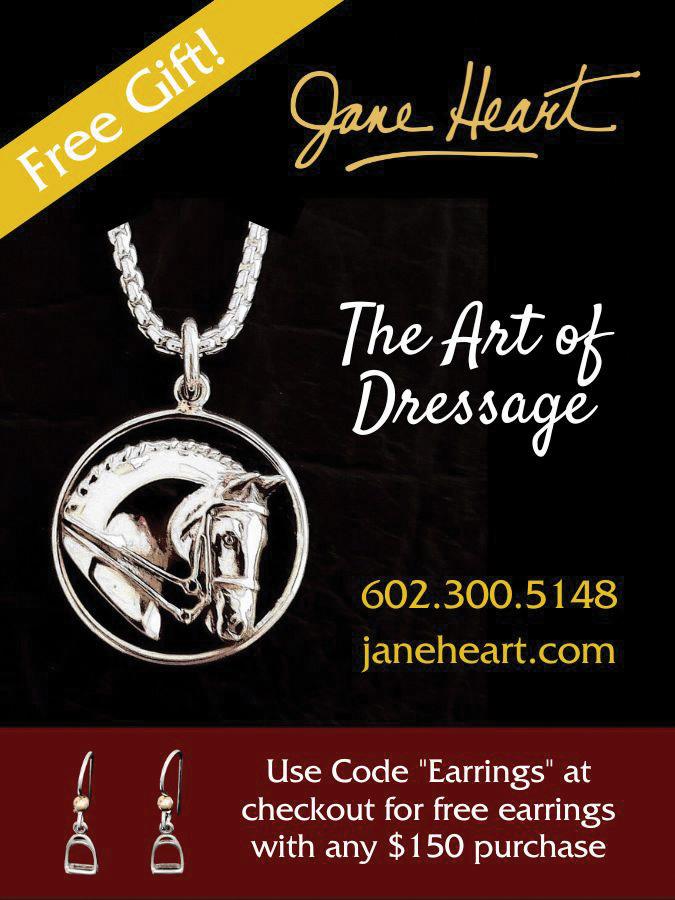



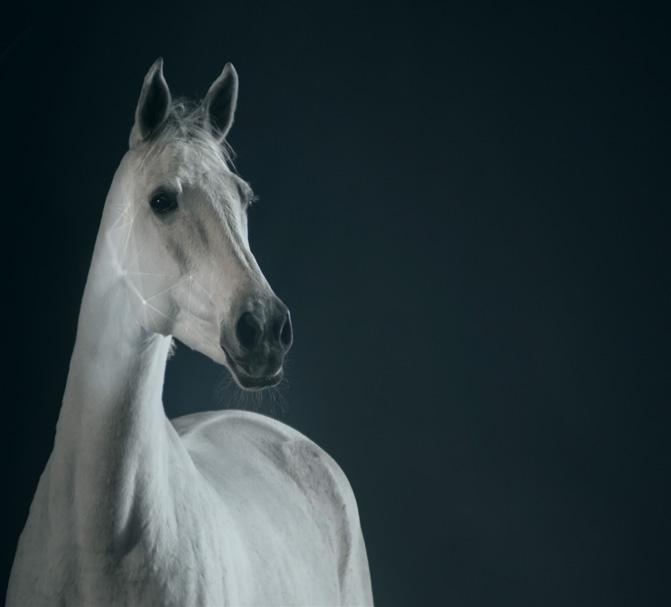

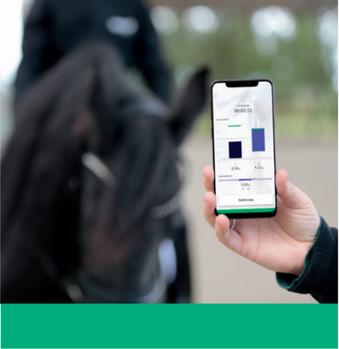
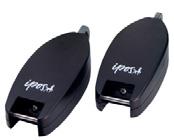


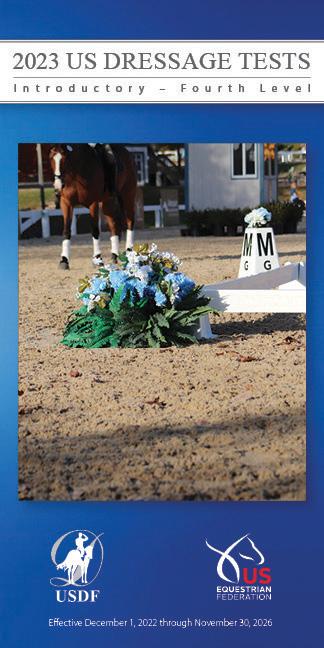
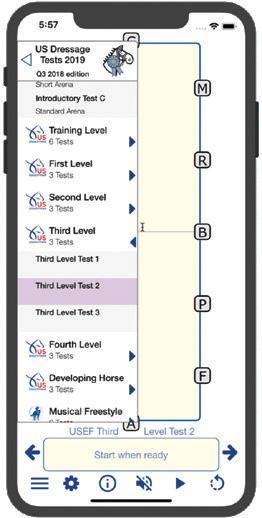

Phone: (859) 971-2277, Fax: (859) 971-7722, E-mail: usdressage@usdf.org
Accounting (859) 271-7891 accounting@usdf.org
Address and E-mail Updates (859) 971-2277 changes@usdf.org
Adult Education Programs
All-Breeds Awards
(859) 271-7894 ......................... education@usdf.org
(859) 971-7361 ............................ allbreeds@usdf.org
Applications Submitted at Competitions ................................ (859) 271-7880........................... affidavits@usdf.org
Breeder Championship Series (859) 271-7878 sporthorse@usdf.org
Demographics and Statistics (859) 271-7083 stats@usdf.org
Donations (859) 971-7826 donate@usdf.org
FEI Youth Clinics (859) 971-7317 jryrclinics@usdf.org
GMO Education Initiative (859) 271-7894 education@usdf.org
Group Membership (859) 971-7048 gmo@usdf.org
Hall of Fame and Lifetime Achievement Awards ................. (859) 271-7873 ........................ halloffame@usdf.org
Horse Performance Certificates ............................................... (859) 971-7361 .......... horseperformance@usdf.org
Horse Registration (859) 271-7880 horseregistration@usdf.org
Human Resources/Career Opportunities (859) 271-7885 hr@usdf.org
Instructor Certification (859) 271-7877 instructorcertification@usdf.org
Insurance Certificates for Competitions (859) 271-7886 compins@usdf.org
L Education and Continuing Education (859) 971-7039 lprogram@usdf.org
Licensed Official Education (859)-271-7877 loeducation@usdf.org
Mailing Lists.................................................................................... (859) 971-7038......................... mailinglist@usdf.org
Musical Freestyle .......................................................................... (859) 971-7039..............musicalfreestyle@usdf.org
NAYC Criteria and Procedures (859) 971-7317 nayc@usdf.org
Nominations – Delegates, Regional Directors (859) 271-7897 nominations@usdf.org
Participating and Business Memberships (859) 271-7871 membership@usdf.org
Prize List Questions (859) 271-7896 prizelist@usdf.org
Regional Championships Program (859) 271-7886 regchamps@usdf.org
Rider Awards (859) 971-7361 riderawards@usdf.org
Safe Sport ....................................................................................... (859)-271-7894...........................safesport@usdf.org
Score Corrections......................................................................... (859) 271-7895............ scorecorrections@usdf.org
Secretary/Manager Services
(859) 271-7895.................... competitions@usdf.org
Show Results (859) 271-7895 results@usdf.org
Sponsorship Opportunities (859) 271-7887 sponsorship@usdf.org
Sport Horse Education and Programs (859) 271-7894 sporthorse@usdf.org
Store Merchandise (859) 971-7828 merchandise@usdf.org
University Accreditation and Credit Check (859) 271-7894 university@usdf.org

USDFScores.com (859) 271-7878 reports@usdf.org
USEF/USDF Dressage Seat Medal Program & Semi-Finals ...(859)-971-7886....................................... youth@usdf.org
Year-End Awards .......................................................................... (859) 971-7361 ................................awards@usdf.org
Young Rider Graduate Program (859) 971-7317 youth@usdf.org
Youth Education and Programs (859) 971-7317 youth@usdf.org
For specific staff contacts visit the USDF Web site.
USDF Connection wants YOU to be a contributor. Here’s how.
USDF Connection welcomes letters to the editor. Please send your digital submission by e-mail to jbryant@ usdf.org. Please include your hometown, state, and daytime telephone number. We’ll publish letters as space allows; all submissions are subject to editing. Unsigned letters will not be considered, although writers may request that their names be withheld. All letters become the property of USDF.
Do you have a dressage- or USDFrelated question? Send it to “FAQ” and you may get an expert response in a future issue of USDF Connection.

Send your question, along with your full name, hometown, state, and daytime telephone number to editorial@usdf.org. Include “FAQ” in the subject line of your message.

Arenus arenus.com 7, 17
Auburn Laboratories, Inc. ............................................... auburnlabs.com ........................................ 25
American Warmblood Society & Sporthorse Registry ... awssr.org .........................................................68
Challenge of the Americas
challengeoftheamericas.com .................. 31
Equine Design stradi.us 68
Great American Insurance Group
Hilltop Farm
IPOS Technology
greatamericaninsurancegroup.com........ 9
Iron Spring Farm ironspringfarm.com 5
Jane Heart Jewelry
janeheart.com............................................ 68
Kentucky Performance Products.................................... kppusa.com..................... inside front cover
Lemke Saddle Services
Lindinhof Equine Sports Zentrum
lindinhof.com ............................................. 68
Platinum Performance ...................................................... platinumperformance.com....... back cover
Rider Project ....................................................................... theriderproject.org ................................... 68
Shooting Star Farm shootingstarfarm.com 69
Sox For Horses ................................................................... soxforhorses.com ..................................... 8 Sporthorse Auctions.com ................................................ sporthorseauctions.com .......................... 68
Susan J. Stickle Photography
Leading the USDF has not always been easy. Two past (and current) presidents reflect on their greatest challenges, past, present, and future
 By Sam Barish and George Williams
By Sam Barish and George Williams
Sam Barish, president, 20002009: My greatest challenges centered around moving USDF’s headquarters from its original home in Lincoln, Nebraska, to the Kentucky Horse Park in Lexington, the achievement of which I am most proud.
Those challenges included raising more than $4.2 million in the capital campaign for the USDF National Education Center. Then, we completed the building construction on schedule and at substantially less cost than budgeted. As a result, USDF’s mortgage was paid off in five years and we did not incur costs for rent, meaning that those funds instead could be devoted to education and competition programs.
The move to the Kentucky Horse Park was accomplished by 1) establishing a relocation committee to determine whether it was in USDF’s best interest to relocate to Lexington, 2) hiring a fund-raising consulting firm to guide USDF through the capital campaign, since the Federation had never conducted a major fund-raising effort, and 3) assigning executive director Stephan Hienzsch to oversee the building project.
For the next 50 years, I hope that USDF will find the right balance between education and competition, as well as between the interests and needs of junior/young riders, adult amateurs, and professionals.
Listening to USDF members will help to determine the proper balance.
George Williams, president, 2010-2018 and 2022-: Let me start by saying that my nine years as president were sandwiched between those of Sam Barish—who had to construct a headquarters building and move the USDF offices to Kentucky—and Lisa Gorretta, who had to steer and navigate the USDF through a pandemic.
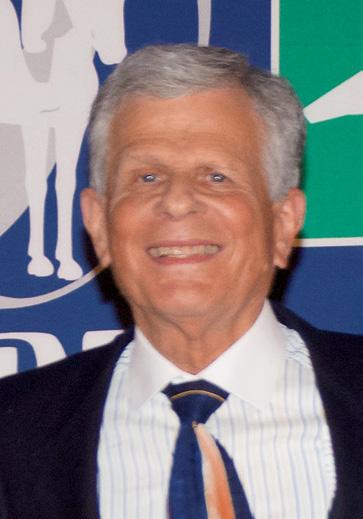
I don’t think I have faced anything that compares with the challenges they took on so incredibly well.
I inherited a strong staff that helped us get through some tough times. Obviously, I had a lot of trepidation as to whether the naysayers would be right regarding the US Dressage Finals, but I was comforted knowing that lead organizer Janine Malone would be instrumental in helping to bring them to fruition. The Finals debuted in 2013 and were an immediate success.
I was also fortunate that there was a great dressage staff in place at US Equestrian, and the two organizations were able to develop a very good, cooperative relationship.
The things that I see as challenges for the USDF are ongoing. During my time in office, the USDF was the first major affiliate to sign an agreement with US Equestrian.
In that agreement, the USDF took on the duty of educating all national dressage licensed officials. This is a huge responsibility, for it can have an incredible impact on the future of our sport. Especially with the looming possibility of a federally mandated coaching program for all sports within the Olympic movement, it is vital for the USDF to continue to look at instructor/ trainer education and certification. Both licensed-officials education and instructor certification require a major investment of resources and expertise to keep them relevant in terms of educational materials and oversight.
Perhaps the most pressing need we have concerns leadership development. There needs to be a volunteer-leadership “pipeline.” I believe that USDF has to find a way to attract younger volunteers, first on the regional level, and later to USDF committee positions and ultimately to the USDF Executive Board. Then, down the road, is it in our best interest for the USDF to be run entirely by a professional staff? The way I see it, many of our programs have grown organically: Someone sees a need, has an idea, a seed is planted, and in the end a mix of volunteers and staff members nurture the program and help it grow. In other words, we need both—a good professional staff and a group of engaged, creative, enthusiastic, energetic volunteers to keep the USDF the number-one “go to” national organization for dressage.



































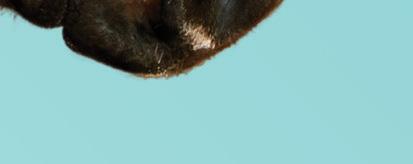




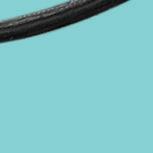









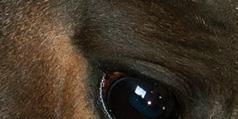

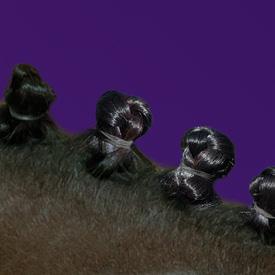


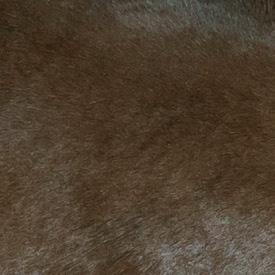
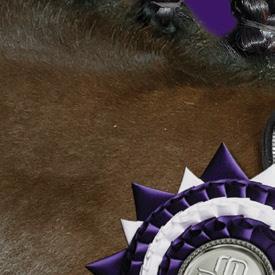
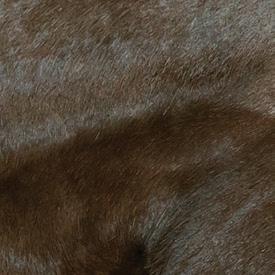

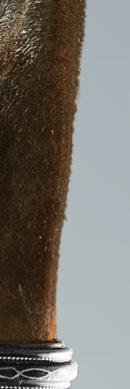
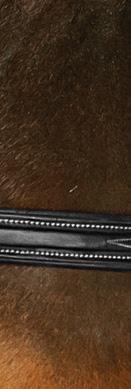



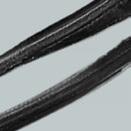

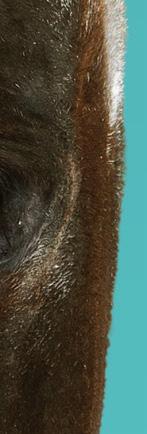

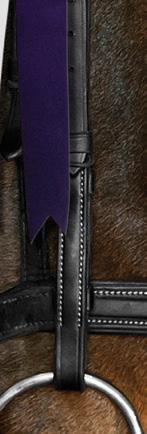

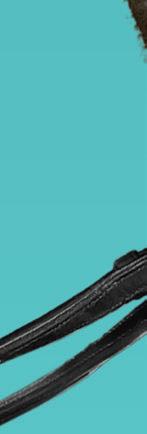





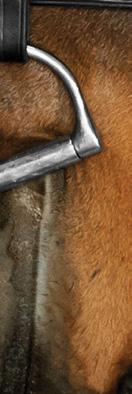



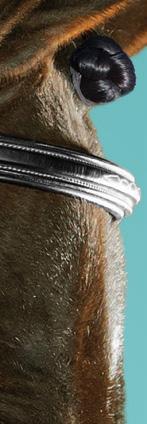
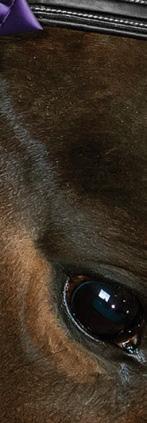
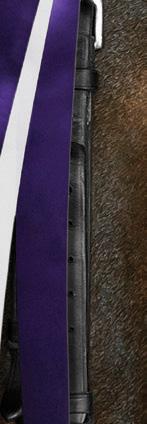
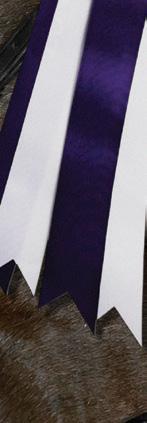


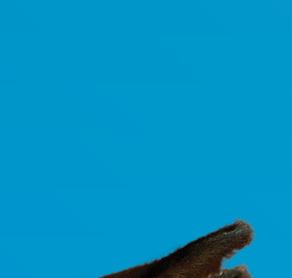

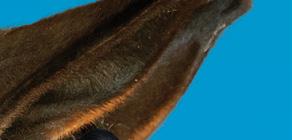


















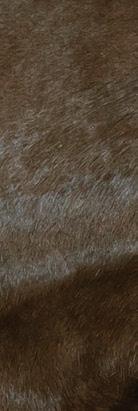



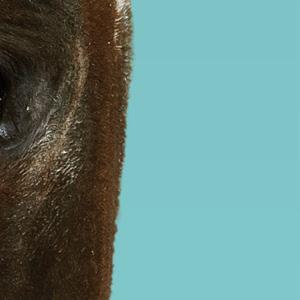
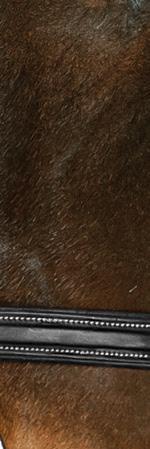

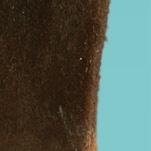





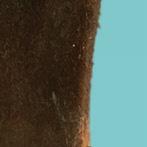
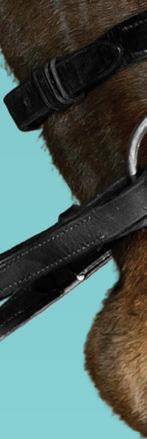
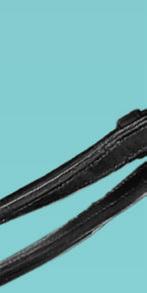
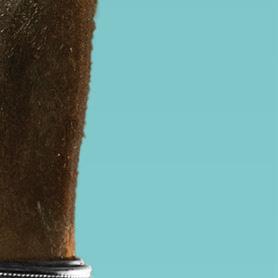


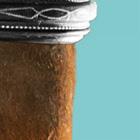




















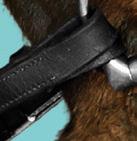

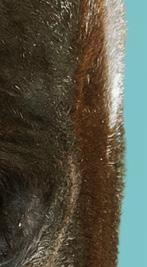
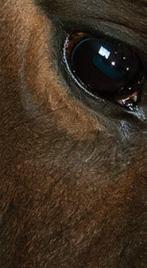

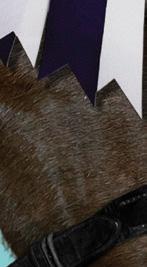



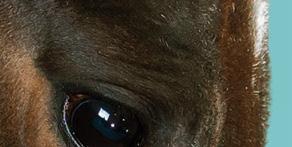
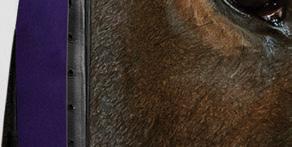
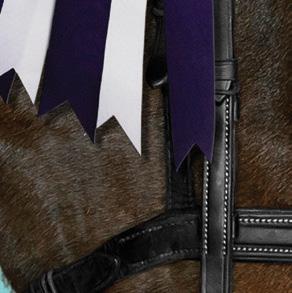

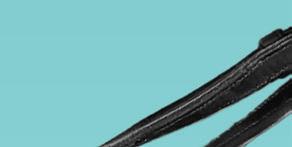






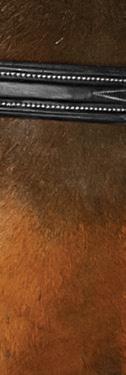

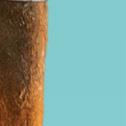
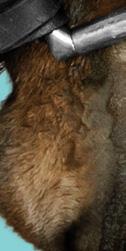

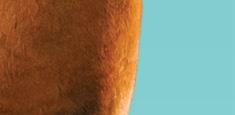
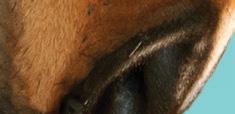


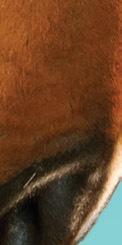
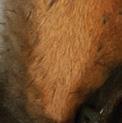



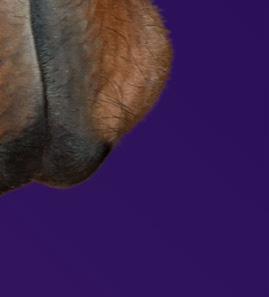



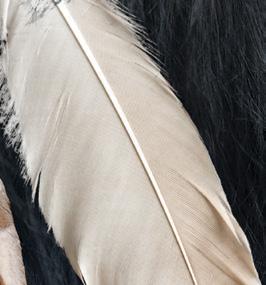


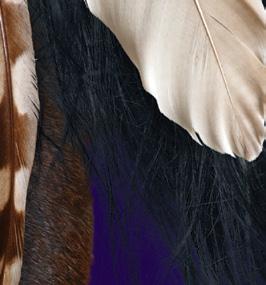





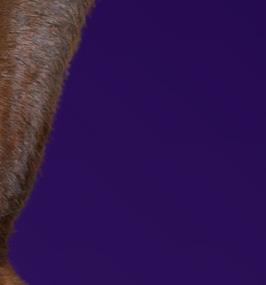

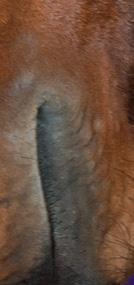




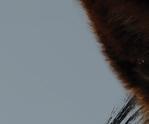






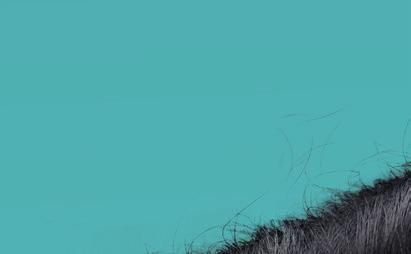



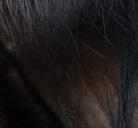
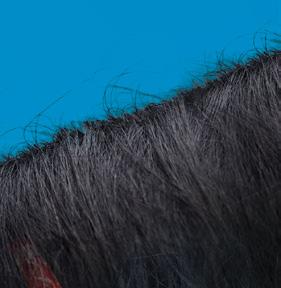













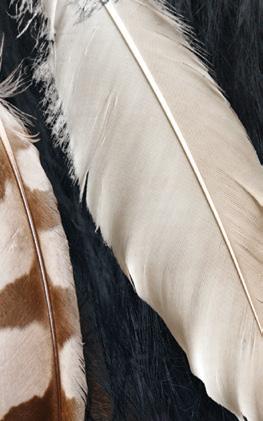


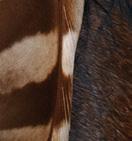












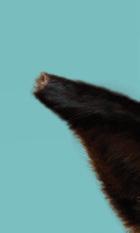


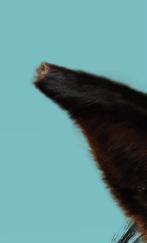







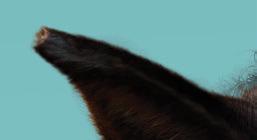


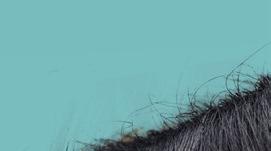
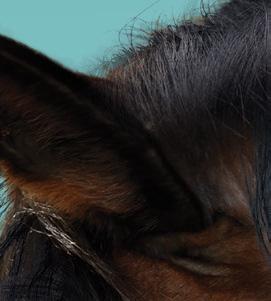




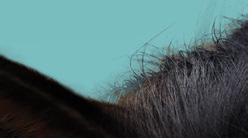
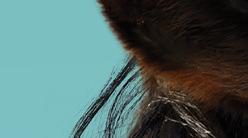

Platinum Performance® Equine supports every aspect of horse health, including joints, muscles, hooves, skin and coat, digestion and more for a comprehensive approach to equine health and wellness in one bucket.
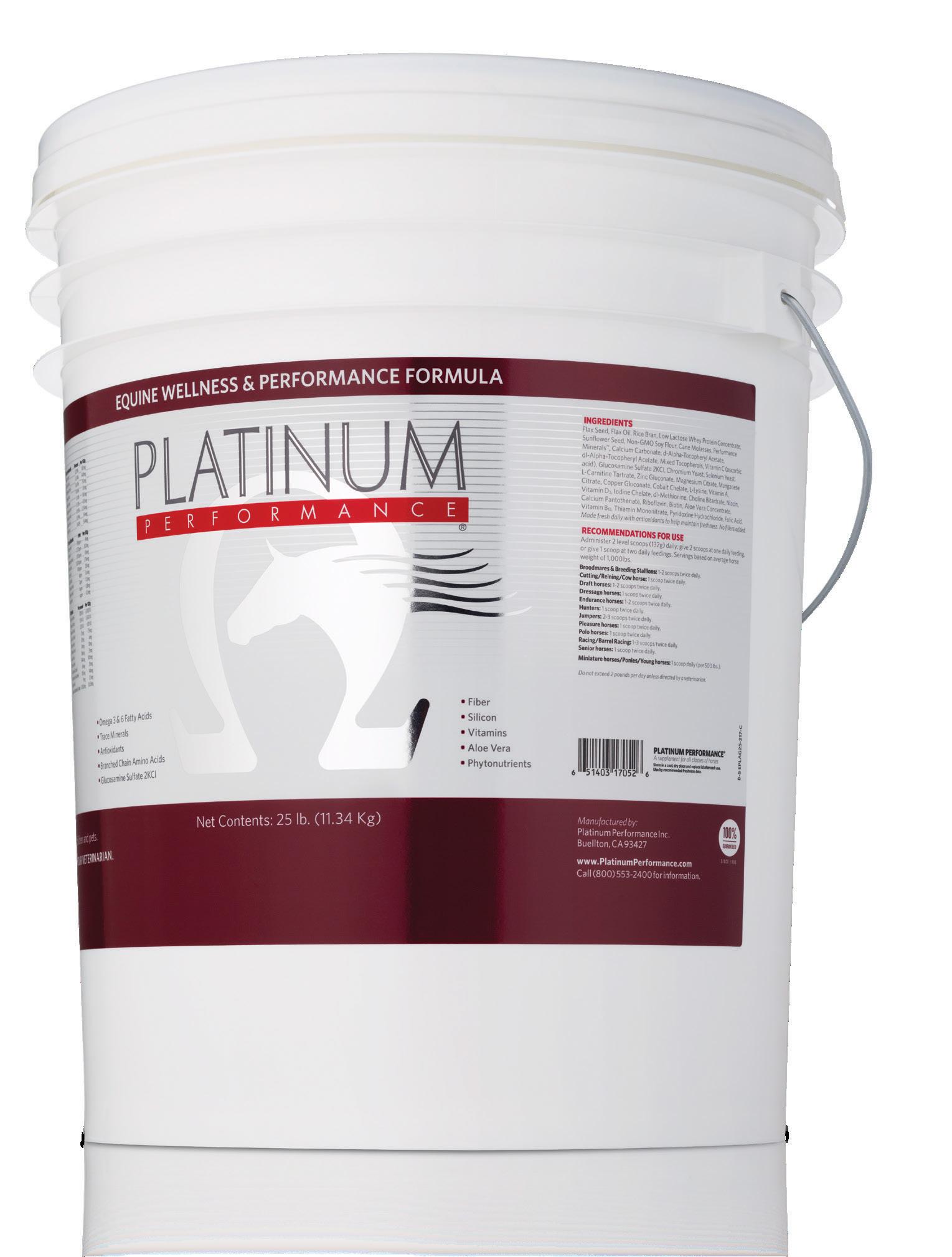
To ensure results, Platinum Performance® formulas are developed by veterinarians based on university research and clinical trials. Numerous studies have confirmed the effectiveness of Platinum Performance® formulas.
Ingredients are selected based on quality and efficacy over low-cost options, ensuring formula protection, potency and purity. Platinum formulas are tested extensively for banned substances for athlete protection.
Platinum Advisors are experienced horse owners who can help you find answers and resources for your questions.
Created by an equine veterinarian out of clinical necessity, Platinum Performance® Equine is a comprehensive wellness formula developed to transform health at the cellular level. University studies have shown that the expertly-sourced ingredients work synergistically to support many aspects of wellness and performance, eliminating the need to feed a variety of different supplements Platinum formulas are only available from your veterinarian or direct from Platinum Performance®